Under each image, you’ll find a text transcription of its relevant content, making it easy to copy and extract for your own analysis or verification.
Raw Markdown text-only version: www.1stBitcoinMiner.com/transcriptions.md

- Extract the data I used
- Find errors
- Falsify my claims
During this research, a lot of time was spent extracting and organizing data from the sources. I hope this page saves you that time — “be the change you want to see in the world.” :)
Since I used LLMs extensively in this work — from formatting text to structuring information and finding sources — it’s only right to make my research just as accessible for those who use LLMs.
💡 Tip: If you do not understand something, just copy the text & paste into an LLM and ask it questions.
And it’s not only for LLM users — these transcriptions also make the content accessible for people with disabilities who rely on tools that convert images to text, avoiding the extra steps and errors that often come with OCR conversions.
I conducted a 3.5-month forensic investigation into Bitcoin’s very early days, and this led me to discover the following never-before-known facts about Bitcoin’s launch:
- Hal Finney missed Bitcoin’s launch
- Hal Finney joined the Bitcoin network around Block 49
- There were 2 nodes online when Hal joined ; both were Satoshi Nakamoto
- The Bitcoin network halted for 24 hours and 8 hours in the first 30 blocks
- In total, Bitcoin halted 8 times in the first 170 blocks
The research shows how close Bitcoin came to not taking off at all, and without Hal Finney and Dustin Trammell, it might have quietly disappeared.
But more importantly it allowed me to paint a vivid picture of what it must have been like to be one of the first people to use Bitcoin.
Most people know Hal Finney from the famous “Running Bitcoin Tweet” he made in January 2009.
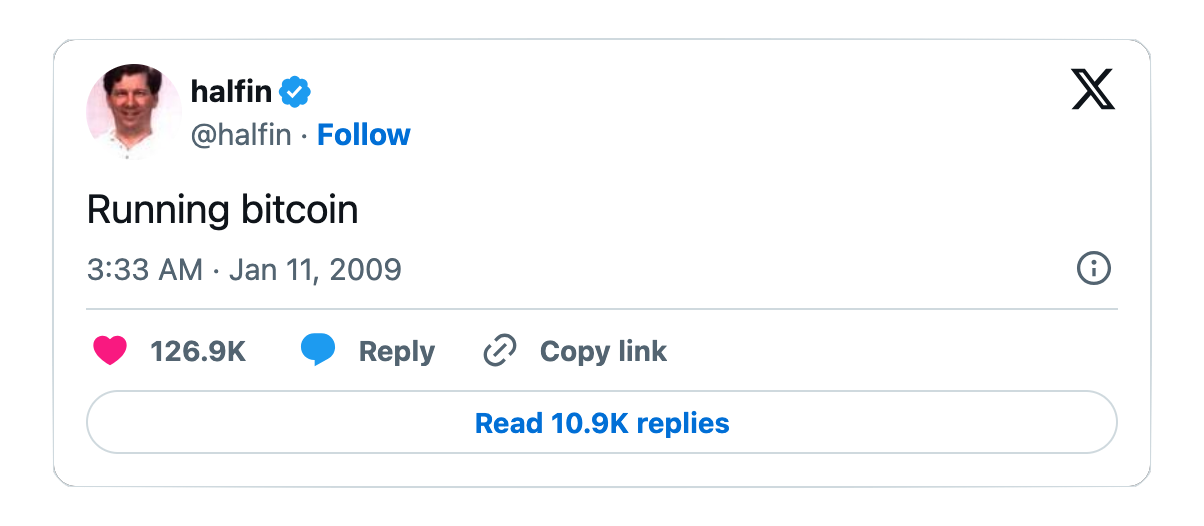
[Transcription of Hal Finney's tweet January 11 2009]
halfin @halfin
Running bitcoin
3:33 AM · Jan 11, 2009
Considering that:
- the tweet was made close to the launch of Bitcoin
- it is kind of the only historical Bitcoin relic (outside the Cryptography Mailing List) from that time
- Hal was a very well-known and prolific cryptographer who worked on PGP and even created his own cryptocurrency RPOW
- Hal had known private conversations (which he later released) with Satoshi Nakamoto between the launch of the Whitepaper and the launch of Bitcoin
- Hal mentioned in one Bitcointalk post, he may have been the 1st person to join the Bitcoin Network after Satoshi Nakamoto
- Hal was the 1st developer to be added to SourceForge by Satoshi Nakamoto
People automatically presumed Hal was the 2nd person to join the Bitcoin Network, right after Satoshi Nakamoto.
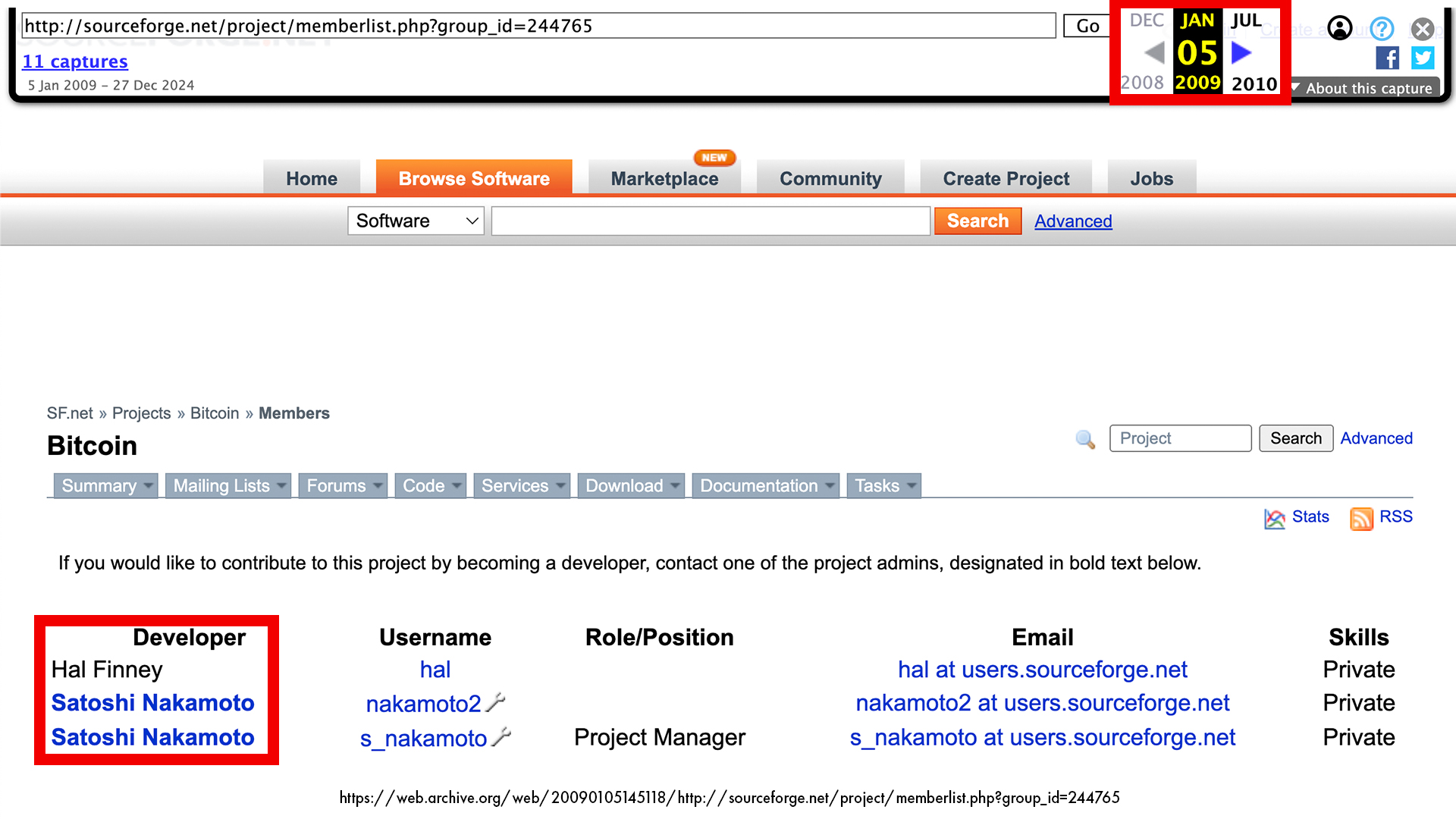
Note: Transcription of SourceForge screenshoot January 5 2009
| Developer | Username | Role/Position | Skills | |
|---|---|---|---|---|
| Hal Finney | hal | hal at users.sourceforge.net | Private | |
| Satoshi Nakamoto | nakamoto2 | Project Admin | nakamoto2 at users.sourceforge.net | Private |
| Satoshi Nakamoto | s_nakamoto | Project Admin, Project Manager | s_nakamoto at users.sourceforge.net | Private |
In the screenshot above — a snapshot from January 5th, 2009 — we can see Hal Finney listed as the only other developer on the Bitcoin project on SourceForge alongside Satoshi Nakamoto. Bitcoin was announced on the 8th.
Today, the idea that Hal was the second person to join the Bitcoin network is considered a well-known fact: thousands of articles have been written about it, and Bitcoiners celebrate Hal’s tweet every year.
While this is a very reasonable presumption, I wanted to find some concrete proof, but I couldn’t find anything on the topic, so I decided to conduct my own investigation.
First, I decided to gather all the events that led to the Bitcoin launch and Hal’s tweet, and convert them to the same time zone to make comparison easier. UTC was the best choice, since Bitcoin block timestamps are also recorded in UTC.
For easier reading, I will present screenshots of each relevant event, highlighting key details with red squares and arrows. Below each image, you’ll find a plain-text equivalent in the form of a code block or table, making the content easier to scrape. This way, you won’t need to switch between tabs—all the information is available directly within the article.
Below each screenshot, after the plain-text equivalent, I will also include the official source, so you can verify that I didn’t make anything up — and if I made an error, you can catch it.
If, for any reason, the original websites are no longer available, try checking web.archive.org or archive.ph. I’ve personally backed up every link mentioned in the article.
The “Running Bitcoin” Tweet.
We know that the time zone used by X (Twitter) is UTC because, if we inspect the website’s source code, we can see a timestamp 2009-01-11T03:33:52.000Z = Sunday, 11 January 2009 03:33:52. The “Z” stands for Zulu time, which is UTC+0000.
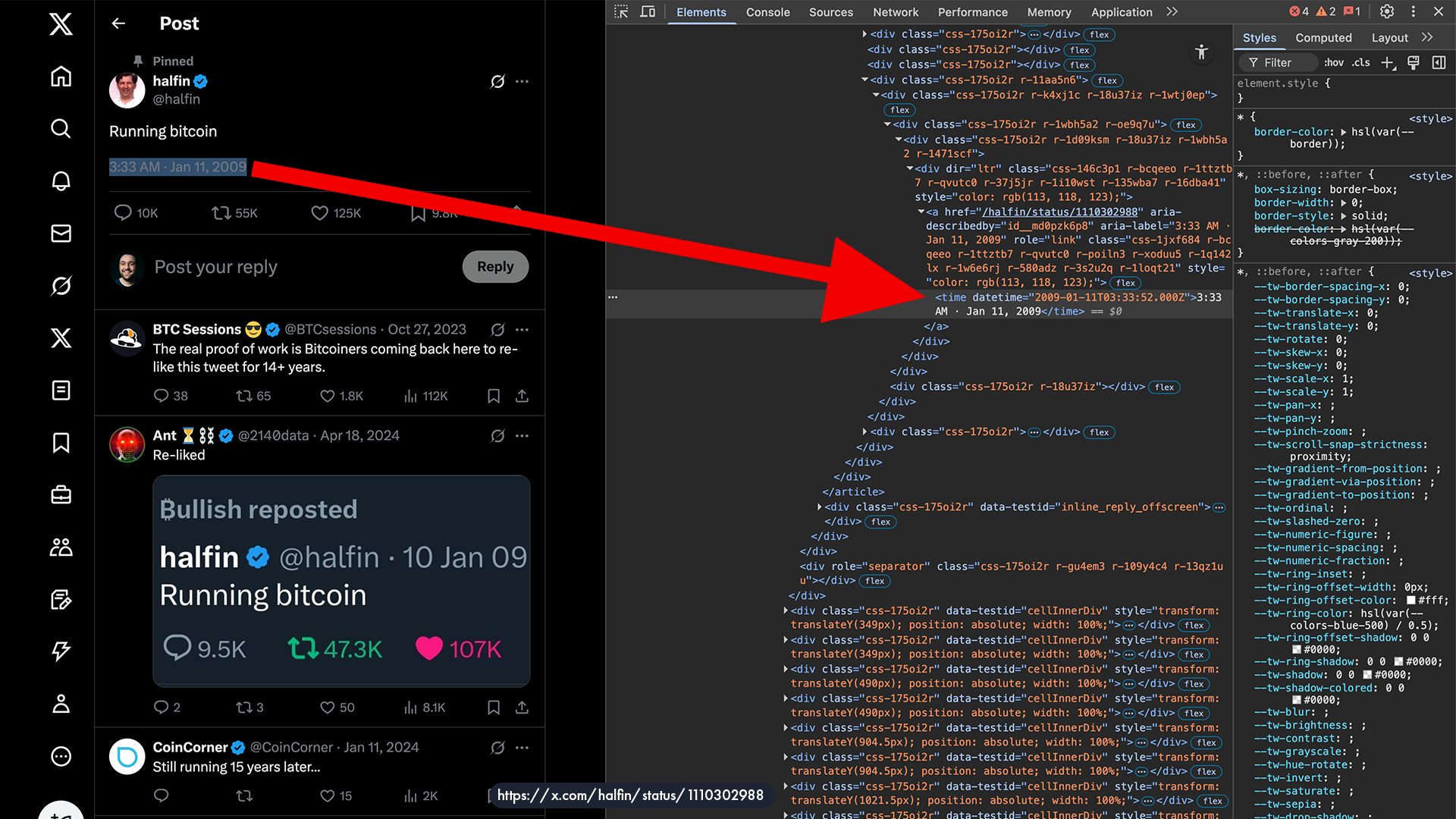
<!-- attribute from inspect element -->
<a href="/halfin/status/1110302988" aria-describedby="id__nej6l96m0bk" aria-label="3:33 AM · Jan 11, 2009" role="link" class="css-1jxf684 r-bcqeeo r-1ttztb7 r-qvutc0 r-poiln3 r-xoduu5 r-1q142lx r-1w6e6rj r-9aw3ui r-3s2u2q r-1loqt21" style="color: rgb(113, 118, 123);">
<time datetime="2009-01-11T03:33:52.000Z">3:33 AM · Jan 11, 2009</time></a>
Source: https://x.com/halfin/status/1110302988
Now let’s go back in time a bit.
Hal Finney’s Responses to Satoshi Nakamoto on the Cryptography Mailing List
Satoshi made himself publicly known to the world a few months before Hal’s tweet, when he published the Bitcoin Whitepaper on the Cryptography Mailing List on: Fri Oct 31 14:10:00 EDT 2008
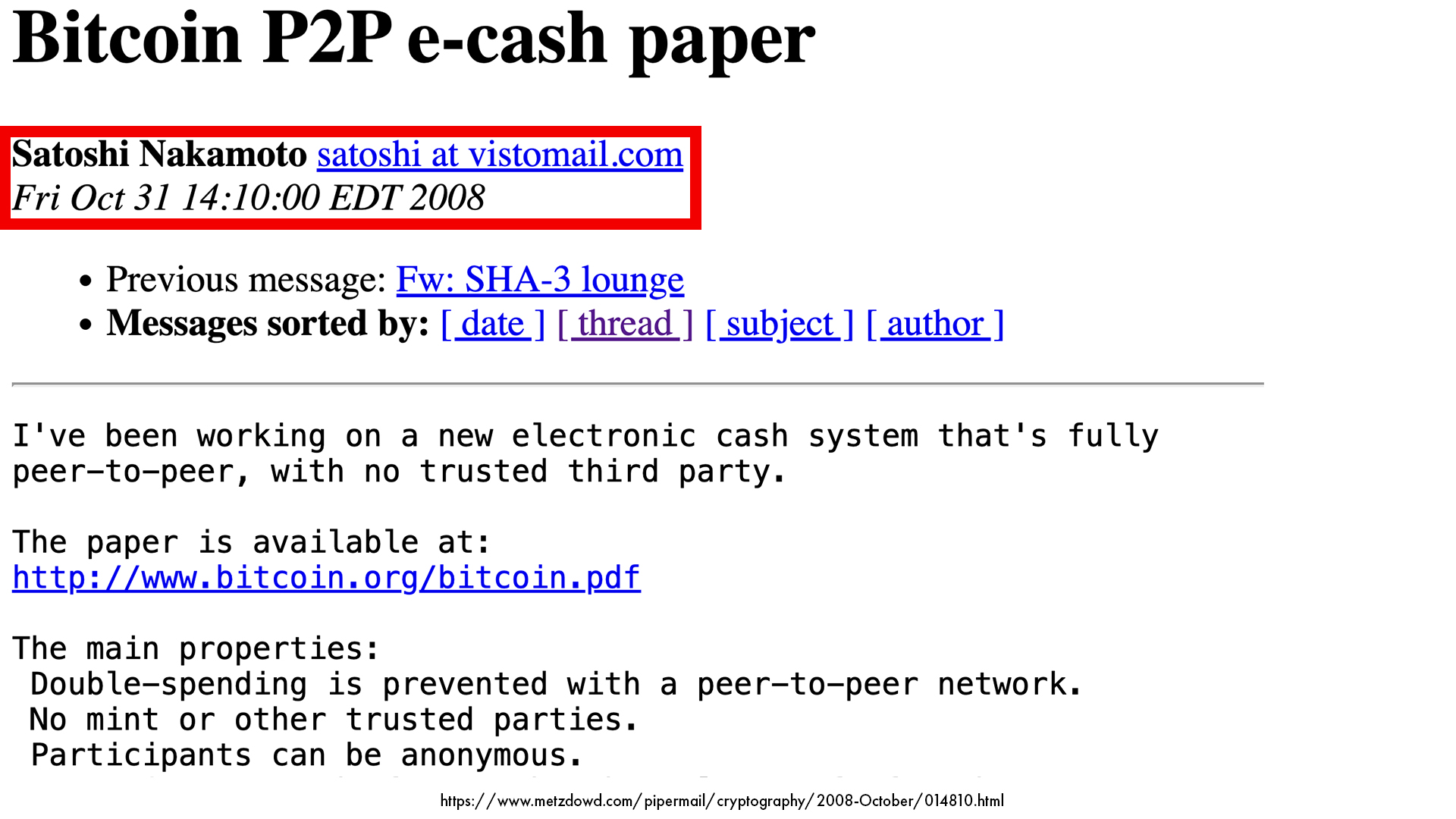
[Transcription of Cryptography Mailing List Post Bitcoin P2P e-cash paper]
Bitcoin P2P e-cash paper
Satoshi Nakamoto satoshi at vistomail.com
Fri Oct 31 14:10:00 EDT 2008
Previous message: Fw: SHA-3 lounge
Messages sorted by: [ date ] [ thread ] [ subject ] [ author ]
I've been working on a new electronic cash system that's fully
peer-to-peer, with no trusted third party.
The paper is available at:
http://www.bitcoin.org/bitcoin.pdf
The main properties:
Double-spending is prevented with a peer-to-peer network.
No mint or other trusted parties.
Participants can be anonymous.
Source: https://www.metzdowd.com/pipermail/cryptography/2008-October/014810.html
Before the Bitcoin whitepaper announcement, Satoshi exchanged a few private emails with Adam Back and Wei Dai, since he referenced both of their earlier work in the whitepaper. He contacted them to confirm that he had cited the correct sources. So technically, this was the first time the world heard of Satoshi Nakamoto — but that’s not relevant to what we’re looking at here.
Very few people took interest in Satoshi’s whitepaper, and Hal was one of them — replying to Satoshi’s posts on the Cryptography Mailing List.
The 1st reply was on Fri Nov 7 18:40:12 EST 2008.
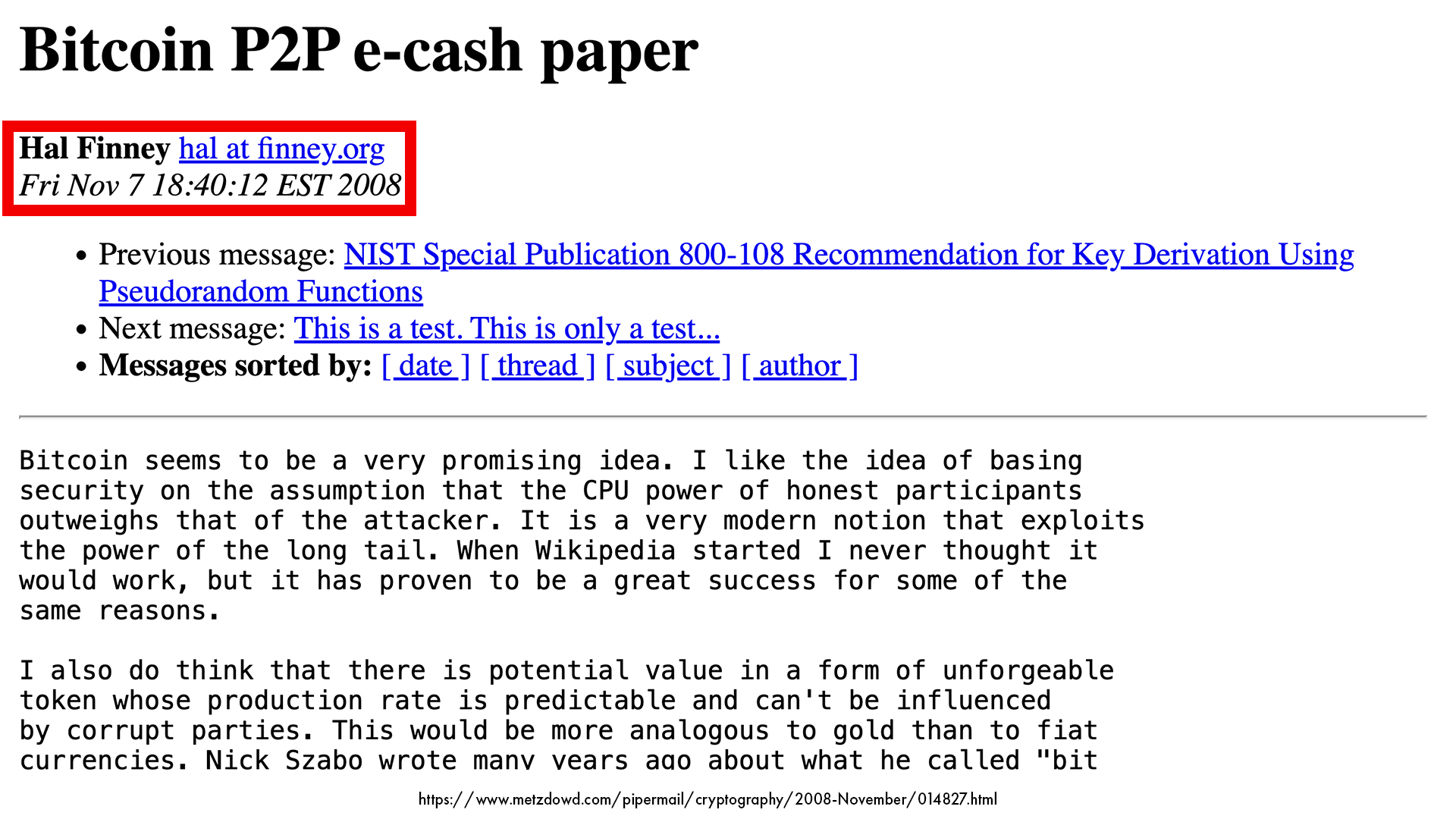
[Transcription of Cryptography Mailing List Reply to Bitcoin P2P e-cash paper]
Bitcoin P2P e-cash paper
Hal Finney hal at finney.org
Fri Nov 7 18:40:12 EST 2008
Previous message: NIST Special Publication 800-108 Recommendation for Key Derivation Using Pseudorandom Functions
Next message: This is a test. This is only a test...
Messages sorted by: [ date ] [ thread ] [ subject ] [ author ]
Bitcoin seems to be a very promising idea. I like the idea of basing
security on the assumption that the CPU power of honest participants
outweighs that of the attacker. It is a very modern notion that exploits
the power of the long tail. When Wikipedia started I never thought it
would work, but it has proven to be a great success for some of the
same reasons.
I also do think that there is potential value in a form of unforgeable
token whose production rate is predictable and can't be influenced
by corrupt parties. This would be more analogous to gold than to fiat
currencies. Nick Szabo wrote many years ago about what he called "bit
gold"[1]
Source: https://www.metzdowd.com/pipermail/cryptography/2008-November/014827.html
And the 2nd on Thu Nov 13 11:24:18 EST 2008.
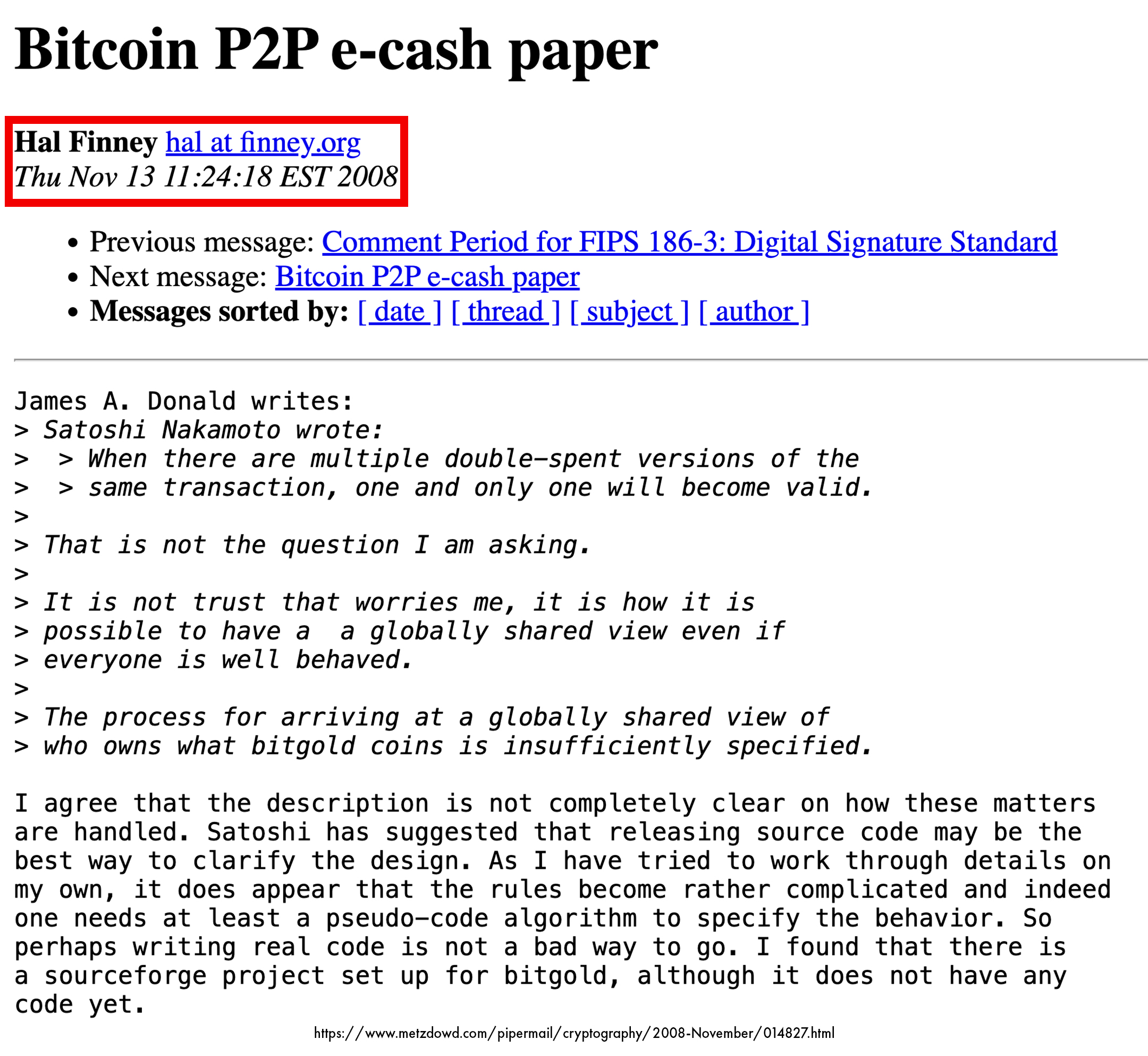
[Transcription of Cryptography Mailing List Reply to Bitcoin P2P e-cash paper]
Bitcoin P2P e-cash paper
Hal Finney hal at finney.org
Thu Nov 13 11:24:18 EST 2008
Previous message: Comment Period for FIPS 186-3: Digital Signature Standard
Next message: Bitcoin P2P e-cash paper
Messages sorted by: [ date ] [ thread ] [ subject ] [ author ]
James A. Donald writes:
> Satoshi Nakamoto wrote:
> > When there are multiple double-spent versions of the
> > same transaction, one and only one will become valid.
>
> That is not the question I am asking.
>
> It is not trust that worries me, it is how it is
> possible to have a a globally shared view even if
> everyone is well behaved.
>
> The process for arriving at a globally shared view of
> who owns what bitgold coins is insufficiently specified.
I agree that the description is not completely clear on how these matters
are handled. Satoshi has suggested that releasing source code may be the
best way to clarify the design. As I have tried to work through details on
my own, it does appear that the rules become rather complicated and indeed
one needs at least a pseudo-code algorithm to specify the behavior. So
perhaps writing real code is not a bad way to go. I found that there is
a sourceforge project set up for bitgold, although it does not have any
code yet.
Source: https://www.metzdowd.com/pipermail/cryptography/2008-November/014848.html
From these two posts, we know Hal Finney was immediately interested in Bitcoin.
Not long after Satoshi announced the Bitcoin whitepaper, Hal, Satoshi, and others began conversing in private. We have access to these private conversations thanks to a CoinDesk article that — coincidentally — also focuses on timestamps, though for a different topic: https://www.coindesk.com/markets/2020/11/26/previously-unpublished-emails-of-satoshi-nakamoto-present-a-new-puzzle
According to the editor’s note in the article, Fran Finney (Hal’s wife) confirmed that the emails are authentic.
The first email in the CoinDesk article is dated 19 November 2008 (around the time of the whitepaper release). It does confirm the beginning of the private conversations, but it’s not relevant to our investigation.
So let’s fast forward to Satoshi announcing Bitcoin v0.1 to the Cryptography Mailing List on: Thu Jan 8 14:27:40 EST 2009 ⭢ Thursday, 8 January 2009 19:27:40 UTC
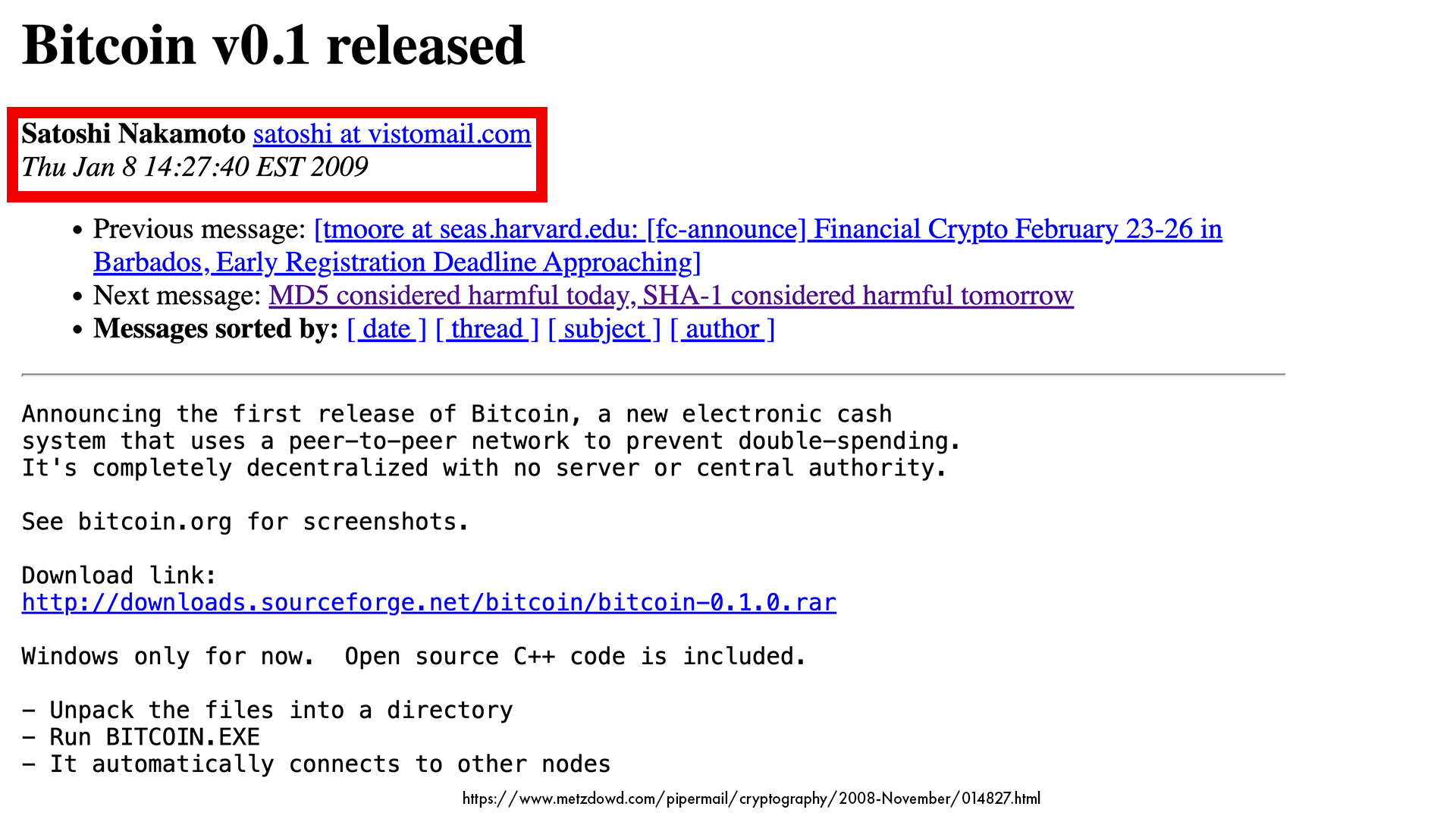
[Transcription of Cryptography Mailing List Post Bitcoin v0.1 released]
Bitcoin v0.1 released
Satoshi Nakamoto satoshi at vistomail.com
Thu Jan 8 14:27:40 EST 2009
Previous message: [tmoore at seas.harvard.edu: [fc-announce] Financial Crypto February 23-26 in Barbados, Early Registration Deadline Approaching]
Next message: MD5 considered harmful today, SHA-1 considered harmful tomorrow
Messages sorted by: [ date ] [ thread ] [ subject ] [ author ]
Announcing the first release of Bitcoin, a new electronic cash
system that uses a peer-to-peer network to prevent double-spending.
It's completely decentralized with no server or central authority.
See bitcoin.org for screenshots.
Download link:
http://downloads.sourceforge.net/bitcoin/bitcoin-0.1.0.rar
Windows only for now. Open source C++ code is included.
- Unpack the files into a directory
- Run BITCOIN.EXE
- It automatically connects to other nodes
Source: https://www.metzdowd.com/pipermail/cryptography/2009-January/014994.html
Hal Finney - Satoshi Nakamoto Private Emails(from CoinDesk)
Shortly after the announcement on the Cryptography Mailing List, Satoshi sent an email to Hal, letting him know about the “official” launch.
As the email header (from the CoinDesk article) shows, the message was received by Hal’s server on: Thu, 8 Jan 2009 20:54:55 -0800 (PST) ⭢ Friday, 9 January 2009 04:54:55 UTC
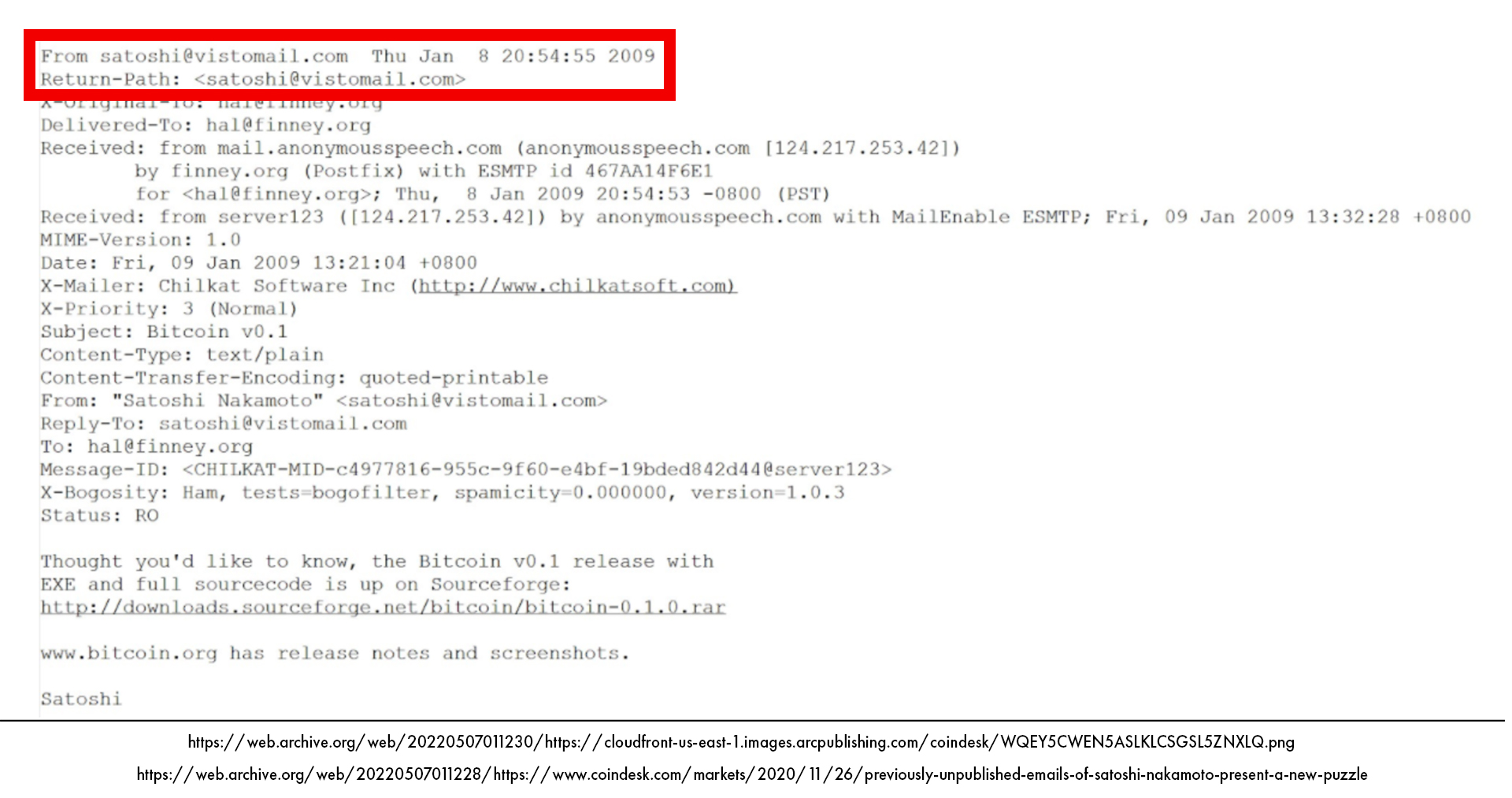
[Transcription of Satoshi - Hal Private email 1 from CoinDesk article]
From satoshi@vistomail.com Thu Jan 8 20:54:55 2009
Return-Path: <satoshi@vistomail.com>
X-Original-To: hal@finney.org
Delivered-To: hal@finney.org
Received: from mail.anonymousspeech.com (anonymousspeech.com [124.217.253.42])
by finney.org (Postfix) with ESMTP id 467AA14F6E1
for <hal@finney.org>; Thu, 8 Jan 2009 20:54:53 -0800 (PST)
Received: from server123 ([124.217.253.42]) by anonymousspeech.com with MailEnable ESMTP; Fri, 09 Jan 2009 13:32:28 +0800
MIME-Version: 1.0
Date: Fri, 09 Jan 2009 13:21:04 +0800
X-Mailer: Chilkat Software Inc (http://www.chilkatsoft.com)
X-Priority: 3 (Normal)
Subject: Bitcoin v0.1
Content-Type: text/plain
Content-Transfer-Encoding: quoted-printable
From: "Satoshi Nakamoto" <satoshi@vistomail.com>
Reply-To: satoshi@vistomail.com
To: hal@finney.org
Message-ID: <CHILKAT-MID=c4977816-955c-9f60-e4bf-19bded842d44@server123>
X-Bogosity: Ham, tests=bogofilter, spamicity=0.000000, version=1.0.3
Status: RO
Thought you'd like to know, the Bitcoin v0.1 release with
EXE and full sourcecode is up on Sourceforge:
http://downloads.sourceforge.net/bitcoin/bitcoin-0.1.0.rar
www.bitcoin.org has release notes and screenshots.
Satoshi
Source: https://cloudfront-us-east-1.images.arcpublishing.com/coindesk/WQEY5CWEN5ASLKLCSGSL5ZNXLQ.png
At some point, Hal responded to Satoshi, letting him know that he would take a look at Bitcoin over the weekend — remembering that the email was sent on a Thursday (PST).
So, from this email alone, we already know that Hal missed the Bitcoin launch.
We don’t have the timestamp for Hal’s reply (when these emails were shared, Satoshi’s responses were of more interest), but we do have another email from Satoshi letting Hal know that he was happy to answer any questions he might have, quoting Hal’s reply on: Fri, 9 Jan 2009 08:08:37 -0800 (PST) -> Friday, 9 January 2009 16:08:37 UTC
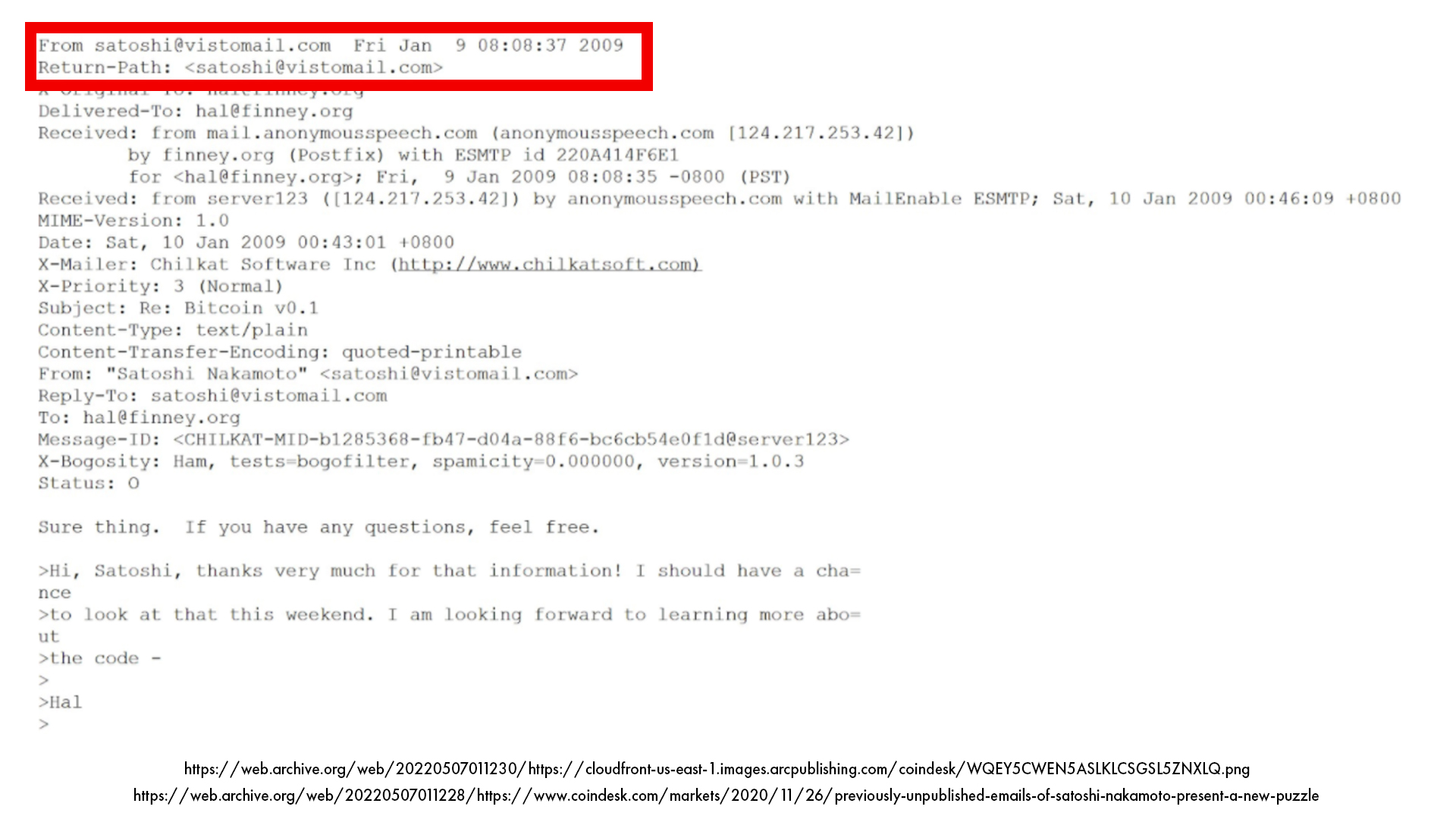
[Transcription of Satoshi - Hal Private email 2 from CoinDesk article]
From satoshi@vistomail.com Fri Jan 9 08:08:37 2009
Return-Path: <satoshi@vistomail.com>
X-Original-To: hal@finney.org
Delivered-To: hal@finney.org
Received: from mail.anonymousspeech.com (anonymousspeech.com [124.217.253.42])
by finney.org (Postfix) with ESMTP id 220A414F6E1
for <hal@finney.org>; Fri, 9 Jan 2009 08:08:35 -0800 (PST)
Received: from server123 ([124.217.253.42]) by anonymousspeech.com with MailEnable ESMTP; Sat, 10 Jan 2009 00:46:09 +0800
MIME-Version: 1.0
Date: Sat, 10 Jan 2009 00:43:01 +0800
X-Mailer: Chilkat Software Inc (http://www.chilkatsoft.com)
X-Priority: 3 (Normal)
Subject: Re: Bitcoin v0.1
Content-Type: text/plain
Content-Transfer-Encoding: quoted-printable
From: "Satoshi Nakamoto" <satoshi@vistomail.com>
Reply-To: satoshi@vistomail.com
To: hal@finney.org
Message-ID: <CHILKAT-MID=b1285368-fb47-d04a-88f6-bc6cb54e0f1d@server123>
X-Bogosity: Ham, tests=bogofilter, spamicity=0.000000, version=1.0.3
Status: O
Sure thing. If you have any questions, feel free.
>Hi, Satoshi, thanks very much for that information! I should have a cha=
nce
>to look at that this weekend. I am looking forward to learning more abo=
ut
>the code -
>Hal
>
Hal Finney’s Bitcoin Node debug.log File
For those who don’t know: before Bitcoin used GitHub to host its code (and executables), it used SourceForge. In addition to hosting the software, SourceForge also provided a discussion forum and mailing list.
It was here that Hal made a post, the day after trying the Bitcoin client for the first time, reporting that it didn’t work for him.
That post was made on 10 January 2009 19:13:18 UTC.
The time zone of this mailing list post is saved in UTC. I figured this out by digging through other posts on SourceForge — though, as we’ll see later, this also aligns with the block times.
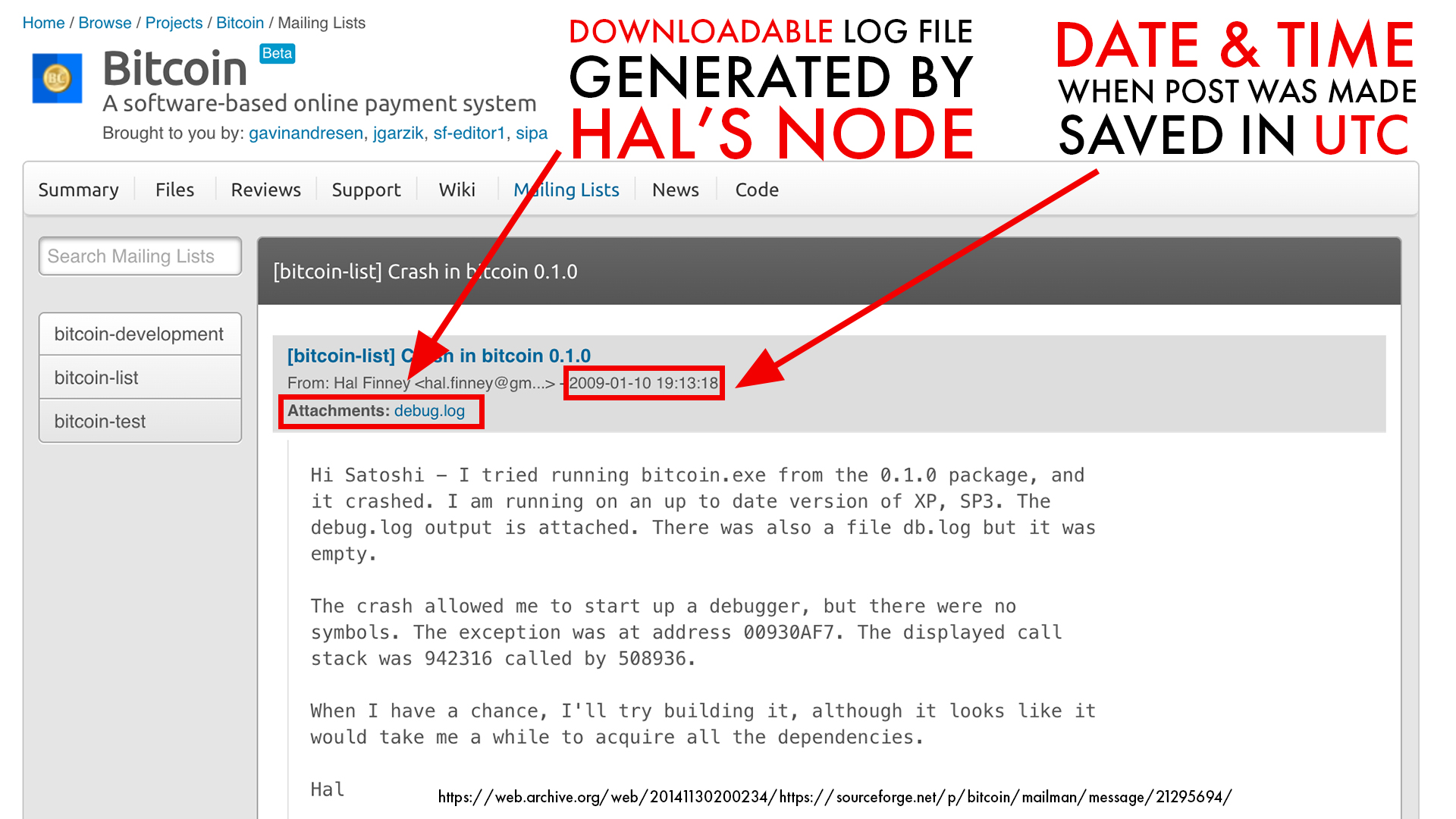
[Transcription of Hal Finney's post on SourceForge]
[bitcoin-list] Crash in bitcoin 0.1.0
[bitcoin-list] Crash in bitcoin 0.1.0
From: Hal Finney <hal.finney@gm...> - 2009-01-10 19:13:18
Attachments: debug.log
Hi Satoshi - I tried running bitcoin.exe from the 0.1.0 package, and
it crashed. I am running on an up to date version of XP, SP3. The
debug.log output is attached. There was also a file db.log but it was
empty.
The crash allowed me to start up a debugger, but there were no
symbols. The exception was at address 00930AF7. The displayed call
stack was 942316 called by 508936.
When I have a chance, I'll try building it, although it looks like it
would take me a while to acquire all the dependencies.
Hal
The most important finding here is that Hal included the debug.log file from his node.
This file records what the node does in the background — and it’s here that we find our most important clue.
Note: “Node” and “client” both refer to the same thing: the software used to communicate with the Bitcoin network. I use both terms interchangeably throughout this article.
You see, back then, Bitcoin worked quite differently. A node would connect to the #bitcoin IRC channel to find other peers, and after it got the peer’s IP, it would connect to them directly.
Think of it like a chat room that was used to coordinate peer discovery.
The very lucky part is that the Internet Archive saved the file attached to Hal’s post, and we can still download it today. To download the file, just click on “debug.log” in the post above. For convenience, here is the direct download link as well: https://web.archive.org/web/20141130200234/https://sourceforge.net/p/bitcoin/mailman/attachment/da7b3ce30901101113v2ec6bf61xf018265479eb7faf%40mail.gmail.com/1/
So what can we see in this file?
Hal’s node successfully connected to some peers, requested Bitcoin blocks, received them, and then crashed.
The log file includes a list of the blocks those peers sent to Hal’s node. We know these are Bitcoin blocks because they can be identified by the first 12 characters of their hashes.
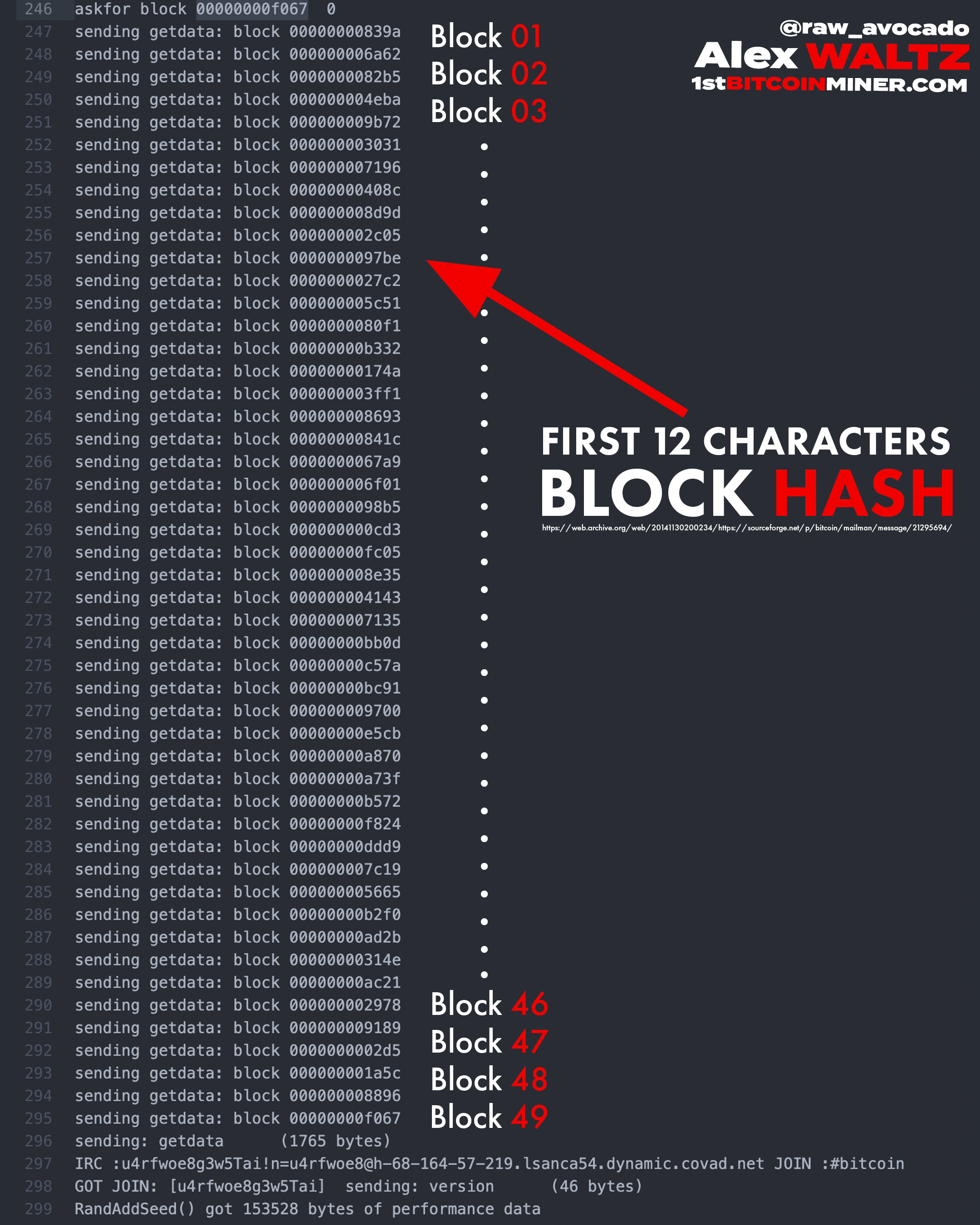
[Transcription of Hal Finney's debug.log file from SourceForge lines 246 to 299]
askfor block 00000000f067 0
sending getdata: block 00000000839a
sending getdata: block 000000006a62
sending getdata: block 0000000082b5
sending getdata: block 000000004eba
sending getdata: block 000000009b72
sending getdata: block 000000003031
sending getdata: block 000000007196
sending getdata: block 00000000408c
sending getdata: block 000000008d9d
sending getdata: block 000000002c05
sending getdata: block 0000000097be
sending getdata: block 0000000027c2
sending getdata: block 000000005c51
sending getdata: block 0000000080f1
sending getdata: block 00000000b332
sending getdata: block 00000000174a
sending getdata: block 000000003ff1
sending getdata: block 000000008693
sending getdata: block 00000000841c
sending getdata: block 0000000067a9
sending getdata: block 000000006f01
sending getdata: block 0000000098b5
sending getdata: block 000000000cd3
sending getdata: block 00000000fc05
sending getdata: block 000000008e35
sending getdata: block 000000004143
sending getdata: block 000000007135
sending getdata: block 00000000bb0d
sending getdata: block 00000000c57a
sending getdata: block 00000000bc91
sending getdata: block 000000009700
sending getdata: block 00000000e5cb
sending getdata: block 00000000a870
sending getdata: block 00000000a73f
sending getdata: block 00000000b572
sending getdata: block 00000000f824
sending getdata: block 00000000ddd9
sending getdata: block 000000007c19
sending getdata: block 000000005665
sending getdata: block 00000000b2f0
sending getdata: block 00000000ad2b
sending getdata: block 00000000314e
sending getdata: block 00000000ac21
sending getdata: block 000000002978
sending getdata: block 000000009189
sending getdata: block 0000000002d5
sending getdata: block 000000001a5c
sending getdata: block 000000008896
sending getdata: block 00000000f067
sending: getdata (1765 bytes)
IRC :u4rfwoe8g3w5Tai!n=u4rfwoe8@h-68-164-57-219.lsanca54.dynamic.covad.net JOIN :#bitcoin
GOT JOIN: [u4rfwoe8g3w5Tai] sending: version (46 bytes)
RandAddSeed() got 153528 bytes of performance data
| Block Number | debug.log partial Block hash | Full Bitcoin block hash |
|---|---|---|
| 1 | 00000000839a | 00000000839a8e6886ab5951d76f411475428afc90947ee320161bbf18eb6048 |
| 2 | 000000006a62 | 000000006a625f06636b8bb6ac7b960a8d03705d1ace08b1a19da3fdcc99ddbd |
| 3 | 0000000082b5 | 0000000082b5015589a3fdf2d4baff403e6f0be035a5d9742c1cae6295464449 |
| 4 | 000000004eba | 000000004ebadb55ee9096c9a2f8880e09da59c0d68b1c228da88e48844a1485 |
| 5 | 000000009b72 | 000000009b7262315dbf071787ad3656097b892abffd1f95a1a022f896f533fc |
| 6 | 000000003031 | 000000003031a0e73735690c5a1ff2a4be82553b2a12b776fbd3a215dc8f778d |
| 7 | 000000007196 | 0000000071966c2b1d065fd446b1e485b2c9d9594acd2007ccbd5441cfc89444 |
| 8 | 00000000408c | 00000000408c48f847aa786c2268fc3e6ec2af68e8468a34a28c61b7f1de0dc6 |
| 9 | 000000008d9d | 000000008d9dc510f23c2657fc4f67bea30078cc05a90eb89e84cc475c080805 |
| 10 | 000000002c05 | 000000002c05cc2e78923c34df87fd108b22221ac6076c18f3ade378a4d915e9 |
| 11 | 0000000097be | 0000000097be56d606cdd9c54b04d4747e957d3608abe69198c661f2add73073 |
| 12 | 0000000027c2 | 0000000027c2488e2510d1acf4369787784fa20ee084c258b58d9fbd43802b5e |
| 13 | 000000005c51 | 000000005c51de2031a895adc145ee2242e919a01c6d61fb222a54a54b4d3089 |
| 14 | 0000000080f1 | 0000000080f17a0c5a67f663a9bc9969eb37e81666d9321125f0e293656f8a37 |
| 15 | 00000000b332 | 00000000b3322c8c3ef7d2cf6da009a776e6a99ee65ec5a32f3f345712238473 |
| 16 | 00000000174a | 00000000174a25bb399b009cc8deff1c4b3ea84df7e93affaaf60dc3416cc4f5 |
| 17 | 000000003ff1 | 000000003ff1d0d70147acfbef5d6a87460ff5bcfce807c2d5b6f0a66bfdf809 |
| 18 | 000000008693 | 000000008693e98cf893e4c85a446b410bb4dfa129bd1be582c09ed3f0261116 |
| 19 | 00000000841c | 00000000841cb802ca97cf20fb9470480cae9e5daa5d06b4a18ae2d5dd7f186f |
| 20 | 0000000067a9 | 0000000067a97a2a37b8f190a17f0221e9c3f4fa824ddffdc2e205eae834c8d7 |
| 21 | 000000006f01 | 000000006f016342d1275be946166cff975c8b27542de70a7113ac6d1ef3294f |
| 22 | 0000000098b5 | 0000000098b58d427a10c860335a21c1a9a7639e96c3d6f1a03d8c8c885b5e3b |
| 23 | 000000000cd3 | 000000000cd339982e556dfffa9de94744a4135c53eeef15b7bcc9bdeb9c2182 |
| 24 | 00000000fc05 | 00000000fc051fbbce89a487e811a5d4319d209785ea4f4b27fc83770d1e415f |
| 25 | 000000008e35 | 000000008e35a1d59ea1be8d76683662f47fd13c62a9e347ad5845a26f762026 |
| 26 | 000000004143 | 0000000041438e52d25bccab8798a92cabafdaad69a071d3d2a41718faf01098 |
| 27 | 000000007135 | 0000000071350772f98f84babf35502b33d42ee8466d3dde0f376c4120352081 |
| 28 | 00000000bb0d | 00000000bb0d9430d3d1bab474be5050342161efcca9f7e45b151bff9a700944 |
| 29 | 00000000c57a | 00000000c57a1b6351208c592eef8eff015d93c899a047fe35b35252a4a59bcb |
| 30 | 00000000bc91 | 00000000bc919cfb64f62de736d55cf79e3d535b474ace256b4fbb56073f64db |
| 31 | 000000009700 | 000000009700ff3494f215c412cd8c0ceabf1deb0df03ce39bcfc223b769d3c4 |
| 32 | 00000000e5cb | 00000000e5cb7c6c273547b0c9421b01e23310ed83f934b96270f35a4d66f6e3 |
| 33 | 00000000a870 | 00000000a87073ea3d7af299e02a434598b9c92094afa552e0711afcc0857962 |
| 34 | 00000000a73f | 00000000a73fb23b6c42b18b3253ed29c5d0c80d84624efa12c2cf05c4b4318f |
| 35 | 00000000b572 | 00000000b572a465b4e816420d47a16274557b3573b7924b64808a82c7322d9b |
| 36 | 00000000f824 | 00000000f824d643f525b4904ea25c92174b8499435f388549a1700f4d3244de |
| 37 | 00000000ddd9 | 00000000ddd96d128e122d1179034ff66c27dc583eb9e8996a0b1779c60c6f86 |
| 38 | 000000007c19 | 000000007c19ee8e924d3024d58efff50f872aadf256140bb1e3d62fea4fd6dd |
| 39 | 000000005665 | 000000005665d506f6c3ccb5fd98624f9816a8a169f1d2327d1d4d6d3262ad12 |
| 40 | 00000000b2f0 | 00000000b2f01f399bf503e55f25a1aa51067056d2eb81915cb91976968b69aa |
| 41 | 00000000ad2b | 00000000ad2b48c7032b6d7d4f2e19e54d79b1c159f5599056492f2cd7bb528b |
| 42 | 00000000314e | 00000000314e90489514c787d615cea50003af2023796ccdd085b6bcc1fa28f5 |
| 43 | 00000000ac21 | 00000000ac21f2862aaab177fd3c5c8b395de842f84d88c9cf3420b2d393e550 |
| 44 | 000000002978 | 000000002978eecde8d020f7f057083bc990002fff495121d7dc1c26d00c00f8 |
| 45 | 000000009189 | 000000009189006e461d2f4037a819d00217412ac01900ddbf09461100b836bb |
| 46 | 0000000002d5 | 0000000002d5f429a2e3a9d9f82b777469696deb64038803c87833aa8ee9c08e |
| 47 | 000000001a5c | 000000001a5c4531f86aa874e711e1882038336e2610f70ce750cdd690c57a81 |
| 48 | 000000008896 | 0000000088960278f4060b8747027b2aac0eb443aedbb1b75d1a72cf71826e89 |
| 49 | 00000000f067 | 00000000f067c09041ff0fcee3d91aeb7fbcc5654d3f766af2b4377aaee68d00 |
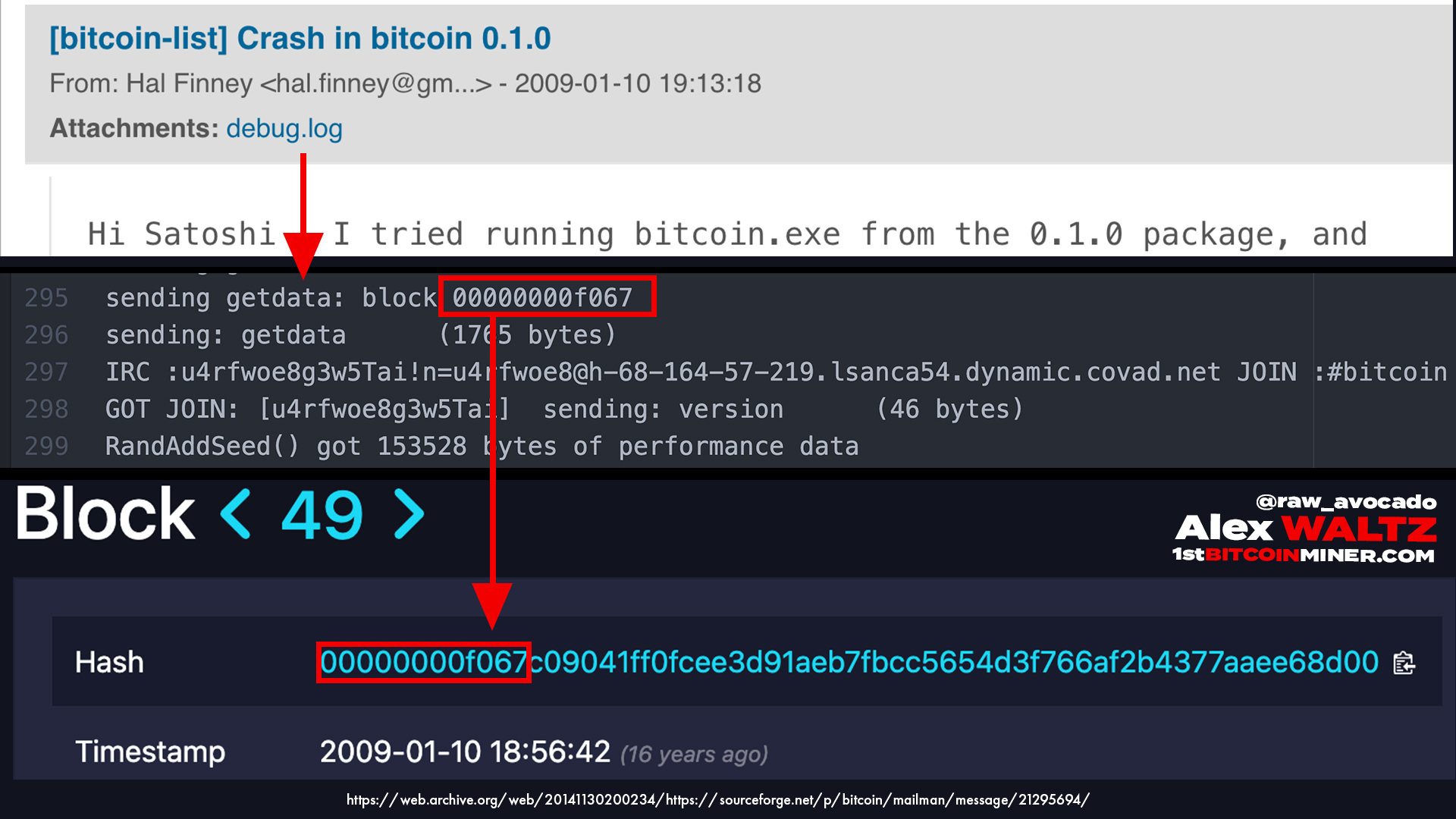
Even more importantly, the fact that we have 49 hashes in this file indicates that Bitcoin, or at least this iteration of it, had existed for at least 49 blocks by the time Hal’s node crashed.
(It’s worth mentioning that Bitcoin started with a very low difficulty, so generating 49 blocks wouldn’t have been particularly hard. However, it still serves as some proof of consistent mining.)
But there’s another very important detail relevant to our investigation. In the first version of the Bitcoin code, Satoshi added a very interesting constraint:
The Bitcoin client would not start mining (or produce blocks) unless it had an established connection to other nodes (incoming or outgoing).
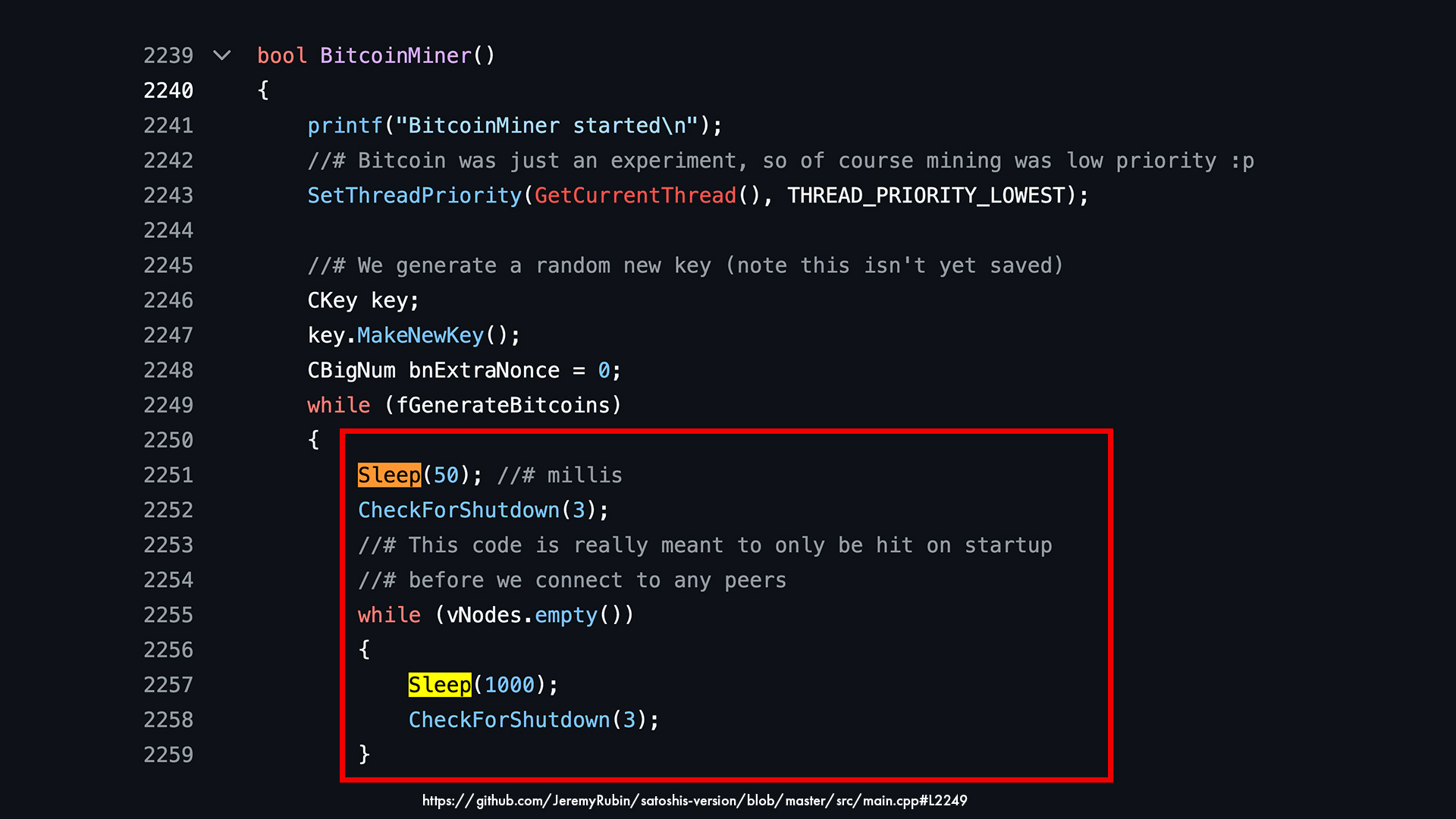
//# Code snipped of original Satoshi code from Jeremy Rubin's github repository that has aditional comments
bool BitcoinMiner()
{
printf("BitcoinMiner started\n");
//# Bitcoin was just an experiment, so of course mining was low priority :p
SetThreadPriority(GetCurrentThread(), THREAD_PRIORITY_LOWEST);
//# We generate a random new key (note this isn't yet saved)
CKey key;
key.MakeNewKey();
CBigNum bnExtraNonce = 0;
while (fGenerateBitcoins)
{
Sleep(50); //# millis
CheckForShutdown(3);
//# This code is really meant to only be hit on startup
//# before we connect to any peers
while (vNodes.empty())
{
Sleep(1000);
CheckForShutdown(3);
}
Source: https://github.com/JeremyRubin/satoshis-version/blob/master/src/main.cpp#L2249
Why did Satoshi add this constraint?
My educated guess is that it was meant to prevent multiple independent instances of Bitcoin from starting in parallel — all originating from the same Genesis Block.
It’s worth noting that Satoshi could have run multiple nodes on different machines, but based on the available information, it’s hard to say for certain whether that was the case.
The important thing to understand here is that multiple nodes do not necessarily imply multiple people running them.
So, based on what we see in the debug.log file — combined with the constraint found in the code — it means that when Hal ran Bitcoin for the first time, another node or nodes (besides Satoshi’s obvious one) were already on the network. Otherwise, it wouldn’t have started generating blocks.
But there’s more!
After Hal posted on SourceForge that Bitcoin v0.1 wasn’t working for him, he and Satoshi continued their conversation privately. Satoshi then made changes to the Bitcoin client based on Hal’s feedback.
Hal Finney - Satoshi Nakamoto Private Emails (from Wall Street Journal)
Aaaaaaand we’re in luck yet again, because these private emails were shared by Hal with The Wall Street Journal in 2014, and can be found here: https://www.wsj.com/public/resources/documents/finneynakamotoemails.pdf
They were published as part of the Hal Finney and Bitcoin’s Earliest Day article (archive) by Paul Vigna, one day after Hal’s death.
These emails don’t include the detailed header information from Hal’s email server like the ones in the CoinDesk article. Instead, they only contain a timestamp, with no time zone specified.
However, it’s safe to assume that the timestamps are in PST, because:
- The earlier emails (from CoinDesk) explicitly show that Hal’s server was using the PST time zone, “-0800 (PST)”

[Transcription of Satoshi - Hal Private email 1 header from CoinDesk article, indicating]
From satoshi@vistomail.com Thu Jan 8 20:54:55 2009
Return-Path: <satoshi@vistomail.com>
X-Original-To: hal@finney.org
Delivered-To: hal@finney.org
Received: from mail.anonymousspeech.com (anonymousspeech.com [124.217.253.42])
by finney.org (Postfix) with ESMTP id 467AA14F6E1
for <hal@finney.org>; Thu, 8 Jan 2009 20:54:53 -0800 (PST)
- Hal lived in California, which operates on PST.
These emails were redacted (likely by Hal) to make them easier to read, and they focus primarily on Satoshi’s responses to Hal’s messages.
The text preceded by a > symbol is written by Hal, while the text without it is written by Satoshi.
Although the email headers aren’t as detailed as those in the CoinDesk article, they still show the sender and recipient.
So, let’s continue our investigation.
We left off with Hal’s post on SourceForge, where he reported that Bitcoin v0.1 wasn’t working for him.
Here, we can see Satoshi’s direct response to that message, as it quotes Hal’s SourceForge post, sent on: Sat, Jan 10, 2009 at 11:52 AM(PST) -> Saturday, 10 January 2009 19:52:00 UTC
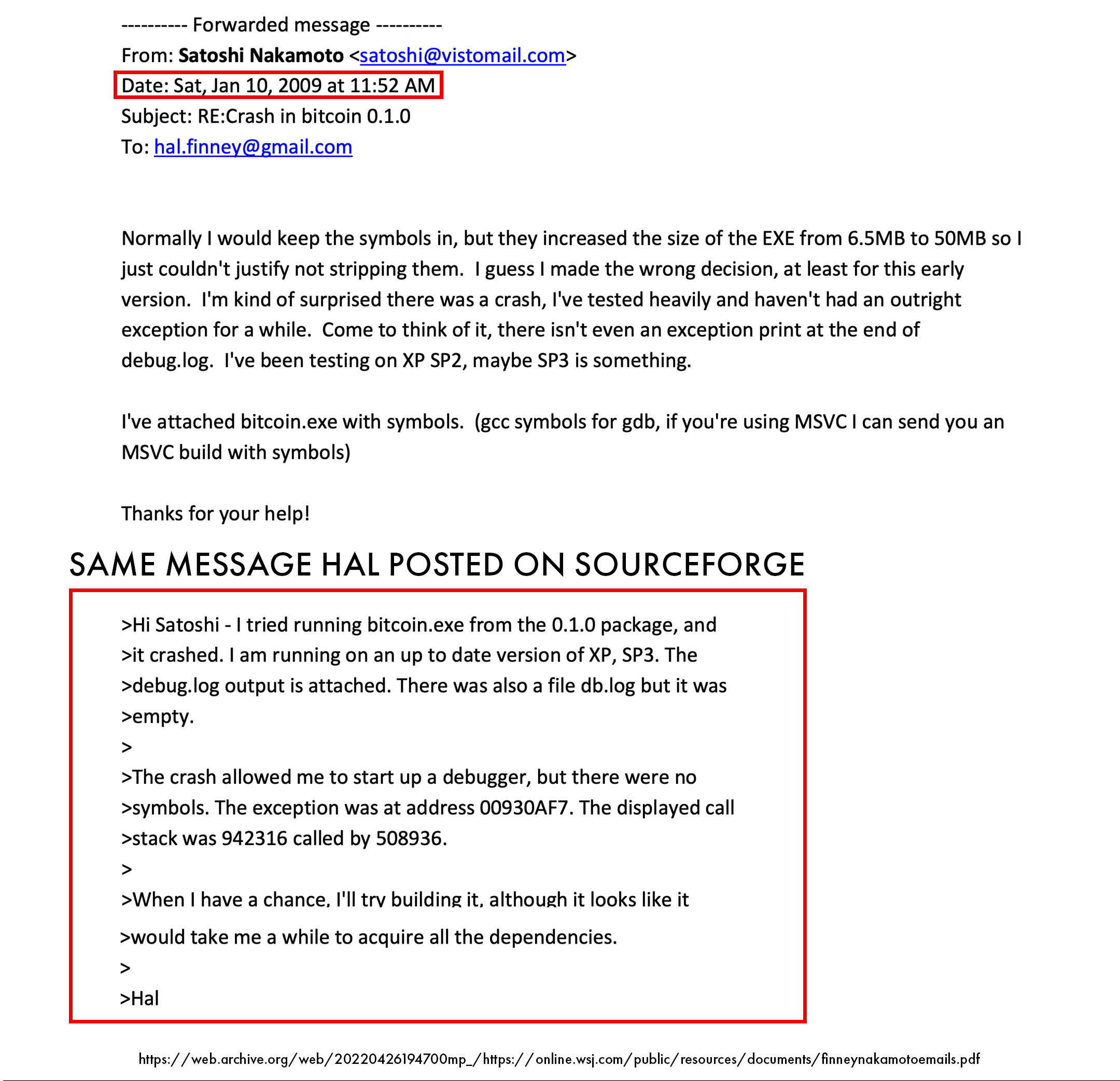
[Transcription of Satoshi - Hal Private email 1 from Wall Street Journal]
---------- Forwarded message ----------
From: Satoshi Nakamoto <satoshi@vistomail.com>
Date: Sat, Jan 10, 2009 at 11:52 AM
Subject: RE:Crash in bitcoin 0.1.0
To: hal.finney@gmail.com
Normally I would keep the symbols in, but they increased the size of the EXE from 6.5MB to 50MB so I
just couldn't justify not stripping them. I guess I made the wrong decision, at least for this early
version. I'm kind of surprised there was a crash, I've tested heavily and haven't had an outright
exception for a while. Come to think of it, there isn't even an exception print at the end of
debug.log. I've been testing on XP SP2, maybe SP3 is something.
I've attached bitcoin.exe with symbols. (gcc symbols for gdb, if you're using MSVC I can send you an
MSVC build with symbols)
Thanks for your help!
>Hi Satoshi - I tried running bitcoin.exe from the 0.1.0 package, and
>it crashed. I am running on an up to date version of XP, SP3. The
>debug.log output is attached. There was also a file db.log but it was
>empty.
>
>The crash allowed me to start up a debugger, but there were no
>symbols. The exception was at address 00930AF7. The displayed call
>stack was 942316 called by 508936.
>
>When I have a chance, I'll try building it, although it looks like it
>would take me a while to acquire all the dependencies.
>
>Hal
After some more back-and-forth, we see in this email from Satoshi to Hal, sent on Sat, Jan 10, 2009 at 2:59 PM (PST) -> Saturday, 10 January 2009 22:59:00 UTC, that Hal did manage to get Bitcoin v0.1 working and left it running for a while.
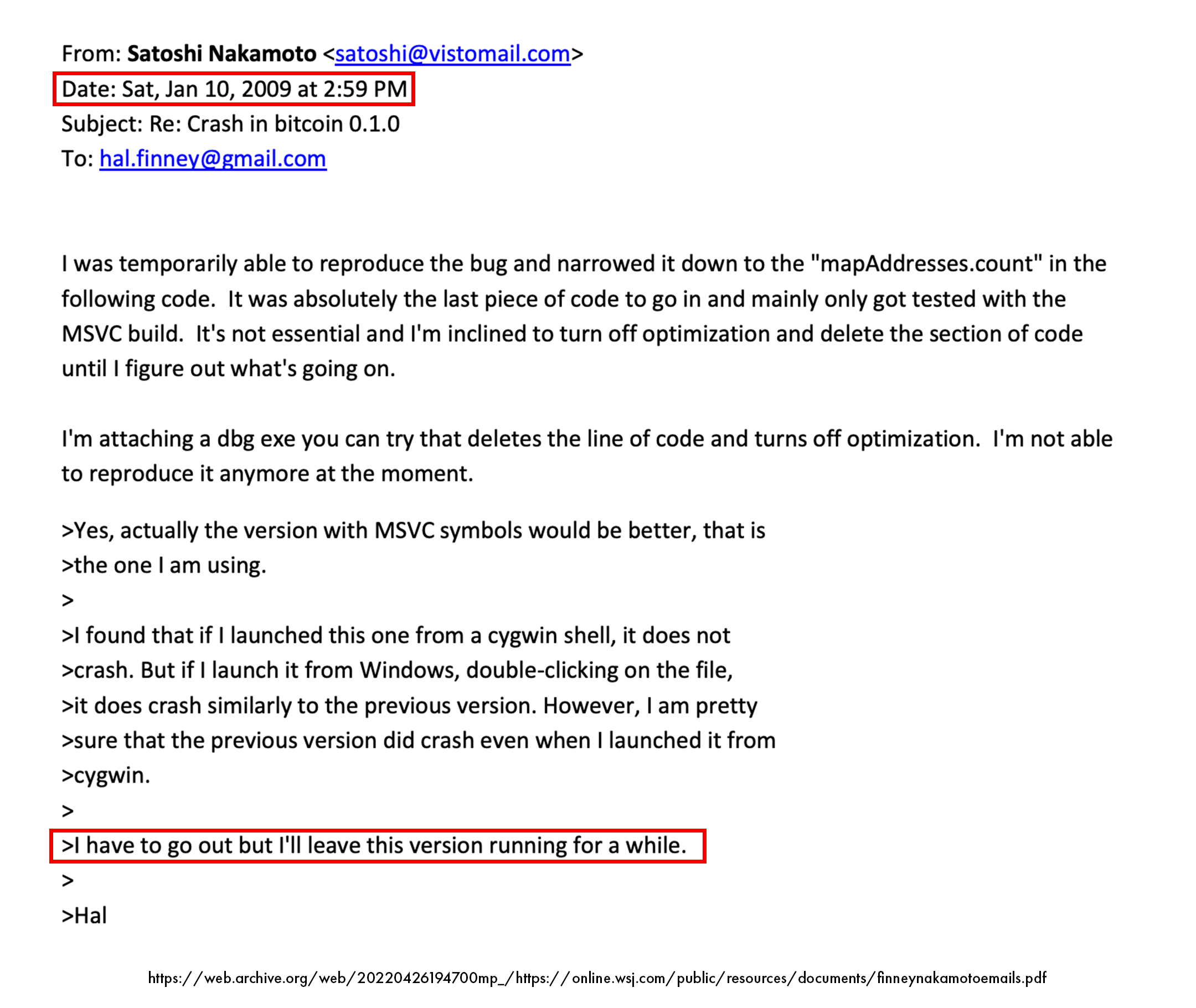
[Transcription of Satoshi - Hal Private email 2 from Wall Street Journal]
From: Satoshi Nakamoto <satoshi@vistomail.com>
Date: Sat, Jan 10, 2009 at 2:59 PM
Subject: Re: Crash in bitcoin 0.1.0
To: hal.finney@gmail.com
I was temporarily able to reproduce the bug and narrowed it down to the "mapAddresses.count" in the
following code. It was absolutely the last piece of code to go in and mainly only got tested with the
MSVC build. It's not essential and I'm inclined to turn off optimization and delete the section of code
until I figure out what's going on.
I'm attaching a dbg exe you can try that deletes the line of code and turns off optimization. I'm not able
to reproduce it anymore at the moment.
irc.cpp:
if (pszName[0] == 'u')
{
CAddress addr;
if (DecodeAddress(pszName, addr))
{
CAddrDB addrdb;
if (AddAddress(addrdb, addr))
printf("new ");
else
{
// make it try connecting sooner
CRITICAL_BLOCK(cs_mapAddresses)
if (mapAddresses.count(addr.GetKey()))
mapAddresses[addr.GetKey()].nLastFailed = 0;
}
addr.print();
}
else
{
printf("decode failed\n");
}
}
>Yes, actually the version with MSVC symbols would be better, that is
>the one I am using.
>
>I found that if I launched this one from a cygwin shell, it does not
>crash. But if I launch it from Windows, double-clicking on the file,
>it does crash similarly to the previous version. However, I am pretty
>sure that the previous version did crash even when I launched it from
>cygwin.
>
>I have to go out but I'll leave this version running for a while.
>
>Hal
However, as we’ll see later, Hal’s node didn’t run for very long . . .
Meanwhile, on the Cryptography Mailing List, Hal congratulated Satoshi on the release of Bitcoin v0.1 on: Sat Jan 10 21:22:01 EST 2009 -> Sunday, 11 January 2009 02:22:01 UTC
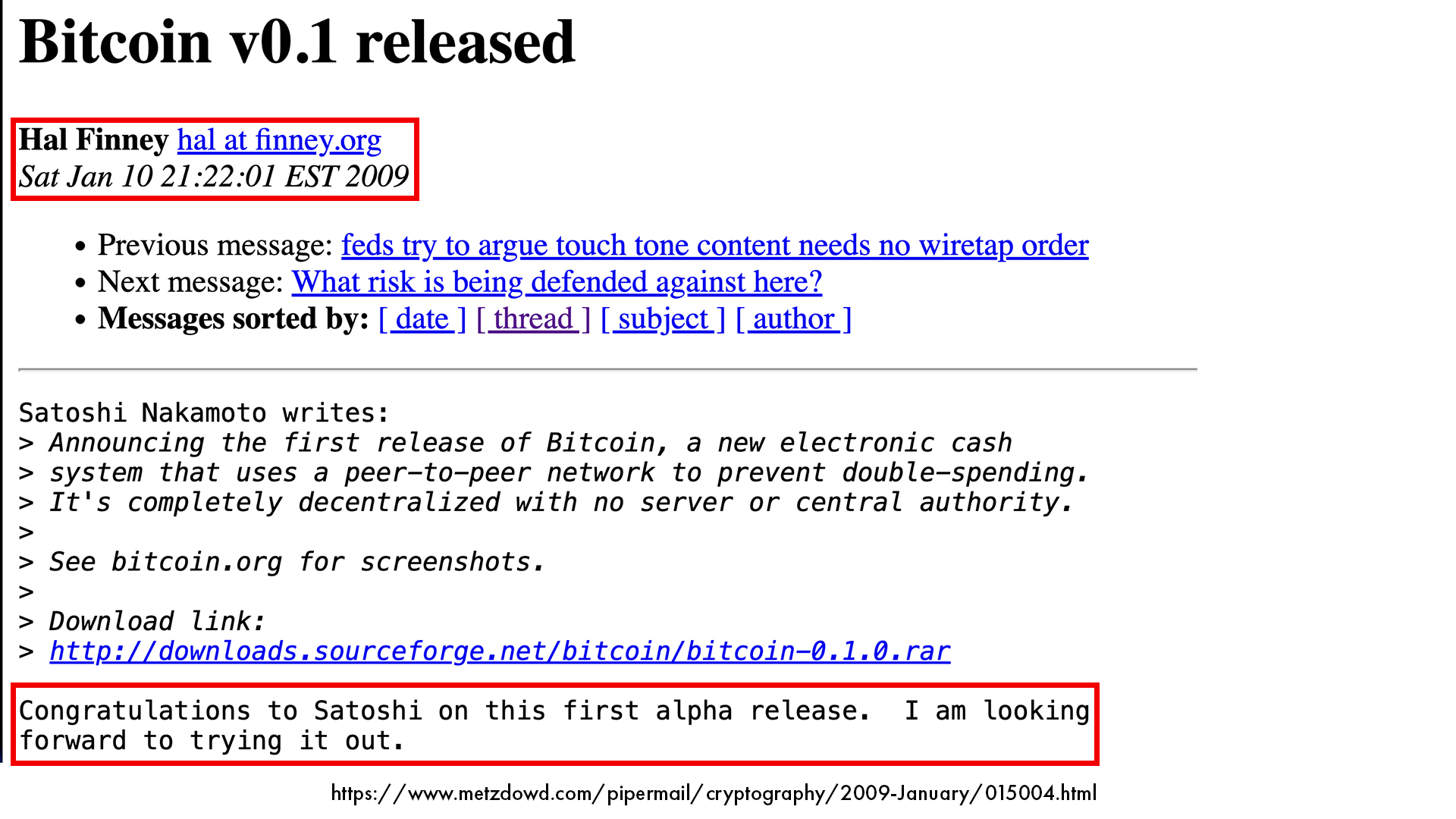
[Transcription of Cryptography Mailing List Hal's reply to Post Bitcoin v0.1 released]
Bitcoin v0.1 released
Hal Finney hal at finney.org
Sat Jan 10 21:22:01 EST 2009
Previous message: feds try to argue touch tone content needs no wiretap order
Next message: What risk is being defended against here?
Messages sorted by: [ date ] [ thread ] [ subject ] [ author ]
Satoshi Nakamoto writes:
> Announcing the first release of Bitcoin, a new electronic cash
> system that uses a peer-to-peer network to prevent double-spending.
> It's completely decentralized with no server or central authority.
>
> See bitcoin.org for screenshots.
>
> Download link:
> http://downloads.sourceforge.net/bitcoin/bitcoin-0.1.0.rar
Congratulations to Satoshi on this first alpha release. I am looking
forward to trying it out.
The private conversation between the two continues, as Satoshi sends Hal Bitcoin v0.1.1 on: Sat, Jan 10, 2009 at 6:55 PM (PST) -> Sunday, 11 January 2009 02:55:00 UTC
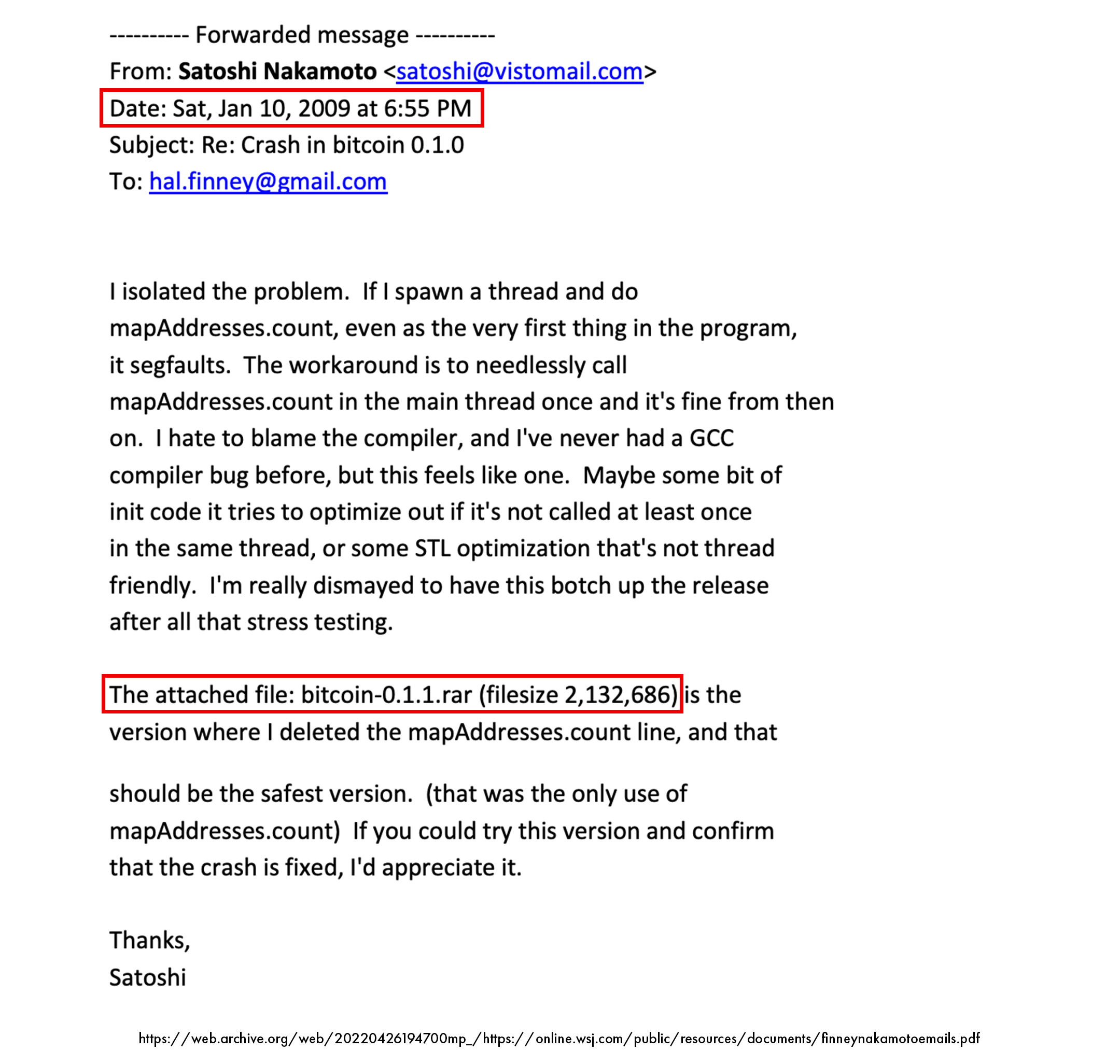
[Transcription of Satoshi - Hal Private email 3 from Wall Street Journal]
---------- Forwarded message ----------
From: Satoshi Nakamoto <satoshi@vistomail.com>
Date: Sat, Jan 10, 2009 at 6:55 PM
Subject: Re: Crash in bitcoin 0.1.0
To: hal.finney@gmail.com
I isolated the problem. If I spawn a thread and do
mapAddresses.count, even as the very first thing in the program,
it segfaults. The workaround is to needlessly call
mapAddresses.count in the main thread once and it's fine from then
on. I hate to blame the compiler, and I've never had a GCC
compiler bug before, but this feels like one. Maybe some bit of
init code it tries to optimize out if it's not called at least once
in the same thread, or some STL optimization that's not thread
friendly. I'm really dismayed to have this botch up the release
after all that stress testing.
The attached file: bitcoin-0.1.1.rar (filesize 2,132,686) is the
version where I deleted the mapAddresses.count line, and that
should be the safest version. (that was the only use of
mapAddresses.count) If you could try this version and confirm
that the crash is fixed, I'd appreciate it.
Thanks,
Satoshi
An hour later, he sends the debug version bitcoin-0.1.1-exe-dbg.rar on Sat, Jan 10, 2009 at 7:11 PM (PST) -> Sunday, 11 January, 2009 at 03:11 UTC
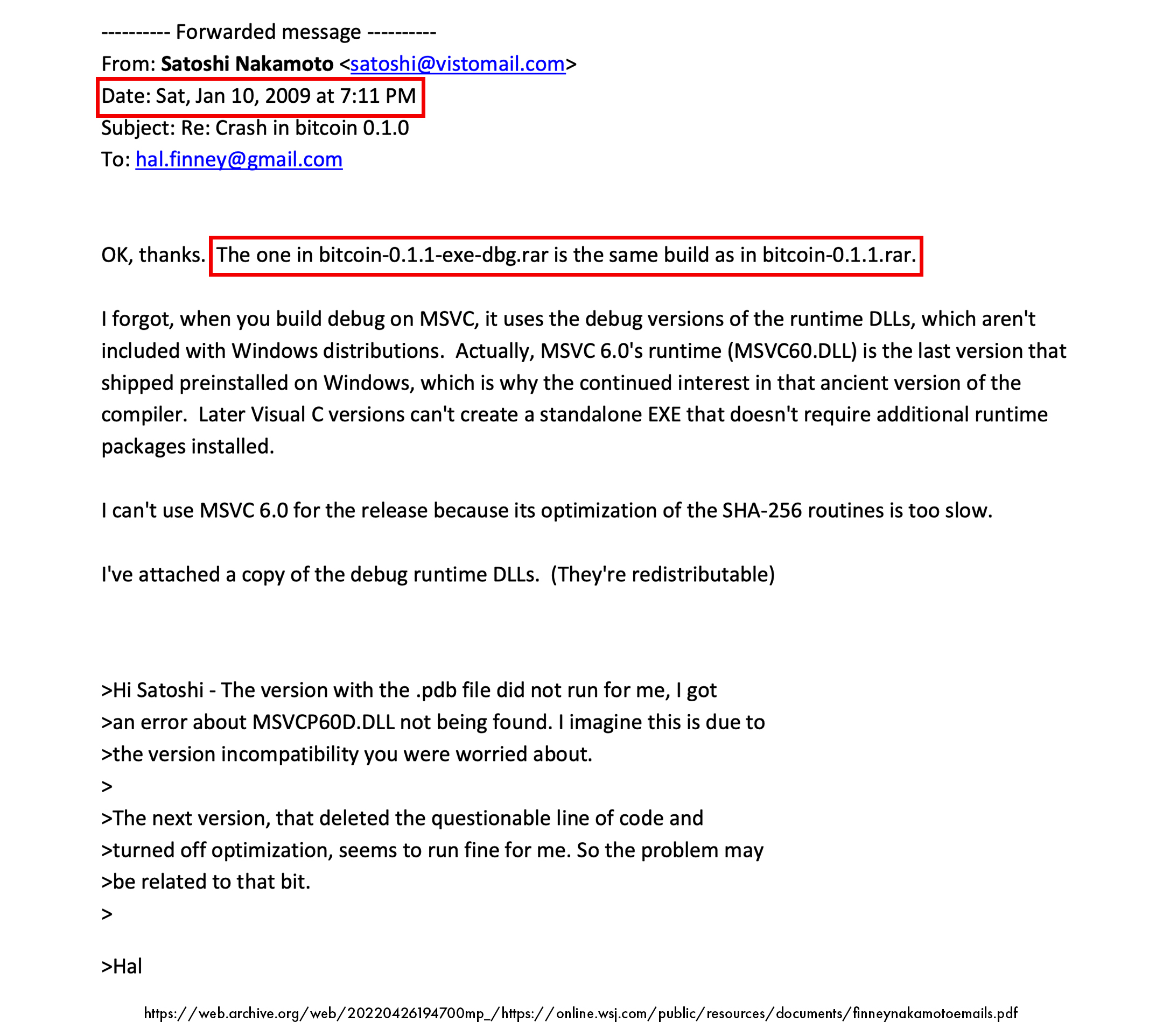
[Transcription of Satoshi - Hal Private email 4 from Wall Street Journal]
---------- Forwarded message ----------
From: Satoshi Nakamoto <satoshi@vistomail.com>
Date: Sat, Jan 10, 2009 at 7:11 PM
Subject: Re: Crash in bitcoin 0.1.0
To: hal.finney@gmail.com
OK, thanks. The one in bitcoin-0.1.1-exe-dbg.rar is the same build as in bitcoin-0.1.1.rar.
I forgot, when you build debug on MSVC, it uses the debug versions of the runtime DLLs, which aren't
included with Windows distributions. Actually, MSVC 6.0's runtime (MSVC60.DLL) is the last version that
shipped preinstalled on Windows, which is why the continued interest in that ancient version of the
compiler. Later Visual C versions can't create a standalone EXE that doesn't require additional runtime
packages installed.
I can't use MSVC 6.0 for the release because its optimization of the SHA-256 routines is too slow.
I've attached a copy of the debug runtime DLLs. (They're redistributable)
>Hi Satoshi - The version with the .pdb file did not run for me, I got
>an error about MSVCP60D.DLL not being found. I imagine this is due to
>the version incompatibility you were worried about.
>
>The next version, that deleted the questionable line of code and
>turned off optimization, seems to run fine for me. So the problem may
>be related to that bit.
>
>Hal
And just 22 minutes after that, we get the famous “Running Bitcoin” tweet from Hal: 3:33 AM · January 11,2009 (UTC)
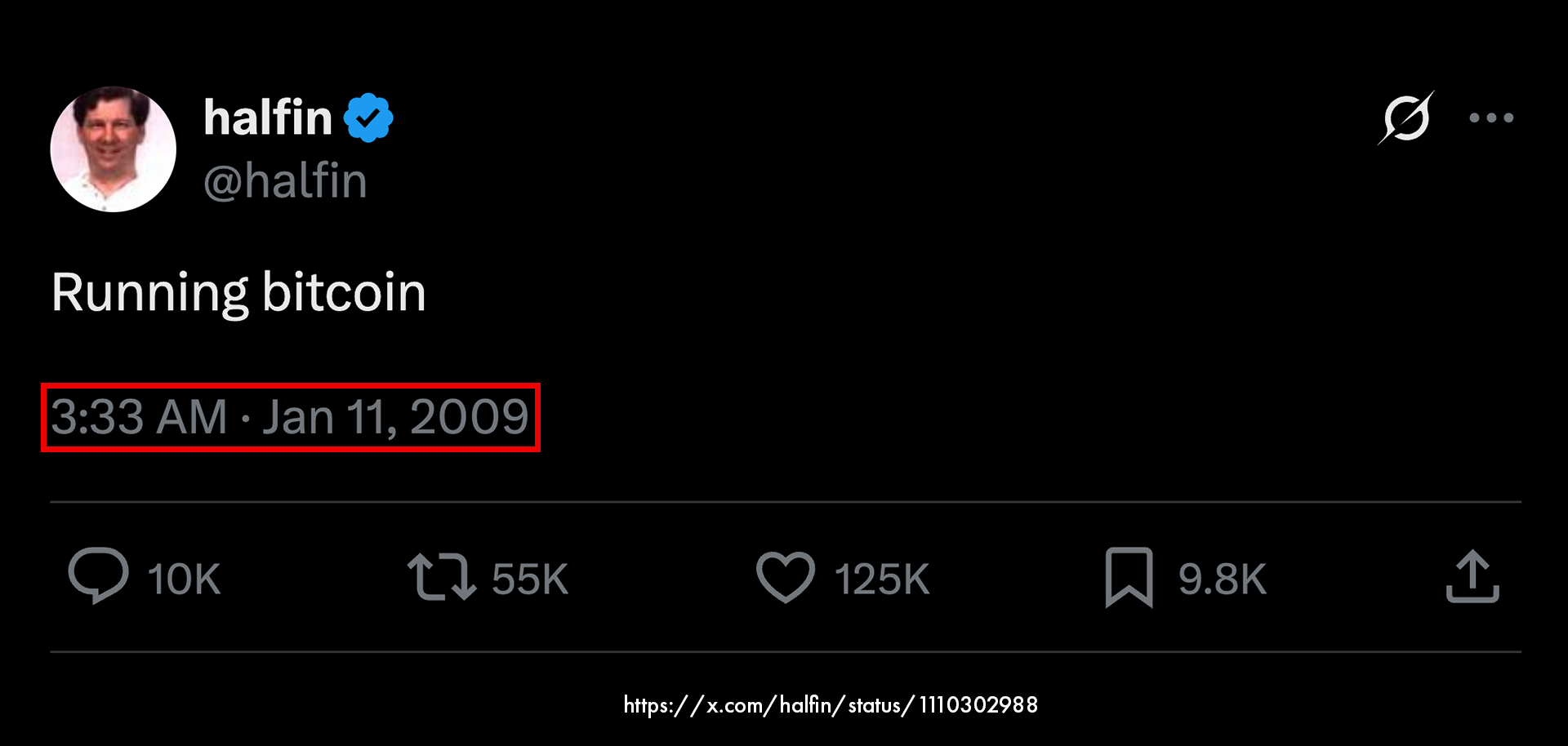
[Transcription of Hal Finney's tweet January 11 2009]
halfin @halfin
Running bitcoin
3:33 AM · Jan 11, 2009
So, we can infer that Hal Finney was running Bitcoin v0.1.1 when he made the “Running Bitcoin” tweet.
But as fate would have it, this version also crashed, and the back-and-forth continued as they worked toward a stable release.
Meanwhile, Satoshi announced Bitcoin v0.1.2 on the SourceForge mailing list on: Sunday, 11 January 2009 22:32:00 UTC
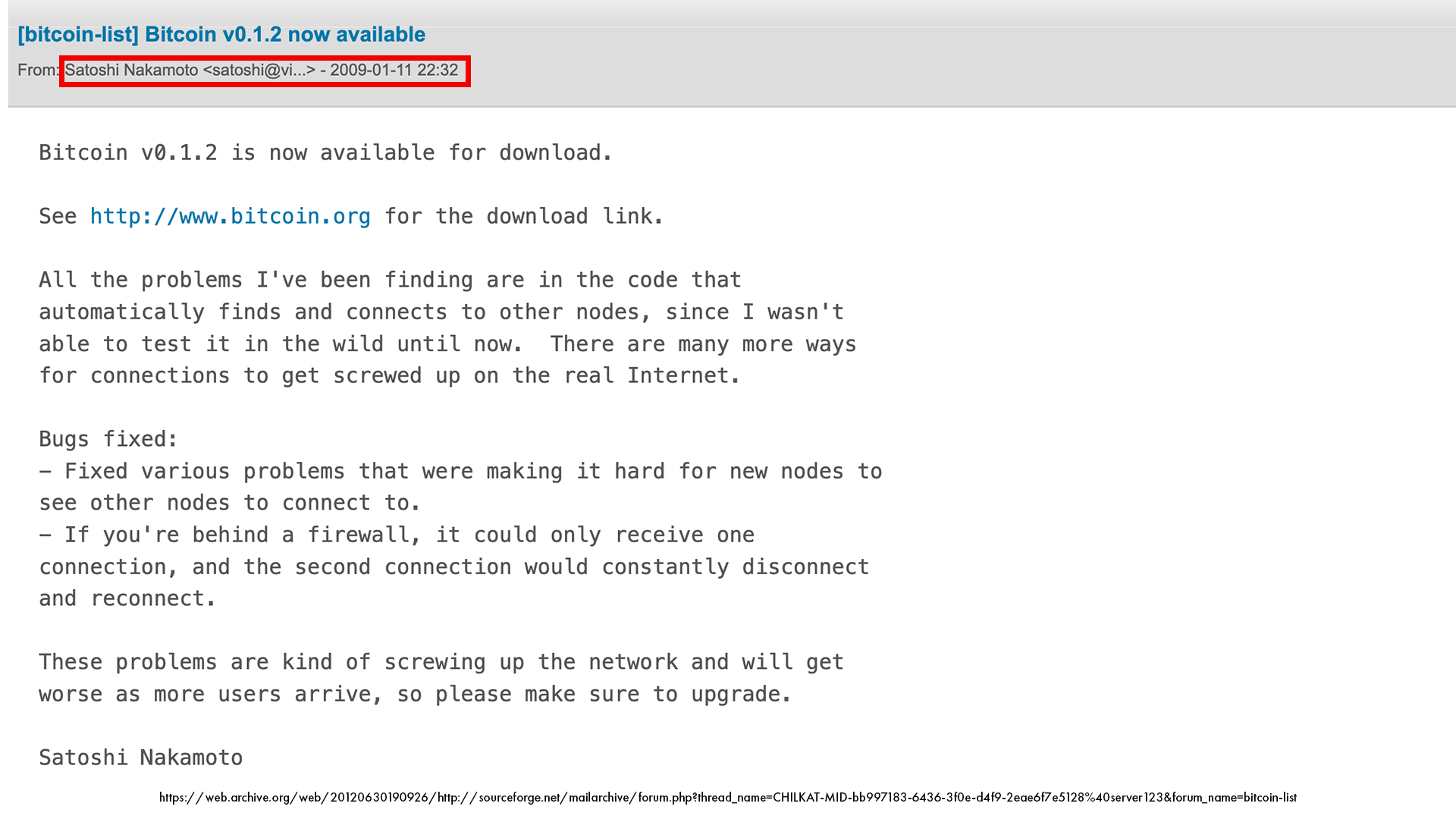
[Transcription of Satoshi Nakamoto's post on SourceForge]
[bitcoin-list] Bitcoin v0.1.2 now available
From: Satoshi Nakamoto <satoshi@vi...> - 2009-01-11 22:32
Bitcoin v0.1.2 is now available for download.
See http://www.bitcoin.org for the download link.
All the problems I've been finding are in the code that
automatically finds and connects to other nodes, since I wasn't
able to test it in the wild until now. There are many more ways
for connections to get screwed up on the real Internet.
Bugs fixed:
- Fixed various problems that were making it hard for new nodes to
see other nodes to connect to.
- If you're behind a firewall, it could only receive one
connection, and the second connection would constantly disconnect
and reconnect.
These problems are kind of screwing up the network and will get
worse as more users arrive, so please make sure to upgrade.
Satoshi Nakamoto
Next, Satoshi acknowledged that Hal had run v0.1.2, but it broke, and sent him the MSVC debug version on: Sun, Jan 11, 2009 at 4:36 PM(PST) -> Monday, 12 January 2009 00:36:00 UTC
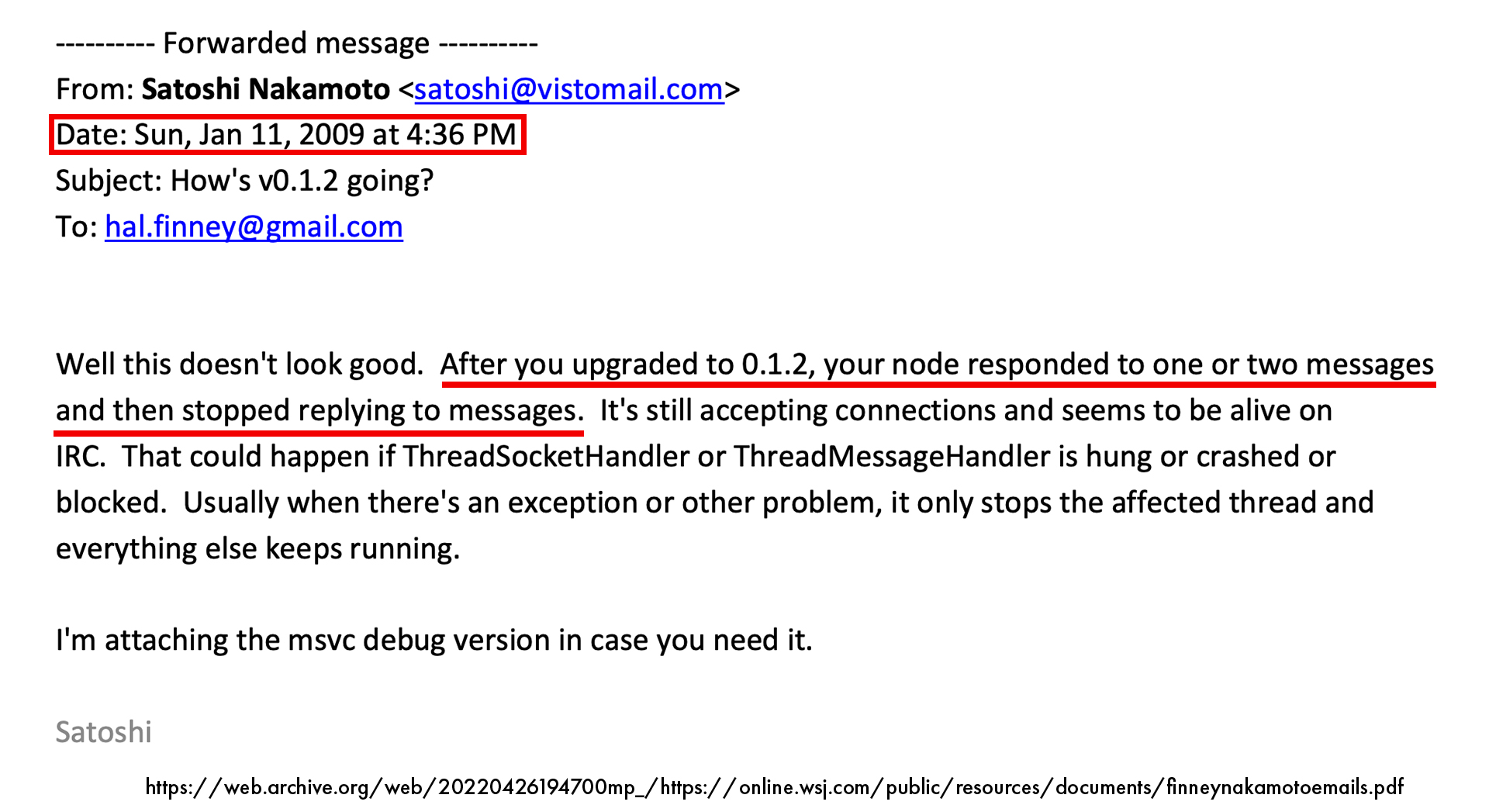
[Transcription of Satoshi - Hal Private email 5 from Wall Street Journal]
---------- Forwarded message ----------
From: Satoshi Nakamoto <satoshi@vistomail.com>
Date: Sun, Jan 11, 2009 at 4:36 PM
Subject: How's v0.1.2 going?
To: hal.finney@gmail.com
Well this doesn't look good. After you upgraded to 0.1.2, your node responded to one or two messages
and then stopped replying to messages. It's still accepting connections and seems to be alive on
IRC. That could happen if ThreadSocketHandler or ThreadMessageHandler is hung or crashed or
blocked. Usually when there's an exception or other problem, it only stops the affected thread and
everything else keeps running.
I'm attaching the msvc debug version in case you need it.
Satoshi
MSVC is the Microsoft Visual C++ compiler used for Windows. This debug version allowed for better inspection of runtime errors.
And then came Block 170 — the first Bitcoin transfer ever made:
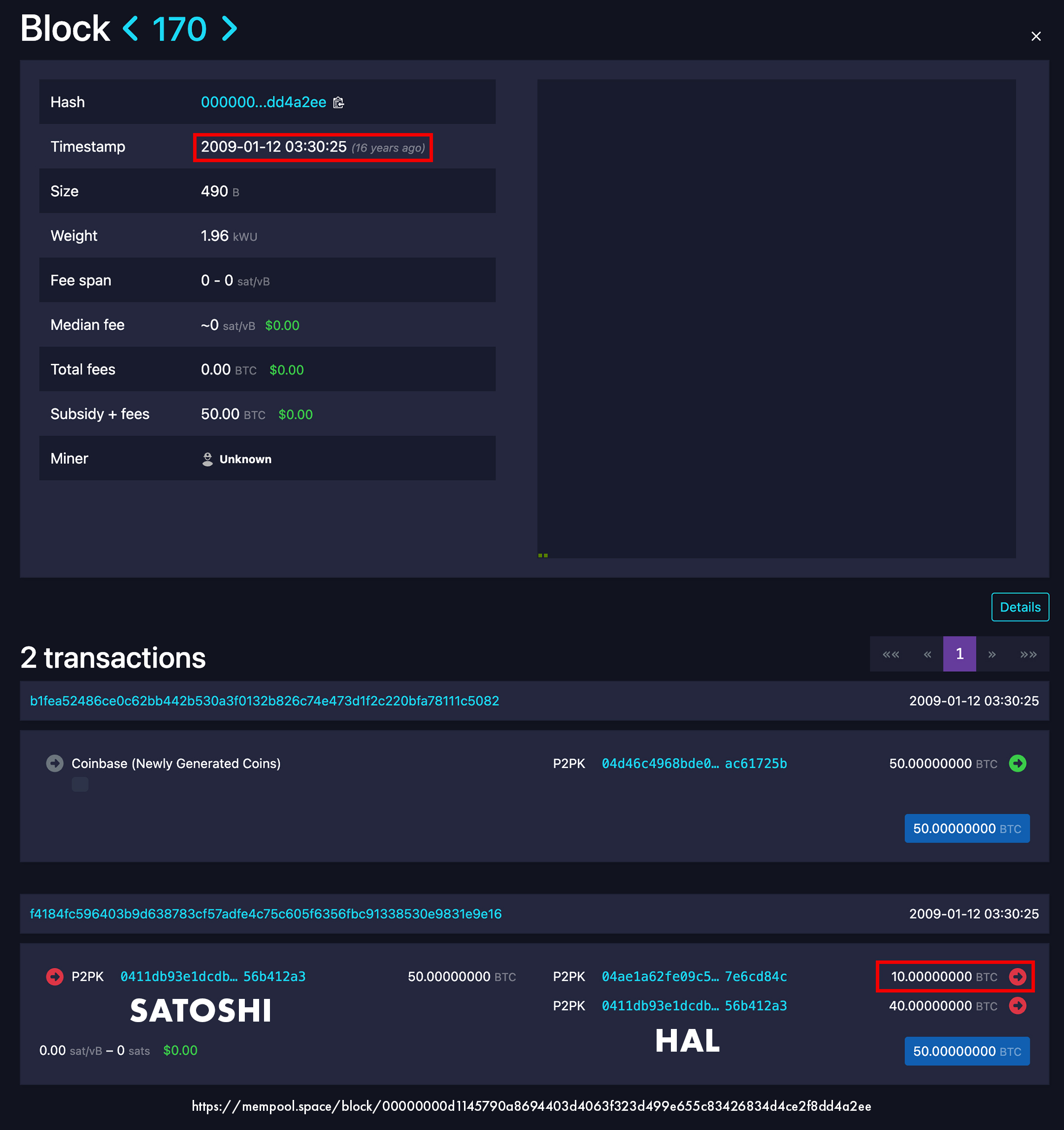
[Transcription of Block 170 from mempool.space block explorer]
Block
170
Hash 000000...dd4a2ee
Timestamp 2009-01-12 03:30:25 (17 years ago)
Size 490 B
Weight 1.96 kWU
Fee span 0.00 - 0.00 sat/vB
Median fee ~0 sat/vB$0.00
Total fees 0.00 BTC $0.00
Subsidy + fees 50.00 BTC $0.00
2 transactions
b1fea52486ce0c62bb442b530a3f0132b826c74e473d1f2c220bfa78111c5082
2009-01-12 03:30:25
Coinbase (Newly Generated Coins)
P2PK
04d46c4968bde02899d2aa0963367c7a6ce34eec332b32e42e5f3407e052d64ac625da6f0718e7b302140434bd725706957c092db53805b821a85b23a7ac61725b
50.00000000 BTC
f4184fc596403b9d638783cf57adfe4c75c605f6356fbc91338530e9831e9e16
2009-01-12 03:30:25
P2PK
0411db93e1dcdb8a016b49840f8c53bc1eb68a382e97b1482ecad7b148a6909a5cb2e0eaddfb84ccf9744464f82e160bfa9b8b64f9d4c03f999b8643f656b412a3
50.00000000 BTC
P2PK
04ae1a62fe09c5f51b13905f07f06b99a2f7159b2225f374cd378d71302fa28414e7aab37397f554a7df5f142c21c1b7303b8a0626f1baded5c72a704f7e6cd84c
10.00000000 BTC
P2PK
0411db93e1dcdb8a016b49840f8c53bc1eb68a382e97b1482ecad7b148a6909a5cb2e0eaddfb84ccf9744464f82e160bfa9b8b64f9d4c03f999b8643f656b412a3
40.00000000 BTC
0.00 sat/vB – 0 sats $0.00
Source: https://mempool.space/block/00000000d1145790a8694403d4063f323d499e655c83426834d4ce2f8dd4a2ee
Two hours later, on: Sun, Jan 11, 2009 at 9:31 PM(PST) -> Monday, 12 January 2009 05:31:00 UTC Hal received Bitcoin v0.1.3 from Satoshi.
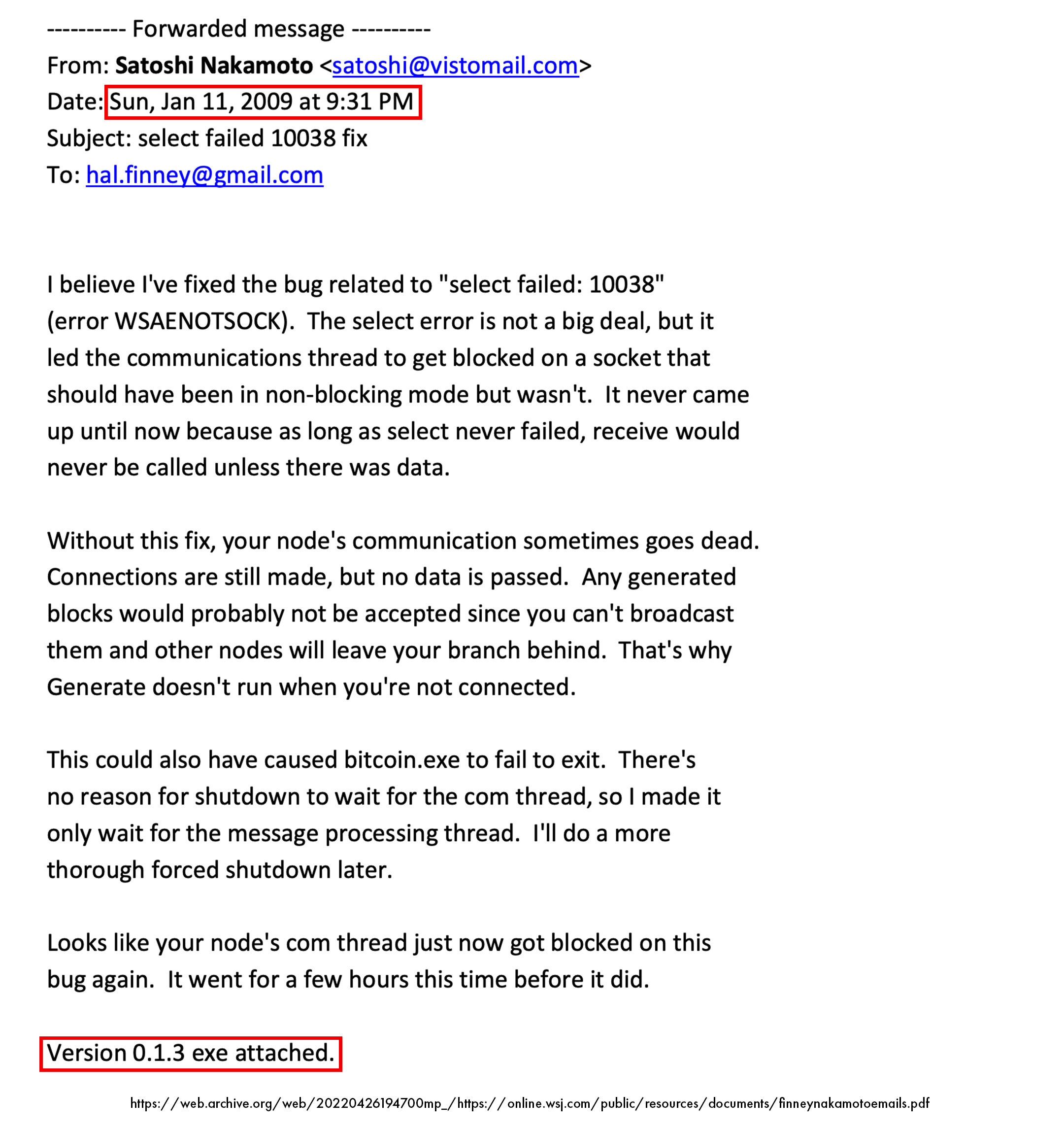
[Transcription of Satoshi - Hal Private email 6 from Wall Street Journal]
---------- Forwarded message ----------
From: Satoshi Nakamoto <satoshi@vistomail.com>
Date: Sun, Jan 11, 2009 at 9:31 PM
Subject: select failed 10038 fix
To: hal.finney@gmail.com
I believe I've fixed the bug related to "select failed: 10038"
(error WSAENOTSOCK). The select error is not a big deal, but it
led the communications thread to get blocked on a socket that
should have been in non-blocking mode but wasn't. It never came
up until now because as long as select never failed, receive would
never be called unless there was data.
Without this fix, your node's communication sometimes goes dead.
Connections are still made, but no data is passed. Any generated
blocks would probably not be accepted since you can't broadcast
them and other nodes will leave your branch behind. That's why
Generate doesn't run when you're not connected.
This could also have caused bitcoin.exe to fail to exit. There's
no reason for shutdown to wait for the com thread, so I made it
only wait for the message processing thread. I'll do a more
thorough forced shutdown later.
Looks like your node's com thread just now got blocked on this
bug again. It went for a few hours this time before it did.
Version 0.1.3 exe attached.
And now we can infer that Hal Finney was running Bitcoin v0.1.3 when the first-ever Bitcoin transaction took place, Satoshi Nakamoto sending him 10 Bitcoins.
Bitcoin and Me: Bitcointalk Post
But before we add all the events to a table and analyze them, there’s one more thing I want to bring to your attention.
In 2009, Hal Finney was diagnosed with ALS, and by 2013 he was paralyzed and using eye-tracking technology to operate his computer. Under these conditions, he wrote one of the most heartwarming and inspiring things I’ve ever read in all my years in Bitcoin.
Every now and then, this post comes up, and every time I read it, it fills me with hope, and I try to keep in mind the equanimity Hal found in that moment.
If there’s anything you should remember from this article, it’s Hal’s Bitcointalk post. Whoever was first on the network isn’t what truly matters. What does matter is not giving up on what you love, no matter what life throws at you.
In the “Bitcoin and Me” Bitcointalk post, Hal reflects on his life as a cryptographer and recalls the early moments of Bitcoin (the very ones we’re analyzing here). He mentions three points that are especially relevant to our investigation:
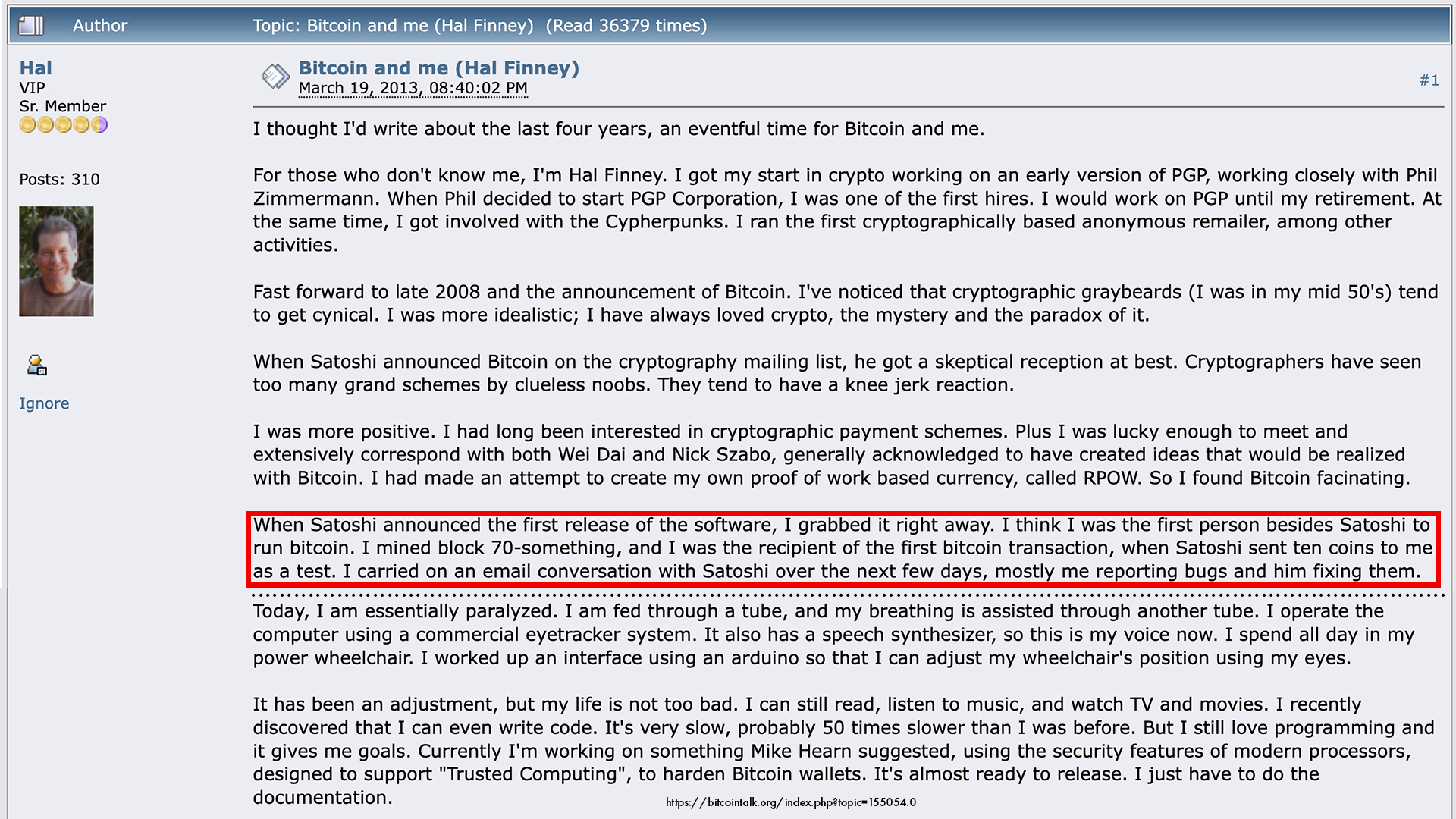
[Transcription of Hal Finney's Bitcoin and Me Bitcointalk post, only relevant parts, not full post]
Bitcoin and me (Hal Finney)
March 19, 2013, 08:40:02 PM
I thought I'd write about the last four years, an eventful time for Bitcoin and me.
For those who don't know me, I'm Hal Finney. I got my start in crypto working on an early version of PGP, working closely with Phil Zimmermann. When Phil decided to start PGP Corporation, I was one of the first hires. I would work on PGP until my retirement. At the same time, I got involved with the Cypherpunks. I ran the first cryptographically based anonymous remailer, among other activities.
Fast forward to late 2008 and the announcement of Bitcoin. I've noticed that cryptographic graybeards (I was in my mid 50's) tend to get cynical. I was more idealistic; I have always loved crypto, the mystery and the paradox of it.
When Satoshi announced Bitcoin on the cryptography mailing list, he got a skeptical reception at best. Cryptographers have seen too many grand schemes by clueless noobs. They tend to have a knee jerk reaction.
I was more positive. I had long been interested in cryptographic payment schemes. Plus I was lucky enough to meet and extensively correspond with both Wei Dai and Nick Szabo, generally acknowledged to have created ideas that would be realized with Bitcoin. I had made an attempt to create my own proof of work based currency, called RPOW. So I found Bitcoin facinating.
When Satoshi announced the first release of the software, I grabbed it right away. I think I was the first person besides Satoshi to run bitcoin. I mined block 70-something, and I was the recipient of the first bitcoin transaction, when Satoshi sent ten coins to me as a test. I carried on an email conversation with Satoshi over the next few days, mostly me reporting bugs and him fixing them.
..........................................................................................................
Today, I am essentially paralyzed. I am fed through a tube, and my breathing is assisted through another tube. I operate the computer using a commercial eyetracker system. It also has a speech synthesizer, so this is my voice now. I spend all day in my power wheelchair. I worked up an interface using an arduino so that I can adjust my wheelchair's position using my eyes.
It has been an adjustment, but my life is not too bad. I can still read, listen to music, and watch TV and movies. I recently discovered that I can even write code. It's very slow, probably 50 times slower than I was before. But I still love programming and it gives me goals. Currently I'm working on something Mike Hearn suggested, using the security features of modern processors, designed to support "Trusted Computing", to harden Bitcoin wallets. It's almost ready to release. I just have to do the documentation.
..........................................................................................................
Source: https://bitcointalk.org/index.php?topic=155054.0
- He was the recipient of the first Bitcoin transaction
- He mined block 70-something
- He thinks he was the first person to join the network (besides Satoshi)
Hal Finney’s Actual Bitcoin Wallet
In 2014, three months before Hal passed away, Andy Greenberg published the “Nakamoto’s Neighbor: My Hunt For Bitcoin’s Creator Led To A Paralyzed Crypto Genius” article in Forbes.
In it, Andy shared that he visited Hal’s home, where Jason Finney (Hal’s son) showed him a screenshot of his father’s Bitcoin wallet.
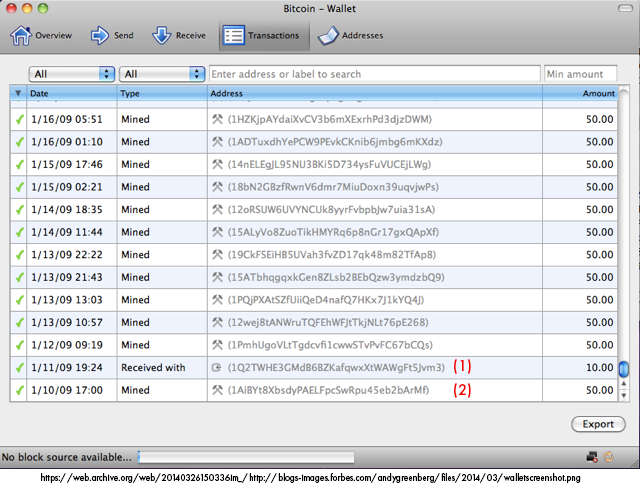
Note: Table of all the transaction information found in the screenshoot
| Date (PST) | Address | Amount | Type |
|---|---|---|---|
| 1/16/09 05:51 | 1HZKjpAYdaiXvCV3b6mXExrhPd3djzDWM | 50 | Mined |
| 1/16/09 01:10 | 1ADTuxdhYePCW9PEvkCKnib6jmbg6mKXdz | 50 | Mined |
| 1/15/09 17:46 | 14nELEgJL95NU3BKi5D734ysFuVUCEjLWg | 50 | Mined |
| 1/15/09 02:21 | 18bN2GBzfRwnV6dmr7MiuDoxn39uqvjwPs | 50 | Mined |
| 1/14/09 18:35 | 12oRSUW6UVYNCUk8yyrFvbpbJw7uia31sA | 50 | Mined |
| 1/14/09 11:44 | 15ALyVo8ZuoTikHMYRq6p8nGr17gxQApXf | 50 | Mined |
| 1/13/09 22:22 | 19CkFSEiHB5UVah3fvZD17qk48m82TfAp8 | 50 | Mined |
| 1/13/09 21:43 | 15ATbhqgqxkGen8ZLsb2BEbQzw3ymdzbQ9 | 50 | Mined |
| 1/13/09 13:03 | 1PQjPXAtSZfUiiQeD4nafQ7HKx7J1kYQ4J | 50 | Mined |
| 1/13/09 10:57 | 12wej8tANWruTQFEhWFJtTkjNLt76pE268 | 50 | Mined |
| 1/12/09 09:19 | 1PmhUgoVLtTgdcvfi1cwwSTvPvFC67bCQs | 50 | Mined |
| 1/11/09 19:24 | 1Q2TWHE3GMdB6BZKafqwxXtWAWgFt5Jvm3 | 10 | Received with |
| 1/10/09 17:00 | 1AiBYt8XbsdyPAELFpcSwRpu45eb2bArMf | 50 | Mined |
Source screenshoot of wallet: Screenshoot: https://imageio.forbes.com/blogs-images/andygreenberg/files/2014/03/walletscreenshot.png?format=png&width=1440
In the screenshot, we see two key things mentioned in Hal’s Bitcointalk post:
The 10 BTC transaction Satoshi sent to Hal (found in Block 170). The timestamp of the transaction is off by ~6 minutes compared to what we see today in the blockchain. Most likely, Hal’s node recorded the time it first saw the transaction in the mempool and didn’t update it after the transaction was confirmed. This was known behavior in early versions of the client. It’s the second transaction from bottom to top in the list
The first block Hal mined, using the address 1AiBYt8XbsdyPAELFpcSwRpu45eb2bArMf. This is the coinbase transaction of Block 78.
In Bitcoin’s early years, coins were sent to both bare public keys and Bitcoin addresses. A Bitcoin address(in the early days) is simply a representation of a public key, made shorter and more human-readable by removing look-alike characters.
However, the Bitcoin client would automatically convert bare public keys into addresses when displaying them. Today we only use addresses, which can make interpreting early data confusing.
Even more so, the same transaction will be displayed differently depending on the block explorer. For example, mempool.space displays what is technically correct, while blockchain.info shows what the early Bitcoin client would have displayed, maintaining visual consistency with the software at the time.
Regardless the TX ID is: 7ea1d2304f1f95fae773ed8ef67b51cfd5ab33ea8b6ab0a932ee3e248b7ba74c
If we accept the screenshot as genuine, it confirms that Hal’s node was connected to the network and successfully mined Block 78.
As for Hal’s belief that he was the second person to join the network after Satoshi, it seems a reasonable assumption, especially given how little interest others showed on the Cryptography Mailing List at the time.
Hal Finney & Satoshi Nakamoto Private Correspondence: Chronological
And now, let’s put all the events into a table for easier viewing.
The events are listed in chronological order, with all timestamps converted to both UTC and PST.
We’re working under the assumption that all private emails are authentic, and considering that they were shared by Hal himself, I personally see no reason to doubt their legitimacy.
Not to mention: if we compare the timestamps of the private emails with public data, we find no meaningful discrepancies or contradictions.
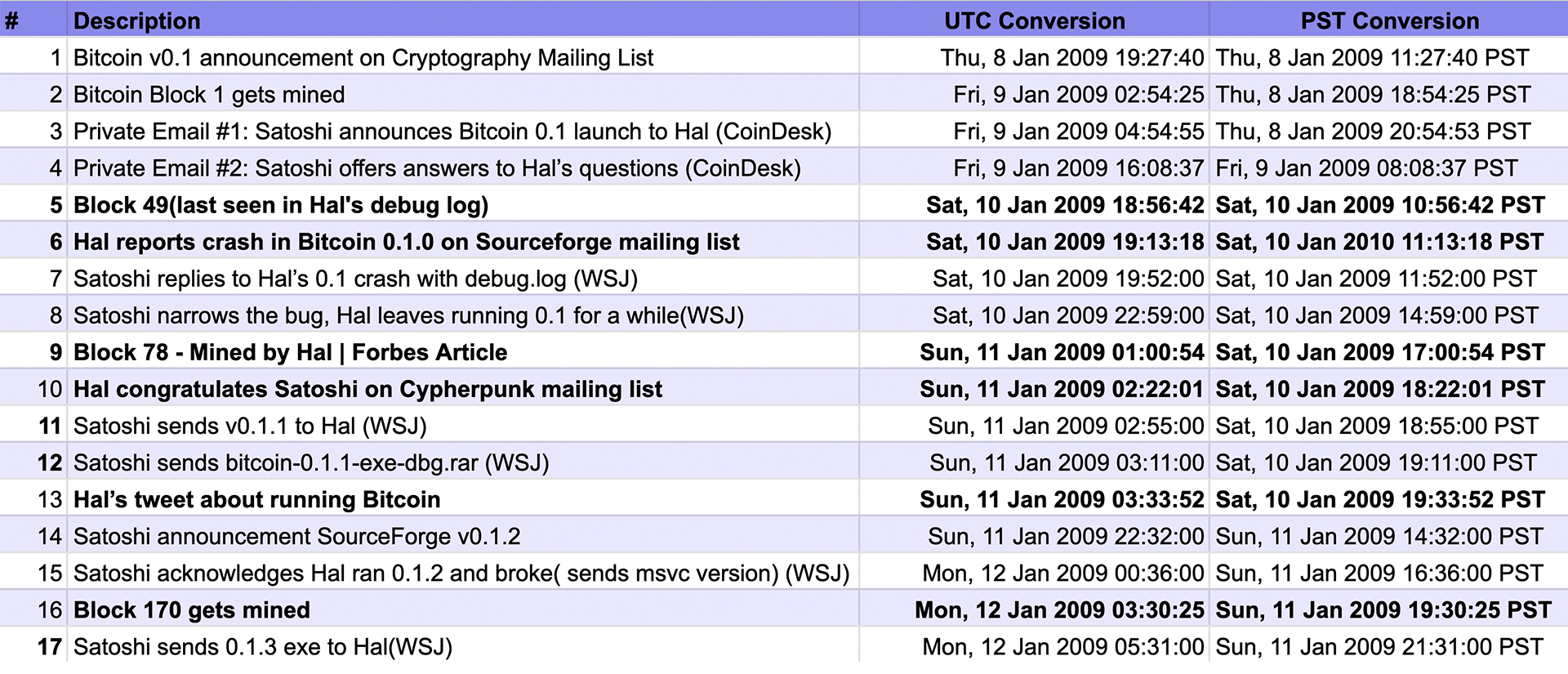
| # | Description | UTC Conversion | PST Conversion |
|---|---|---|---|
| 1 | Bitcoin v0.1 announcement on Cryptography Mailing List | Thu, 8 Jan 2009 19:27:40 | Thu, 8 Jan 2009 11:27:40 PST |
| 2 | Bitcoin Block 1 gets mined | Fri, 9 Jan 2009 02:54:25 | Thu, 8 Jan 2009 18:54:25 PST |
| 3 | Private Email #1: Satoshi announces Bitcoin 0.1 launch to Hal (CoinDesk) | Fri, 9 Jan 2009 04:54:55 | Thu, 8 Jan 2009 20:54:53 PST |
| 4 | Private Email #2: Satoshi offers answers to Hal’s questions (CoinDesk) | Fri, 9 Jan 2009 16:08:37 | Fri, 9 Jan 2009 08:08:37 PST |
| 5 | Block 49 (last seen in Hal’s debug log) | Sat, 10 Jan 2009 18:56:42 | Sat, 10 Jan 2009 10:56:42 PST |
| 6 | Hal reports crash in Bitcoin 0.1.0 on Sourceforge mailing list | Sat, 10 Jan 2009 19:13:18 | Sat, 10 Jan 2010 11:13:18 PST |
| 7 | Satoshi replies to Hal’s 0.1 crash with debug.log (WSJ) | Sat, 10 Jan 2009 19:52:00 | Sat, 10 Jan 2009 11:52:00 PST |
| 8 | Satoshi narrows the bug, Hal leaves running 0.1 for a while (WSJ) | Sat, 10 Jan 2009 22:59:00 | Sat, 10 Jan 2009 14:59:00 PST |
| 9 | Block 78 - Mined by Hal | Forbes Article | Sun, 11 Jan 2009 01:00:54 | Sat, 10 Jan 2009 17:00:54 PST |
| 10 | Hal congratulates Satoshi on Cypherpunk mailing list | Sun, 11 Jan 2009 02:22:01 | Sat, 10 Jan 2009 18:22:01 PST |
| 11 | Satoshi sends v0.1.1 to Hal (WSJ) | Sun, 11 Jan 2009 02:55:00 | Sat, 10 Jan 2009 18:55:00 PST |
| 12 | Satoshi sends bitcoin-0.1.1-exe-dbg.rar (WSJ) | Sun, 11 Jan 2009 03:11:00 | Sat, 10 Jan 2009 19:11:00 PST |
| 13 | Hal’s tweet about running Bitcoin | Sun, 11 Jan 2009 03:33:52 | Sat, 10 Jan 2009 19:33:52 PST |
| 14 | Satoshi announcement SourceForge v0.1.2 | Sun, 11 Jan 2009 22:32:00 | Sun, 11 Jan 2009 14:32:00 PST |
| 15 | Satoshi acknowledges Hal ran 0.1.2 and broke (sends msvc version) (WSJ) | Mon, 12 Jan 2009 00:36:00 | Sun, 11 Jan 2009 16:36:00 PST |
| 16 | Block 170 gets mined | Mon, 12 Jan 2009 03:30:25 | Sun, 11 Jan 2009 19:30:25 PST |
| 17 | Satoshi sends 0.1.3 exe to Hal (WSJ) | Mon, 12 Jan 2009 05:31:00 | Sun, 11 Jan 2009 21:31:00 PST |
So, looking at the table and taking into account all the events we’ve analyzed, we can say with a fairly high degree of certainty that Hal was not the second node to join the Bitcoin network after Satoshi, because:
The first time Hal ran Bitcoin, confirmed by the private emails, the SourceForge post, and the debug.log file, the network had already passed Block 1.
From the private conversations, we can see it took Hal several days to get the Bitcoin client working consistently. He got it running properly around Block 170 (on 12 January), and briefly mined Block 78 (on 11 January).
The Bitcoin client was explicitly programmed not to start producing blocks unless it had at least one connection to another node. Therefore, the fact that the debug.log file contains 49 blocks is proof that other nodes already existed when Hal connected. If he had been the second node, this wouldn’t have been possible.
Any of these three points alone would be enough to support this conclusion. Taken together, they form a consistent and overwhelming case.
The debug.log file is the strongest piece of evidence we have. Not only can it still be downloaded and examined today, but the fact that it contains the hashes of 49 consecutive valid Bitcoin blocks proves that proof-of-work had been done to generate them.
(For reference: using a top-end computer from 2009, all 49 blocks could have been generated in about six and a half hours.)
Hal Finney’s debug.log Deeper Analysis
Still not convinced? Well, there’s more in the debug.log file.
We can clearly see that two nodes were already present in the #bitcoin IRC channel when Hal’s node connected.
Here’s what happened, in chronological order, according to the debug.log:
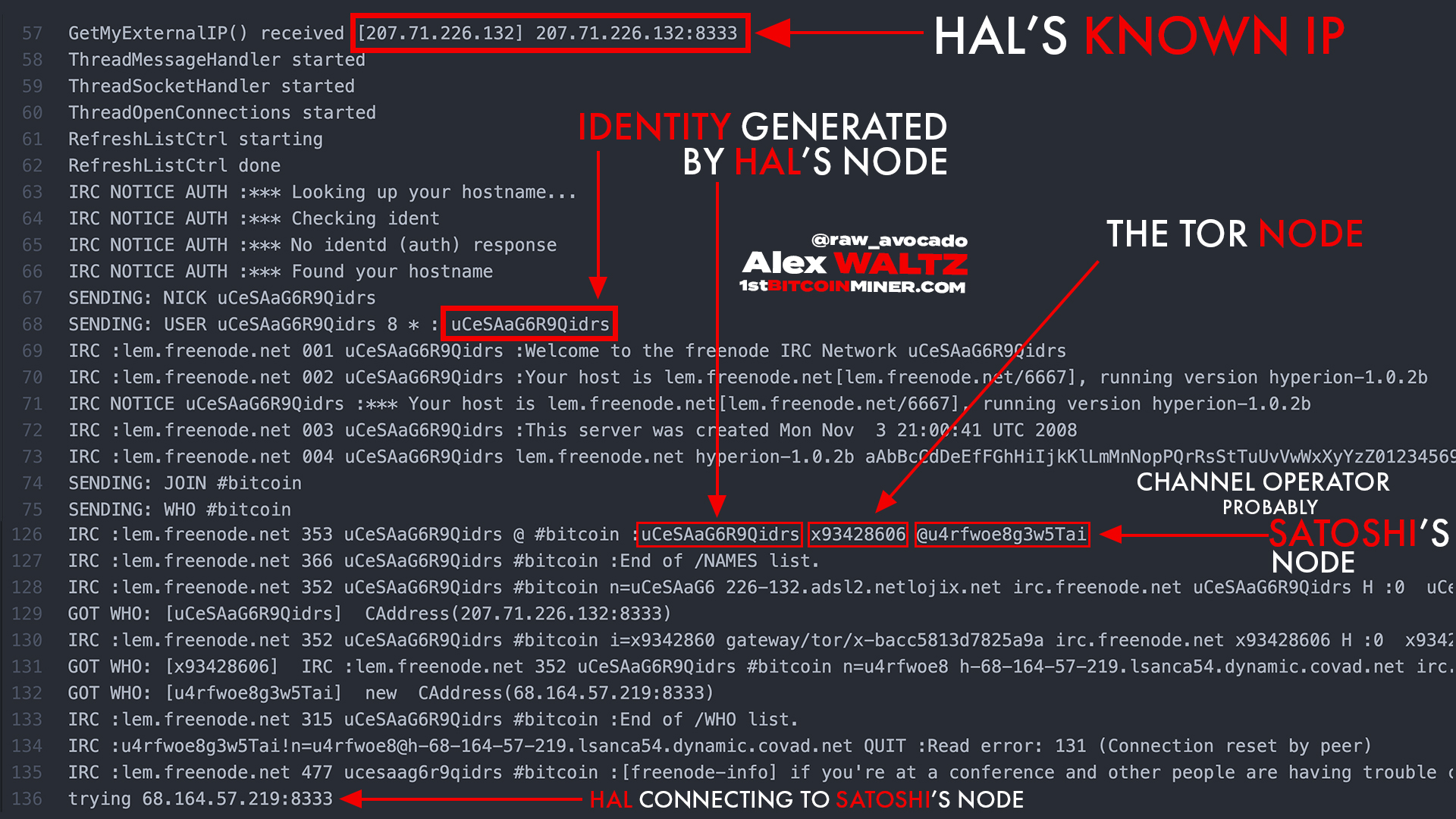
[Transcription of Hal Finney's debug.log file from SourceForge lines 57 to 136]
GetMyExternalIP() received [207.71.226.132] 207.71.226.132:8333
ThreadMessageHandler started
ThreadSocketHandler started
ThreadOpenConnections started
RefreshListCtrl starting
RefreshListCtrl done
IRC NOTICE AUTH :*** Looking up your hostname...
IRC NOTICE AUTH :*** Checking ident
IRC NOTICE AUTH :*** No identd (auth) response
IRC NOTICE AUTH :*** Found your hostname
SENDING: NICK uCeSAaG6R9Qidrs
SENDING: USER uCeSAaG6R9Qidrs 8 * : uCeSAaG6R9Qidrs
IRC :lem.freenode.net 001 uCeSAaG6R9Qidrs :Welcome to the freenode IRC Network uCeSAaG6R9Qidrs
IRC :lem.freenode.net 002 uCeSAaG6R9Qidrs :Your host is lem.freenode.net[lem.freenode.net/6667], running version hyperion-1.0.2b
IRC NOTICE uCeSAaG6R9Qidrs :*** Your host is lem.freenode.net[lem.freenode.net/6667], running version hyperion-1.0.2b
IRC :lem.freenode.net 003 uCeSAaG6R9Qidrs :This server was created Mon Nov 3 21:00:41 UTC 2008
IRC :lem.freenode.net 004 uCeSAaG6R9Qidrs lem.freenode.net hyperion-1.0.2b aAbBcCdDeEfFGhHiIjkKlLmMnNopPQrRsStTuUvVwWxXyYzZ01234569*@ bcdefFhiIklmnoPqstv
SENDING: JOIN #bitcoin
SENDING: WHO #bitcoin
IRC :lem.freenode.net 005 uCeSAaG6R9Qidrs IRCD=dancer CAPAB CHANTYPES=# EXCEPTS INVEX CHANMODES=bdeIq,k,lfJD,cgijLmnPQrRstz CHANLIMIT=#:20 PREFIX=(ov)@+ MAXLIST=bdeI:50 MODES=4 STATUSMSG=@ KNOCK NICKLEN=16 :are supported by this server
IRC :lem.freenode.net 005 uCeSAaG6R9Qidrs SAFELIST CASEMAPPING=ascii CHANNELLEN=30 TOPICLEN=450 KICKLEN=450 KEYLEN=23 USERLEN=10 HOSTLEN=63 SILENCE=50 :are supported by this server
IRC :lem.freenode.net 251 uCeSAaG6R9Qidrs :There are 25590 listed and 21698 unlisted users on 34 servers
IRC :lem.freenode.net 252 uCeSAaG6R9Qidrs 37 :flagged staff members
IRC :lem.freenode.net 254 uCeSAaG6R9Qidrs 27295 :channels formed
IRC :lem.freenode.net 255 uCeSAaG6R9Qidrs :I have 1768 clients and 0 servers
IRC :lem.freenode.net 265 uCeSAaG6R9Qidrs :Current local users: 1768 Max: 2281
IRC :lem.freenode.net 266 uCeSAaG6R9Qidrs :Current global users: 47288 Max: 51553
IRC :lem.freenode.net 250 uCeSAaG6R9Qidrs :Highest connection count: 2282 (2281 clients) (387278 since server was (re)started)
IRC :lem.freenode.net 375 uCeSAaG6R9Qidrs :- lem.freenode.net Message of the Day -
IRC :lem.freenode.net 372 uCeSAaG6R9Qidrs :- LEM, STANISLAW, [1921-2006]. Born in Lwow, Poland, he is the
IRC :lem.freenode.net 372 uCeSAaG6R9Qidrs :- author of numerous books, many of which were translated into
IRC :lem.freenode.net 372 uCeSAaG6R9Qidrs :- 40 languages and sold over 27 million copies. His novels
IRC :lem.freenode.net 372 uCeSAaG6R9Qidrs :- include The Invincible , The Cyberiad and Peace on
IRC :lem.freenode.net 372 uCeSAaG6R9Qidrs :- Earth . His one non-fiction work is Microworlds: Writings
IRC :lem.freenode.net 372 uCeSAaG6R9Qidrs :- on Science Fiction and Fantasy .
IRC :lem.freenode.net 372 uCeSAaG6R9Qidrs :-
IRC :lem.freenode.net 372 uCeSAaG6R9Qidrs :- You're using freenode, a service of Peer-Directed Projects
IRC :lem.freenode.net 372 uCeSAaG6R9Qidrs :- Center (http://freenode.net/pdpc.shtml).
IRC :lem.freenode.net 372 uCeSAaG6R9Qidrs :-
IRC :lem.freenode.net 372 uCeSAaG6R9Qidrs :- By connecting to freenode you indicate that you have read
IRC :lem.freenode.net 372 uCeSAaG6R9Qidrs :- and agree to adhere to our policies and procedures as per
IRC :lem.freenode.net 372 uCeSAaG6R9Qidrs :- the website (http://freenode.net). We would like to remind
IRC :lem.freenode.net 372 uCeSAaG6R9Qidrs :- you that unauthorized public logging of channels on the
IRC :lem.freenode.net 372 uCeSAaG6R9Qidrs :- network is prohibited. Public channel logging should only
IRC :lem.freenode.net 372 uCeSAaG6R9Qidrs :- take place where the channel owner(s) has requested this
IRC :lem.freenode.net 372 uCeSAaG6R9Qidrs :- and users of the channel are all made aware (if you are
IRC :lem.freenode.net 372 uCeSAaG6R9Qidrs :- publically logging your channel, you may wish to keep a
IRC :lem.freenode.net 372 uCeSAaG6R9Qidrs :- notice in topic and perhaps as a on-join message).
IRC :lem.freenode.net 372 uCeSAaG6R9Qidrs :-
IRC :lem.freenode.net 372 uCeSAaG6R9Qidrs :- By registering your nickname with Nickserv you agree that you
IRC :lem.freenode.net 372 uCeSAaG6R9Qidrs :- are 13 years of age, or older. For more information about the
IRC :lem.freenode.net 372 uCeSAaG6R9Qidrs :- Children's Online Privacy Protection Act please see their
IRC :lem.freenode.net 372 uCeSAaG6R9Qidrs :- website at (http://www.coppa.org).
IRC :lem.freenode.net 372 uCeSAaG6R9Qidrs :-
IRC :lem.freenode.net 372 uCeSAaG6R9Qidrs :- freenode runs an open proxy scanner. Your use of the network
IRC :lem.freenode.net 372 uCeSAaG6R9Qidrs :- indicates your acceptance of this policy. For details on
IRC :lem.freenode.net 372 uCeSAaG6R9Qidrs :- freenode network policy, please take a look at our policy
IRC :lem.freenode.net 372 uCeSAaG6R9Qidrs :- page (http://freenode.net/policy.shtml). Thank you for using
IRC :lem.freenode.net 372 uCeSAaG6R9Qidrs :- the network!
IRC :lem.freenode.net 372 uCeSAaG6R9Qidrs :-
IRC :lem.freenode.net 372 uCeSAaG6R9Qidrs :- freenode is a service of Peer-Directed Projects Center, an
IRC :lem.freenode.net 372 uCeSAaG6R9Qidrs :- IRS 501(c)(3) not-for-profit organization. Our yearly
IRC :lem.freenode.net 372 uCeSAaG6R9Qidrs :- fundraiser will begin soon; if you'd like to donate early,
IRC :lem.freenode.net 372 uCeSAaG6R9Qidrs :- please see http://freenode.net/pdpc_donations.shtml for more
IRC :lem.freenode.net 372 uCeSAaG6R9Qidrs :- information. Thank you for using freenode!
IRC :lem.freenode.net 376 uCeSAaG6R9Qidrs :End of /MOTD command.
IRC :freenode-connect!freenode@freenode/bot/connect PRIVMSG ucesaag6r9qidrs :VERSION
IRC :uCeSAaG6R9Qidrs!n=uCeSAaG6@226-132.adsl2.netlojix.net JOIN :#bitcoin
GOT JOIN: [uCeSAaG6R9Qidrs] CAddress(207.71.226.132:8333)
IRC :lem.freenode.net 353 uCeSAaG6R9Qidrs @ #bitcoin :uCeSAaG6R9Qidrs x93428606 @u4rfwoe8g3w5Tai
IRC :lem.freenode.net 366 uCeSAaG6R9Qidrs #bitcoin :End of /NAMES list.
IRC :lem.freenode.net 352 uCeSAaG6R9Qidrs #bitcoin n=uCeSAaG6 226-132.adsl2.netlojix.net irc.freenode.net uCeSAaG6R9Qidrs H :0 uCeSAaG6R9Qidrs
GOT WHO: [uCeSAaG6R9Qidrs] CAddress(207.71.226.132:8333)
IRC :lem.freenode.net 352 uCeSAaG6R9Qidrs #bitcoin i=x9342860 gateway/tor/x-bacc5813d7825a9a irc.freenode.net x93428606 H :0 x93428606
GOT WHO: [x93428606] IRC :lem.freenode.net 352 uCeSAaG6R9Qidrs #bitcoin n=u4rfwoe8 h-68-164-57-219.lsanca54.dynamic.covad.net irc.freenode.net u4rfwoe8g3w5Tai H@ :0 u4rfwoe8g3w5Tai
GOT WHO: [u4rfwoe8g3w5Tai] new CAddress(68.164.57.219:8333)
IRC :lem.freenode.net 315 uCeSAaG6R9Qidrs #bitcoin :End of /WHO list.
IRC :u4rfwoe8g3w5Tai!n=u4rfwoe8@h-68-164-57-219.lsanca54.dynamic.covad.net QUIT :Read error: 131 (Connection reset by peer)
IRC :lem.freenode.net 477 ucesaag6r9qidrs #bitcoin :[freenode-info] if you're at a conference and other people are having trouble connecting, please mention it to staff: http://freenode.net/faq.shtml#gettinghelp
trying 68.164.57.219:8333
When Hal’s node connected to the IRC server, it registered itself with the username: uCeSAaG6R9Qidrs. (line 69 in the file)
The Bitcoin client constructed this username by prepending a "u" to its IP address and port, and then encoding everything in Base58 (the same format used for Bitcoin addresses, which eliminates look-alike characters). (By the way, if you want to recreate this, keep in mind that big-endian is used because of networking conventions.)
We can see this logic implemented in the irc.cpp file of the source code:
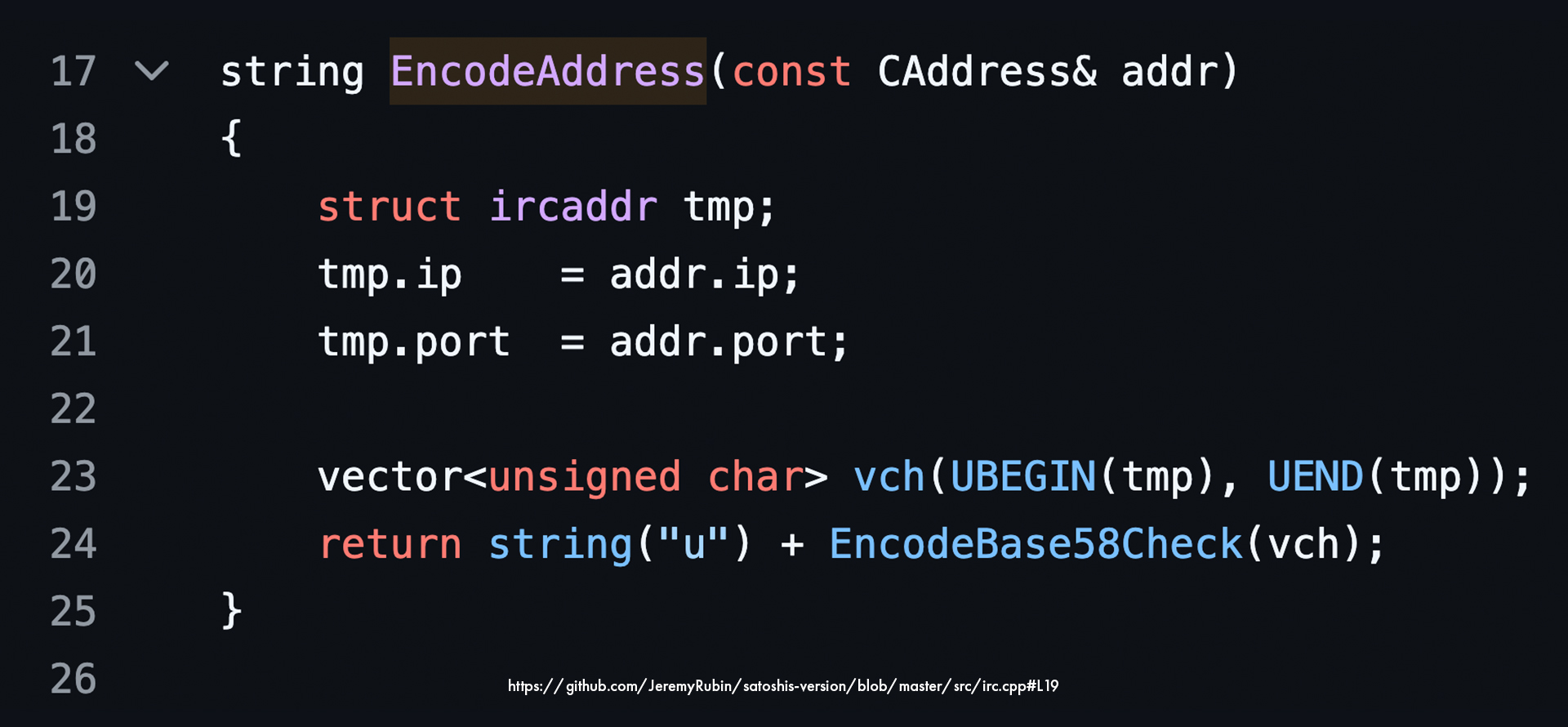
//# Code snipped of original Satoshi client from Jeremy Rubin's github repository that has aditional comments
string EncodeAddress(const CAddress& addr)
{
struct ircaddr tmp;
tmp.ip = addr.ip;
tmp.port = addr.port;
vector<unsigned char> vch(UBEGIN(tmp), UEND(tmp));
return string("u") + EncodeBase58Check(vch);
}
Source: https://github.com/JeremyRubin/satoshis-version/blob/master/src/irc.cpp#L19
Then, the IRC server communicated the list of members present in the channel using the generated identities (usernames) the nodes had created for themselves (line 126):
uCeSAaG6R9Qidrs– Hal’s nodex93428606– A node behind Tor@u4rfwoe8g3w5Tai– An operator of the channel (indicated by the@prefix). Who else would be the operator at this early stage, if not Satoshi?
The first IP address we see in the log is definitively Hal’s, as it’s publicly known that he hosted his website under:
207.71.226.132
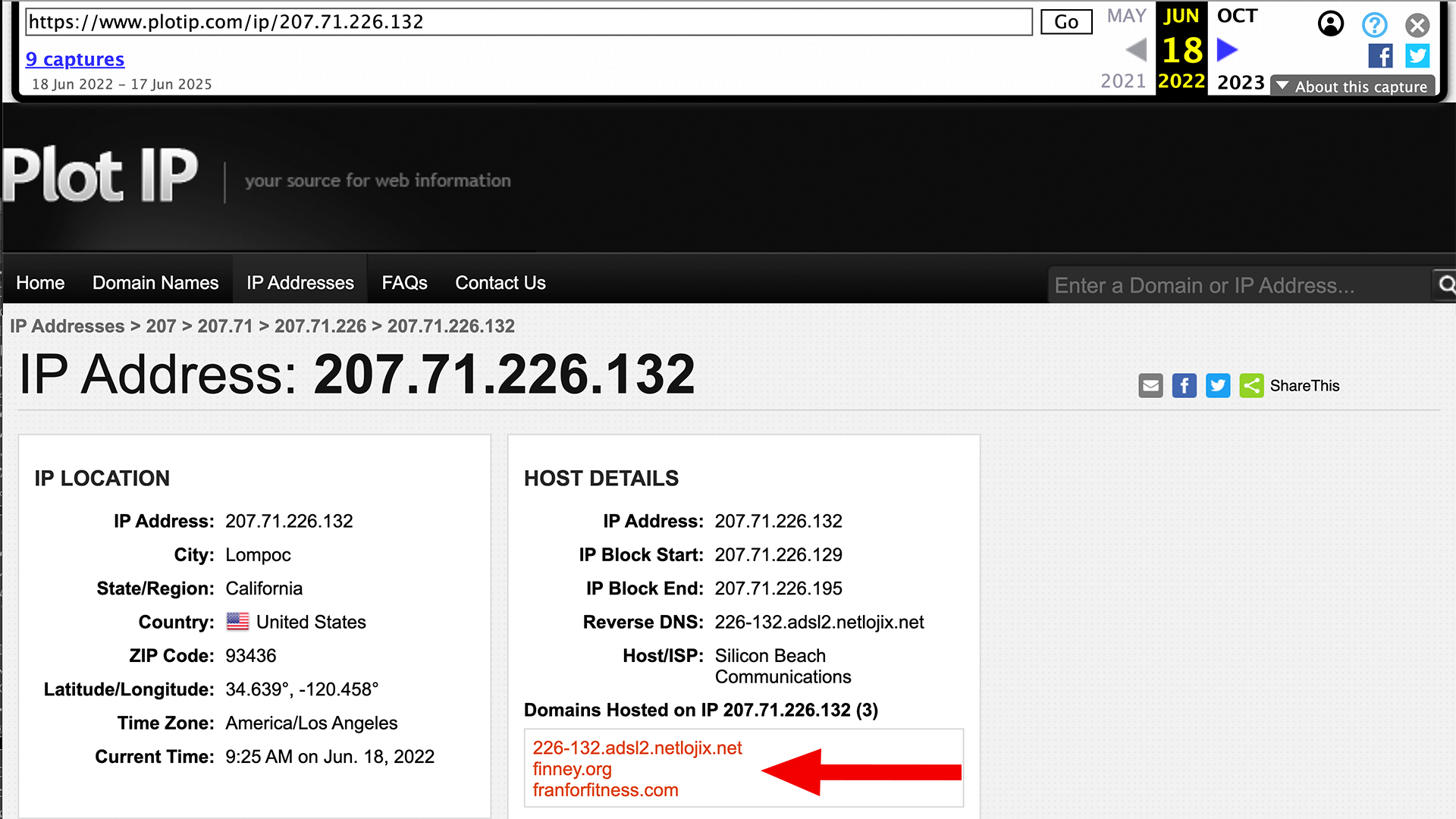
[Transcription of www.plotip.com query on 207.71.226.132, web archive snapshoot June 18 2022]
IP Addresses > 207 > 207.71 > 207.71.226 > 207.71.226.132
IP Address: 207.71.226.132
IP Location
IP Address: 207.71.226.132
City: Lompoc
State/Region: California
Country: United States
ZIP Code: 93436
Latitude/Longitude: 34.639°, -120.458°
Time Zone: America/Los Angeles
Current Time: 9:25 AM on Jun. 18, 2022
Host Details
IP Address: 207.71.226.132
IP Block Start: 207.71.226.129
IP Block End: 207.71.226.195
Reverse DNS: 226-132.adsl2.netlojix.net
Host/ISP: Silicon Beach Communications
Domains Hosted on IP 207.71.226.132 (3)
226-132.adsl2.netlojix.net
finney.org
franforfitness.com
Source: https://web.archive.org/web/20220618162516/https://www.plotip.com/ip/207.71.226.132
Also, the encoding of Hal’s IP address with port 8333 matches the username uCeSAaG6R9Qidrs
The second node, x93428606 is using a Tor identity, something clearly indicated in the debug.log file.
Because the node was using Tor, it would not be able to accept incoming connections, meaning it couldn’t allow other nodes to connect to it, and was therefore non-routable. As a result, its username starts with an "x" as the first character, and the rest of the characters are randomly generated. This behavior is confirmed in the irc.cpp file.

//# Code snipped of original Satoshi client from Jeremy Rubin's github repository that has aditional comments
string strMyName = EncodeAddress(addrLocalHost);
//# Pick a random nickname if our address isn't routable
if (!addrLocalHost.IsRoutable())
strMyName = strprintf("x%u", GetRand(1000000000));
Source: https://github.com/JeremyRubin/satoshis-version/blob/master/src/irc.cpp#L176
The third user — the channel operator — is connected via the clearnet IP 68.164.57.219, which Hal’s node connects to (as shown in the last line of the debug file screenshot).
This IP, when combined with port 8333, also encodes to the correct username: u4rfwoe8g3w5Tai.
By the way, I’m not the first person to point out that the
debug.logfile contains Satoshi’s clearnet IP. However, both of the following sources incorrectly claim that the Tor user was the channel operator:
So, considering the presence of these two other nodes, along with the other evidence presented earlier, we can conclude with very high confidence that Hal was NOT the second node to join the Bitcoin network.
But this opens a new question: who was the node running behind Tor?
If the Tor node was also operated by Satoshi, then Hal would have been the second person (with Satoshi being the first) to join the network. If it was someone else, then Hal would have been the third person.
I want to reiterate a very important distinction: Two nodes ≠ two people. It’s very easy for one person to run multiple nodes.
Whatever the case may be, this doesn’t take anything away from Hal. It’s not like this was his only contribution, in fact, far from it.
He was an accomplished cryptographer, but more importantly, he:
- Offered suggestions on how Bitcoin should work before launch
- Was one of the very few who engaged with Satoshi publicly
- Remained a prolific contributor even after Bitcoin launched
Had Hal not participated during these early stages — whether as the second, third, or Nth participant — there’s a very real chance Bitcoin might never have taken off.
And come on, getting bumped from the second to the third node on the Bitcoin network isn’t exactly a tragedy.
So who ran Bitcoin before Hal Finney?
The presence of the Tor node before Hal doesn’t necessarily mean it started the network alongside Satoshi, it simply means it was present when Hal’s node joined.
So, do I have another contender for the second participant to join the Bitcoin network?
Who is Dustin Trammell?
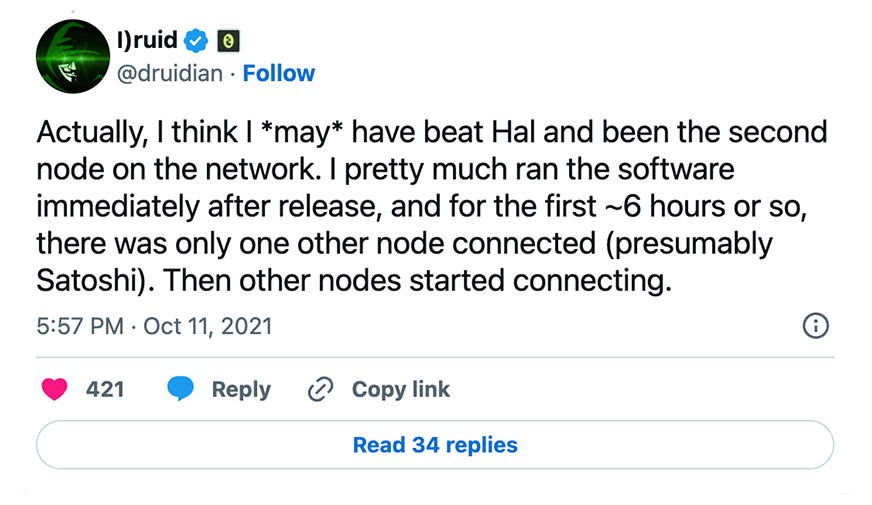
Source: https://x.com/druidian/status/1447607399720890370
[Transcription of Dustin Tramell Tweet October 11 2021]
I)ruid @druidian
Actually, I think I *may* have beat Hal and been the second node on the network. I pretty much ran the software immediately after release, and for the first ~6 hours or so, there was only one other node connected (presumably Satoshi). Then other nodes started connecting.
5:57 PM · Oct 11, 2021
Dustin Trammell is well known in the Bitcoin community and is still active today. More importantly, he’s been very transparent about his early involvement in Bitcoin.
Because of his early involvement, many people have speculated that he might be Satoshi Nakamoto. In response to these lazy speculations, Dustin publicly shared the private emails he exchanged with Satoshi. Given that these conversations occurred very close in time to the events we’ve analyzed, they’re highly relevant to our investigation.
We’ll again proceed under the assumption that these emails are authentic and unmodified.
FWIW, even though I don’t know Dustin personally, based on how he has participated in the community, I have zero reason to believe these emails have been tampered with.
You can find the emails on his personal blog: https://blog.dustintrammell.com/i-am-not-satoshi/
Direct link to the ZIP archive: https://koi-reindeer-77pb.squarespace.com/s/Satoshi_Nakamoto.zip
You can open them in any text editor, they contain the full email bodies.
The first email is Dustin’s response to the Bitcoin v0.1 announcement that Satoshi made. Dustin’s email server logged Satoshi’s message at: Fri, 2009-01-09 at 03:27 +0800 = 2009-01-08 19:27 UTC
This is about 40 seconds off from the timestamp we see on the Cryptography Mailing List. Which is normal, as email propagation often introduces slight delays.
Below is Dustin’s response to Satoshi’s announcement: Sun, 11 Jan 2009 23:14:04 -0600 -> 12 January 2009 05:14:04 UTC. This was approximately two hours after Block 170 was mined — the block where Satoshi sent Hal 10 bitcoins.
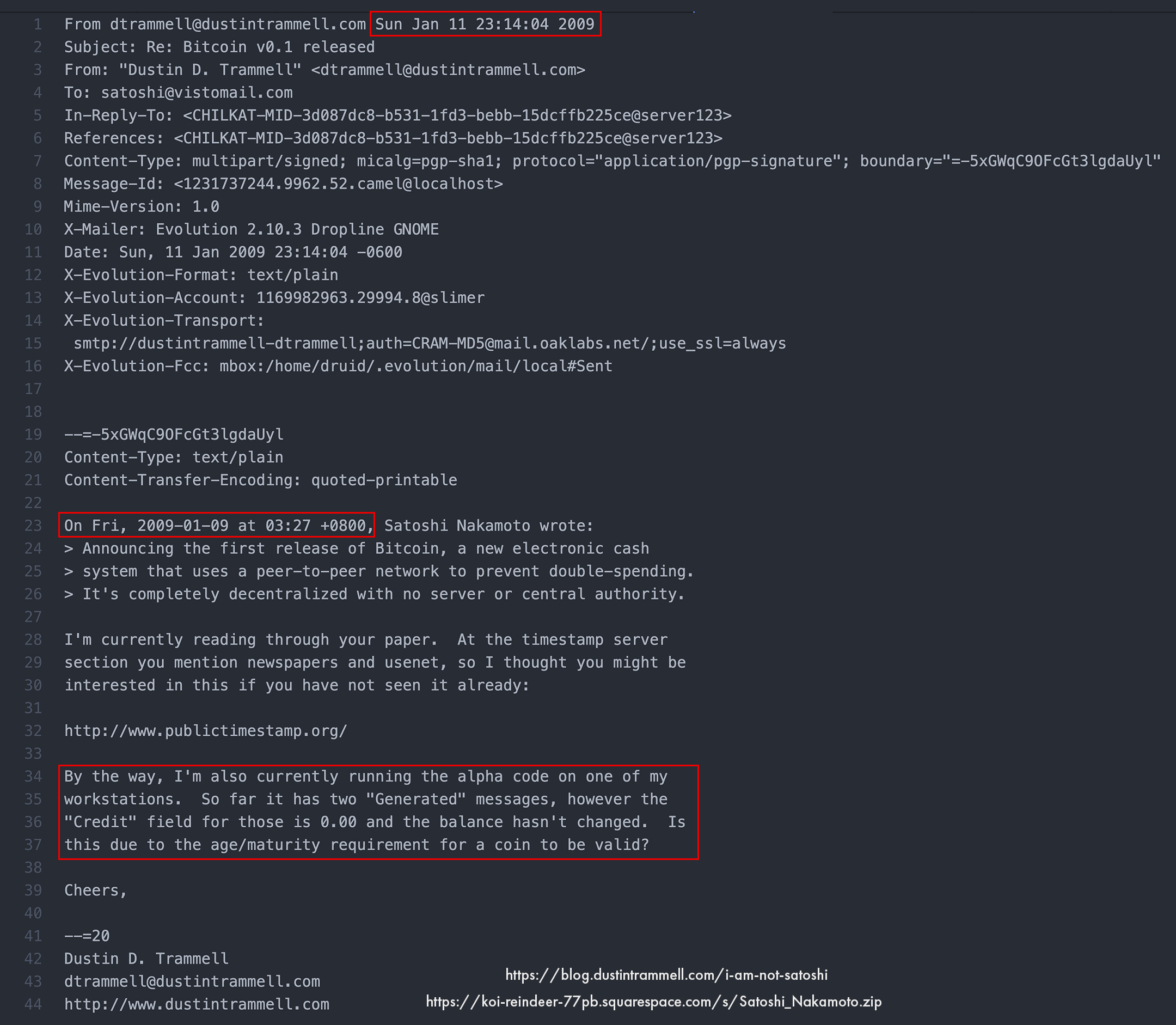
[Transcription of Dustin Tramell - Satoshi Nakamoto Private emails 1]
From dtrammell@dustintrammell.com Sun Jan 11 23:14:04 2009
Subject: Re: Bitcoin v0.1 released
From: "Dustin D. Trammell" <dtrammell@dustintrammell.com>
To: satoshi@vistomail.com
In-Reply-To: <CHILKAT-MID-3d087dc8-b531-1fd3-bebb-15dcffb225ce@server123>
References: <CHILKAT-MID-3d087dc8-b531-1fd3-bebb-15dcffb225ce@server123>
Content-Type: multipart/signed; micalg=pgp-sha1; protocol="application/pgp-signature"; boundary="=-5xGWqC9OFcGt3lgdaUyl"
Message-Id: <1231737244.9962.52.camel@localhost>
Mime-Version: 1.0
X-Mailer: Evolution 2.10.3 Dropline GNOME
Date: Sun, 11 Jan 2009 23:14:04 -0600
X-Evolution-Format: text/plain
X-Evolution-Account: 1169982963.29994.8@slimer
X-Evolution-Transport:
smtp://dustintrammell-dtrammell;auth=CRAM-MD5@mail.oaklabs.net/;use_ssl=always
X-Evolution-Fcc: mbox:/home/druid/.evolution/mail/local#Sent
--=-5xGWqC9OFcGt3lgdaUyl
Content-Type: text/plain
Content-Transfer-Encoding: quoted-printable
On Fri, 2009-01-09 at 03:27 +0800, Satoshi Nakamoto wrote:
> Announcing the first release of Bitcoin, a new electronic cash
> system that uses a peer-to-peer network to prevent double-spending.
> It's completely decentralized with no server or central authority.
I'm currently reading through your paper. At the timestamp server
section you mention newspapers and usenet, so I thought you might be
interested in this if you have not seen it already:
http://www.publictimestamp.org/
By the way, I'm also currently running the alpha code on one of my
workstations. So far it has two "Generated" messages, however the
"Credit" field for those is 0.00 and the balance hasn't changed. Is
this due to the age/maturity requirement for a coin to be valid?
Cheers,
--=20
Dustin D. Trammell
dtrammell@dustintrammell.com
http://www.dustintrammell.com
In the email, Dustin mentions that he was running the Bitcoin client and received two “Generated” messages (meaning he mined two blocks) but his balance still showed zero (i.e., the blocks were not yet confirmed).
As noted earlier, Dustin has always been very transparent about his early involvement in Bitcoin and has shared information with the community. In 2021, he published two separate proofs, each containing:
- A Bitcoin address
- A message that was signed
- A cryptographic signature of that message
This is the same type of cryptography used on the blockchain to prove ownership of a private key linked to a Bitcoin address, only here, instead of signing a transaction, Dustin signed a text message.
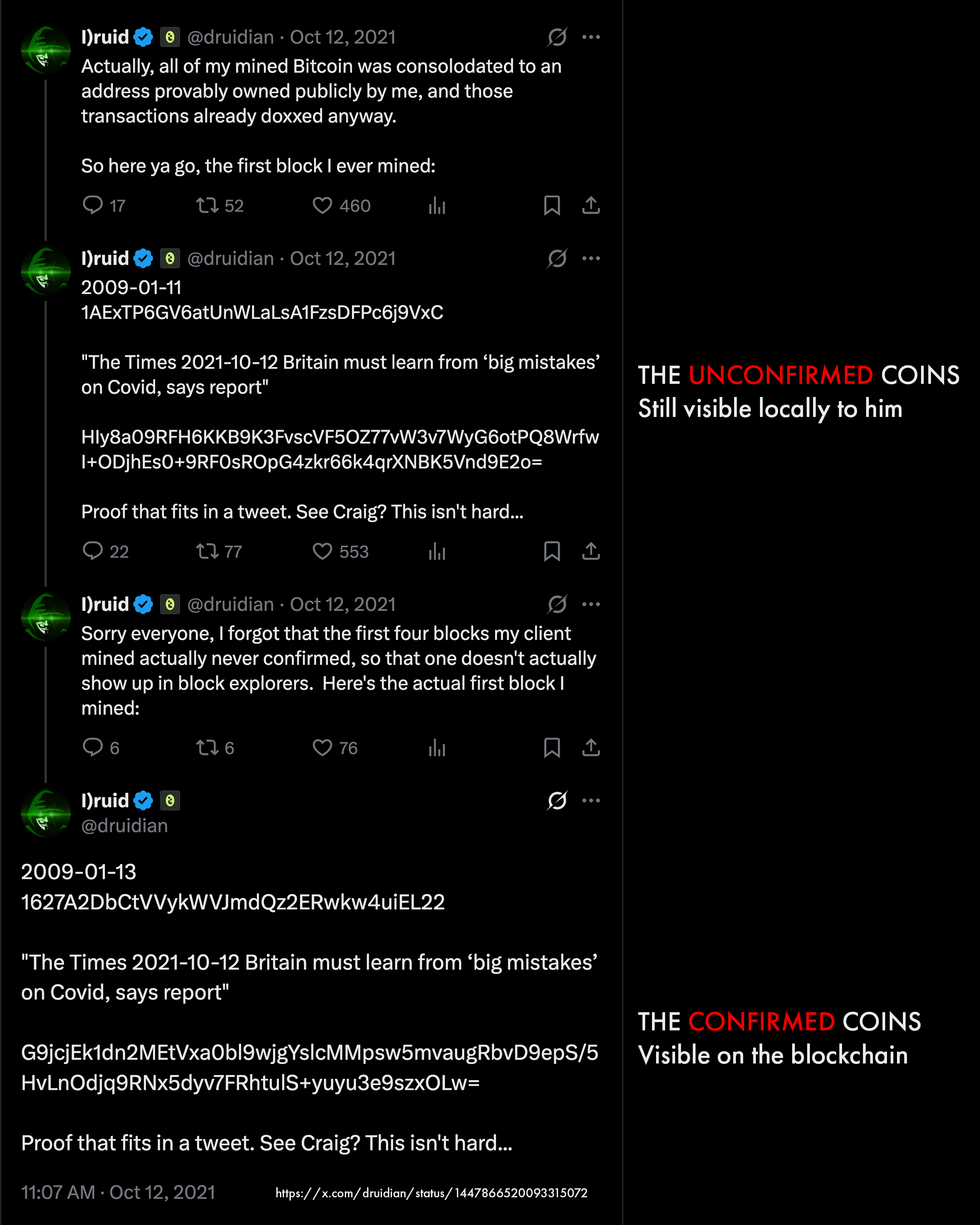
[Transcription of 4 tweets made by Dustin Tramell]
I)ruid @druidian · Oct 12, 2021
Actually, all of my mined Bitcoin was consolodated to an address provably owned publicly by me, and those transactions already doxxed anyway.
So here ya go, the first block I ever mined:
I)ruid @druidian · Oct 12, 2021
2009-01-11
1AExTP6GV6atUnWLaLsA1FzsDFPc6j9VxC
"The Times 2021-10-12 Britain must learn from ‘big mistakes’ on Covid, says report"
HIy8a09RFH6KKB9K3FvscVF5OZ77vW3v7WyG6otPQ8WrfwI+ODjhEs0+9RF0sROpG4zkr66k4qrXNBK5Vnd9E2o=
Proof that fits in a tweet. See Craig? This isn't hard...
I)ruid @druidian · Oct 12, 2021
Sorry everyone, I forgot that the first four blocks my client mined actually never confirmed, so that one doesn't actually show up in block explorers. Here's the actual first block I mined:
I)ruid @druidian 11:07 AM · Oct 12, 2021
2009-01-13
1627A2DbCtVVykWVJmdQz2ERwkw4uiEL22
"The Times 2021-10-12 Britain must learn from ‘big mistakes’ on Covid, says report"
G9jcjEk1dn2MEtVxa0bl9wjgYslcMMpsw5mvaugRbvD9epS/5HvLnOdjq9RNx5dyv7FRhtulS+yuyu3e9szxOLw=
Proof that fits in a tweet. See Craig? This isn't hard...
Source: https://x.com/druidian/status/1447866520093315072
Again, we see Dustin referencing the same unconfirmed transactions (which, of course, do not appear on the blockchain), along with another address dated 13 January. (For reference, Block #1 was mined on 9 January.)
This address did successfully mine bitcoins, and the signature matches, fully consistent with what Dustin described in the email.
As for the unconfirmed coins, we’ll explore what happened to them later.
Verifying Dustin Trammell’s Cryptographic Proof
One thing we can be 100% certain of is that Dustin controls the private key for the address that mined the 50 BTC coinbase reward on 13 January 2009, as he has provided valid cryptographic proof.
Let’s take a look at that proof:
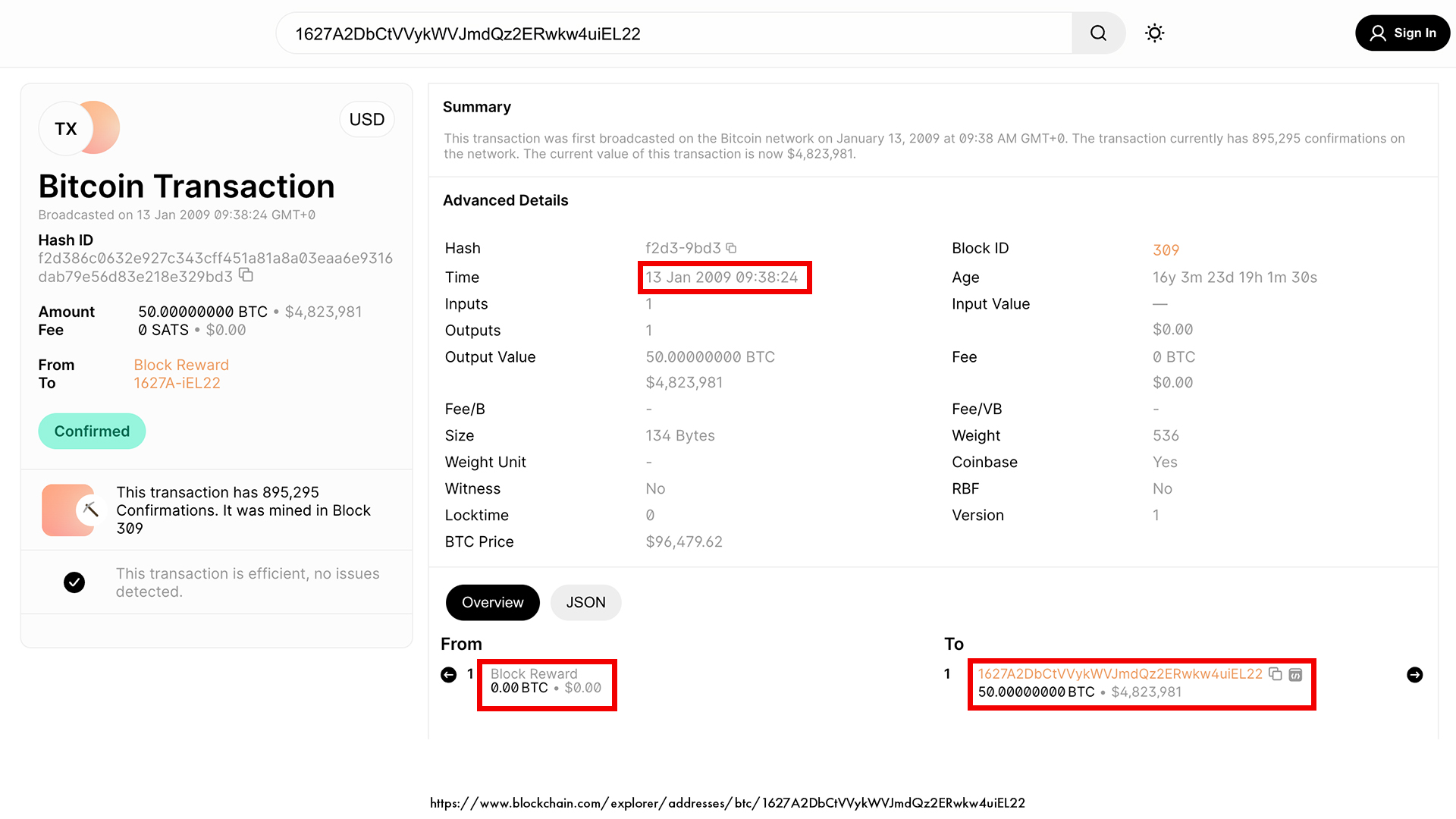
[Transcription of transaction f2d386c0632e927c343cff451a81a8a03eaa6e9316dab79e56d83e218e329bd3 from blockchain.com block explorer]
Bitcoin Transaction Broadcasted on 13 Jan 2009 09:38:24 GMT+0
Hash ID: f2d386c0632e927c343cff451a81a8a03eaa6e9316dab79e56d83e218e329bd3
Amount: 50.00000000 BTC ($5,782,277)
Fee: 0 SATS ($0.00)
From: Block Reward
This transaction has 906,759 confirmations.
It was mined in Block 309.
This transaction was first broadcasted on the Bitcoin network on 13 January 2009 at 09:38 AM GMT+0.
It currently has 906,759 confirmations on the network.
The current value of this transaction is $5,782,277.
Hash: f2d3-9bd3
Block ID: 309
Time: 13 Jan 2009 09:38:24
Age: 16 years, 6 months, 11 days, 20 hours, 10 minutes, 21 seconds
Inputs: 1
Input Value: — ($0.00)
Outputs: 1
Output Value: 50.00000000 BTC ($5,782,277)
Fee: 0 BTC ($0.00)
Fee/B: –
Fee/VB: –
Size: 134 Bytes
Weight: 536
Weight Unit: –
Coinbase: Yes
Witness: No
RBF: No
Locktime: 0
Version: 1
BTC Price: $115,645
From:
Index 1
Block Reward
0.00 BTC ($0.00)
To:
Index 1
1627A2DbCtVVykWVJmdQz2ERwkw4uiEL22
50.00000000 BTC ($5,782,277)
We can see that the address 1627A2DbCtVVykWVJmdQz2ERwkw4uiEL22 (the second example in Dustin’s tweets) did indeed mine 50 bitcoins on 13 January 2009, as indicated by the fact that this was a block reward.
This transaction was sent to a bare public key, so if you view it on mempool.space, it will look different. However, to verify it in Bitcoin Core, we need to convert the public key to a Bitcoin address, which is what blockchain.com displays.
And when we paste the signature, message, and address Dustin shared in his 2021 tweet into Bitcoin Core, we can confirm that he was telling the truth.
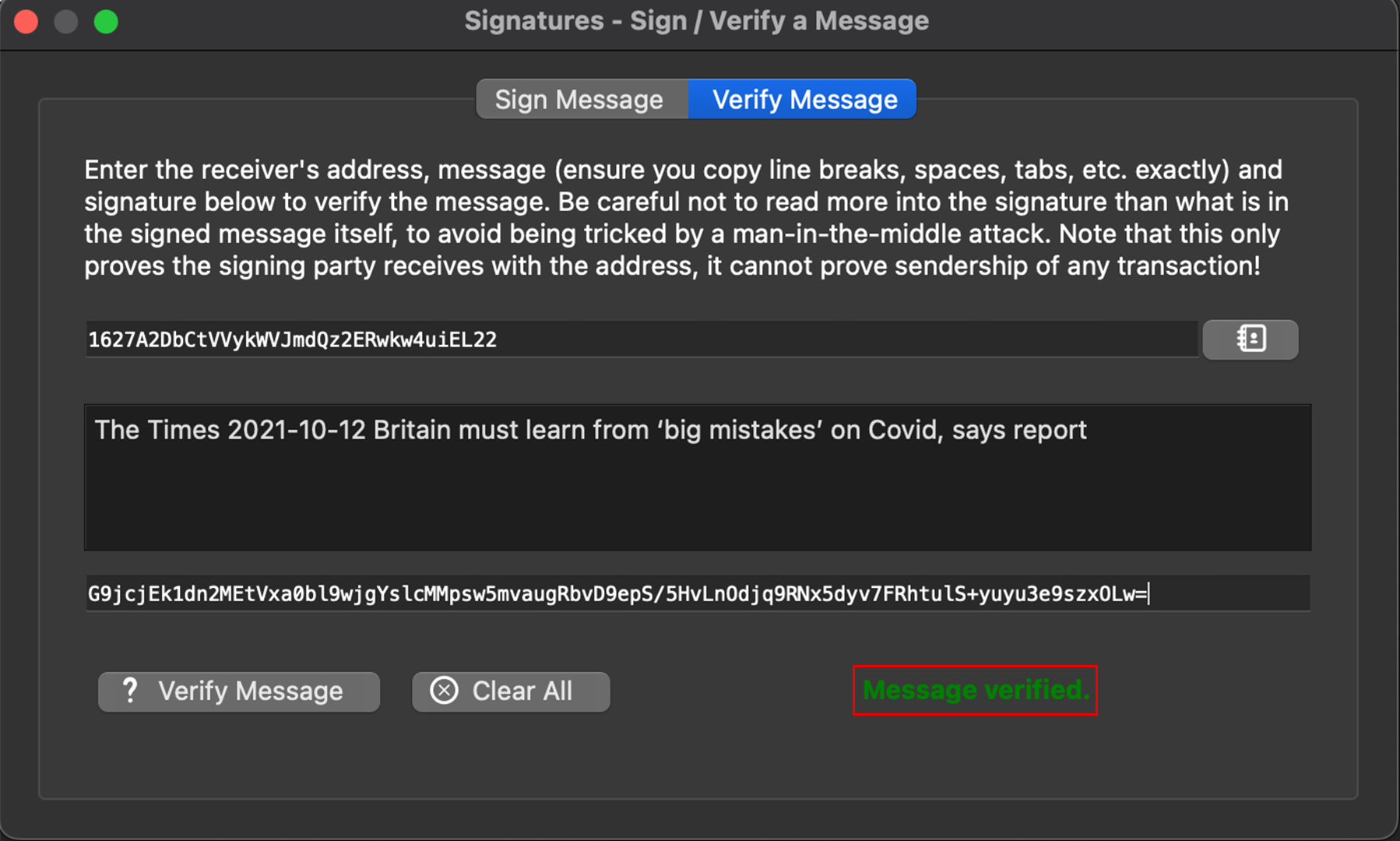
[Transcription Bitcoin Core Verify Mesage screen]
Instructions (visible in the UI):
Enter the receiver's address, message (ensure you copy line breaks, spaces, tabs, etc. exactly) and signature below to verify the message. Be careful not to read more into the signature than what is in the signed message itself, to avoid being tricked by a man-in-the-middle attack. Note that this only proves the signing party receives with the address, it cannot prove sendership of any transaction!
Address Field:
1627A2DbCtVVykWVJmdQz2ERwkw4uiEL22
Message Field:
The Times 2021-10-12 Britain must learn from ‘big mistakes’ on Covid, says report
Signature Field:
G9jcjEk1dn2MEtVxa0bL9wjgYsLcMMpsw5mvaugRbvD9epS/5HvLn0djq9RNx5dyv7FRhtu1S+yuyu3e9szx0Lw=
Verification Result (in green text):
Message verified.
This is great to see, and the block in question, Block 309, is indeed very early. However, it’s still not earlier than:
- Block 49 (seen in Hal’s debug log)
- Block 78 (mined by Hal)
- Or even Block 170 (when Satoshi sent Hal the 10 BTC)
Let’s dig further into the Dustin–Satoshi emails.
On 12 Jan 2009 21:29:52 -0600 -> January 13, 2009 at 03:29:52 UTC, Dustin confirms he was running Bitcoin v0.1.1, when Satoshi advised him to update to v0.1.3, the version that finally worked for Hal.
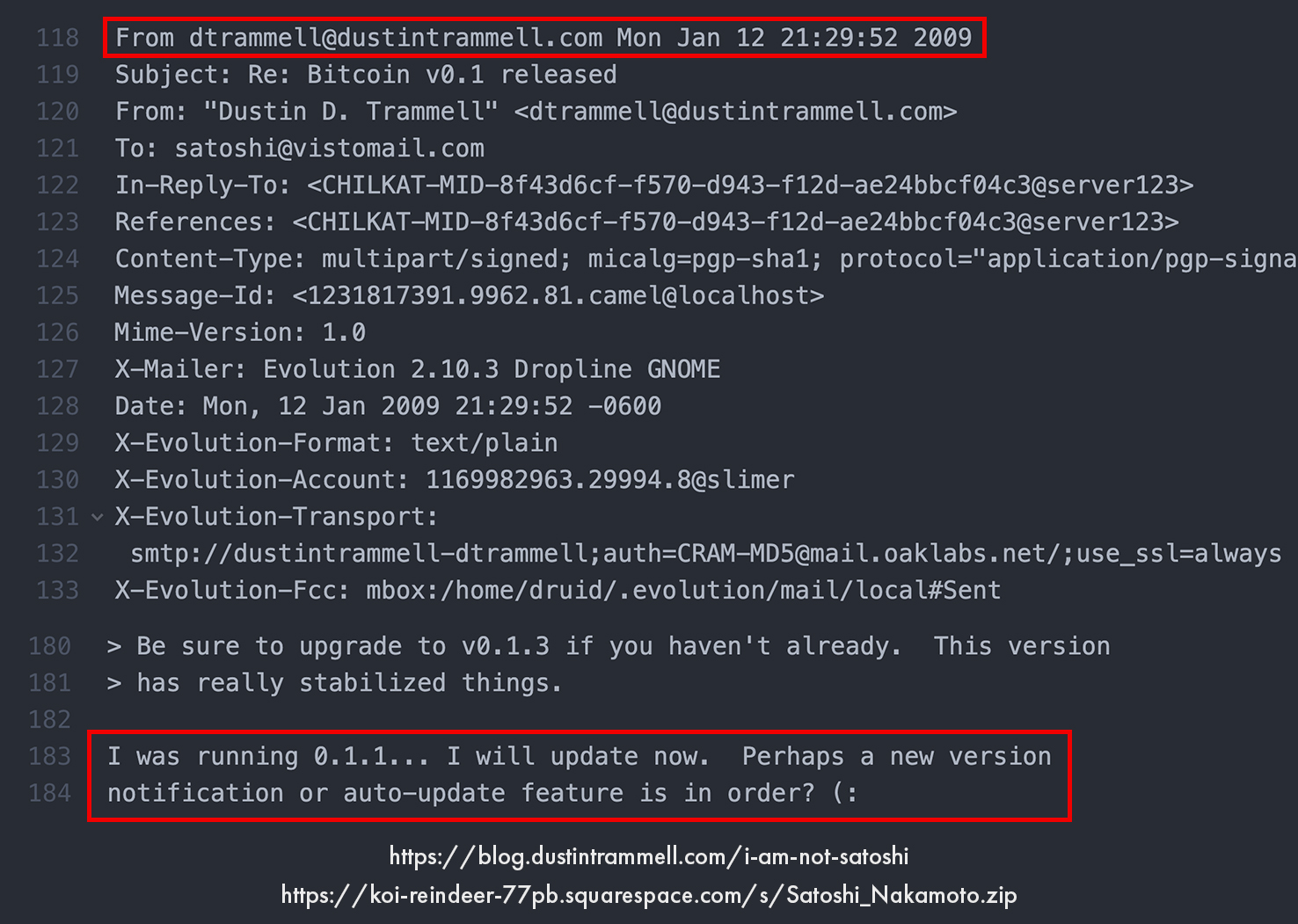
[Transcription of Dustin Tramell - Satoshi Nakamoto Private emails 2, only header and relevant text]
From dtrammell@dustintrammell.com Mon Jan 12 21:29:52 2009
Subject: Re: Bitcoin v0.1 released
From: "Dustin D. Trammell" <dtrammell@dustintrammell.com>
To: satoshi@vistomail.com
In-Reply-To: <CHILKAT-MID-8f43d6cf-f570-d943-f12d-ae24bbcf04c3@server123>
References: <CHILKAT-MID-8f43d6cf-f570-d943-f12d-ae24bbcf04c3@server123>
Content-Type: multipart/signed; micalg=pgp-sha1; protocol="application/pgp-signature"; boundary="=-Yoe6vqiBGHlFKYIj3aWW"
Message-Id: <1231817391.9962.81.camel@localhost>
Mime-Version: 1.0
X-Mailer: Evolution 2.10.3 Dropline GNOME
Date: Mon, 12 Jan 2009 21:29:52 -0600
X-Evolution-Format: text/plain
X-Evolution-Account: 1169982963.29994.8@slimer
X-Evolution-Transport:
smtp://dustintrammell-dtrammell;auth=CRAM-MD5@mail.oaklabs.net/;use_ssl=always
X-Evolution-Fcc: mbox:/home/druid/.evolution/mail/local#Sent
> Be sure to upgrade to v0.1.3 if you haven't already. This version
> has really stabilized things.
I was running 0.1.1... I will update now. Perhaps a new version
notification or auto-update feature is in order? (:
On 13 Jan 2009 07:55:20 -0000 UTC, Satoshi addresses Dustin’s issue with the unconfirmed coins. He confirms that it was a bug in pre-v0.1.3 versions, where the client would become blocked after some time, and although it appeared to remain connected to the network, it was no longer able to communicate with other nodes.
So, if Dustin did mine two blocks, the client was likely unable to broadcast them, which is why they were never confirmed.
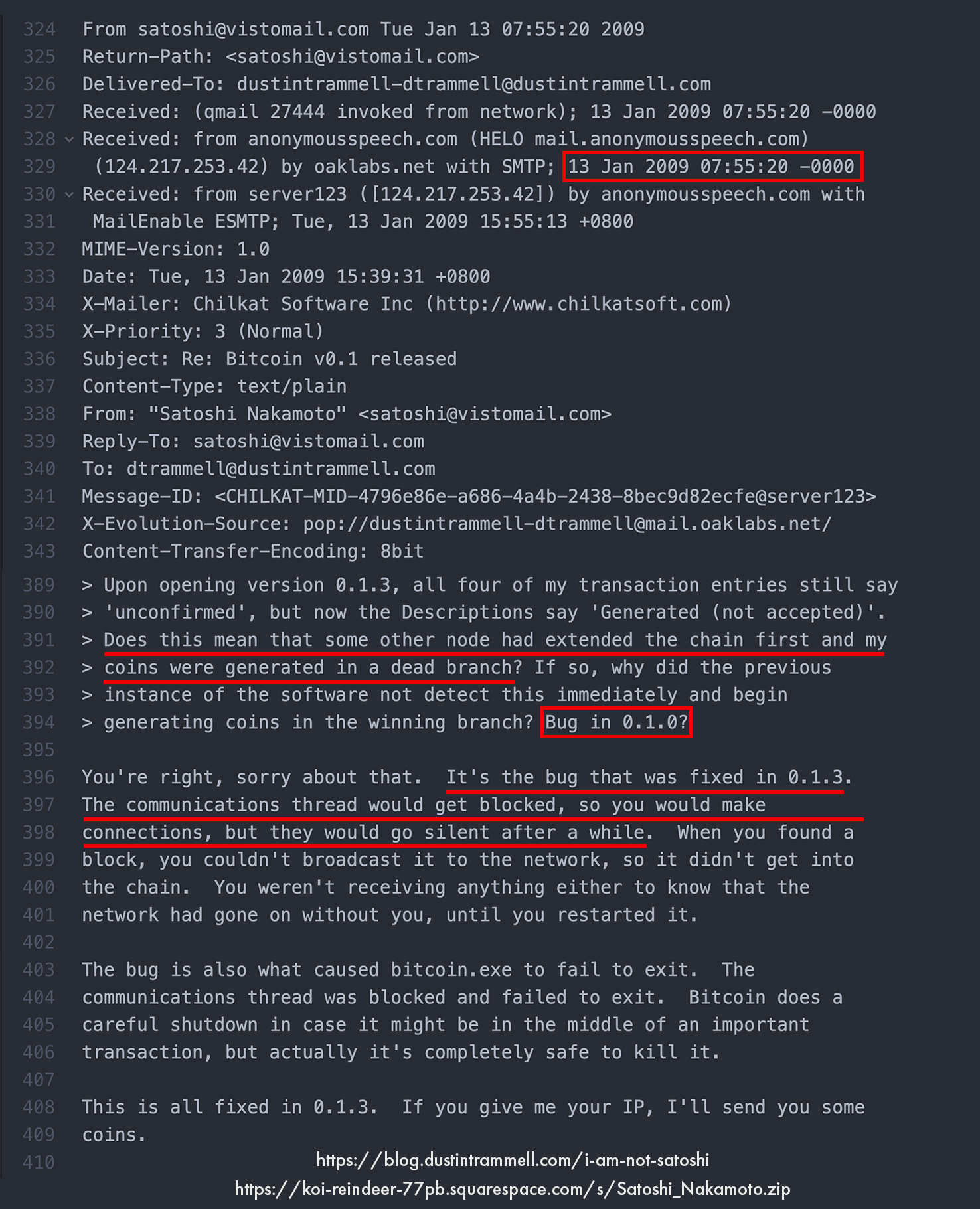
[Transcription of Dustin Tramell - Satoshi Nakamoto Private emails 3, only header and relevant text]
From satoshi@vistomail.com Tue Jan 13 07:55:20 2009
Return-Path: <satoshi@vistomail.com>
Delivered-To: dustintrammell-dtrammell@dustintrammell.com
Received: (qmail 27444 invoked from network); 13 Jan 2009 07:55:20 -0000
Received: from anonymousspeech.com (HELO mail.anonymousspeech.com)
(124.217.253.42) by oaklabs.net with SMTP; 13 Jan 2009 07:55:20 -0000
Received: from server123 ([124.217.253.42]) by anonymousspeech.com with
MailEnable ESMTP; Tue, 13 Jan 2009 15:55:13 +0800
MIME-Version: 1.0
Date: Tue, 13 Jan 2009 15:39:31 +0800
X-Mailer: Chilkat Software Inc (http://www.chilkatsoft.com)
X-Priority: 3 (Normal)
Subject: Re: Bitcoin v0.1 released
Content-Type: text/plain
From: "Satoshi Nakamoto" <satoshi@vistomail.com>
Reply-To: satoshi@vistomail.com
To: dtrammell@dustintrammell.com
Message-ID: <CHILKAT-MID-4796e86e-a686-4a4b-2438-8bec9d82ecfe@server123>
X-Evolution-Source: pop://dustintrammell-dtrammell@mail.oaklabs.net/
Content-Transfer-Encoding: 8bit
> Upon opening version 0.1.3, all four of my transaction entries still say
> 'unconfirmed', but now the Descriptions say 'Generated (not accepted)'.
> Does this mean that some other node had extended the chain first and my
> coins were generated in a dead branch? If so, why did the previous
> instance of the software not detect this immediately and begin
> generating coins in the winning branch? Bug in 0.1.0?
You're right, sorry about that. It's the bug that was fixed in 0.1.3.
The communications thread would get blocked, so you would make
connections, but they would go silent after a while. When you found a
block, you couldn't broadcast it to the network, so it didn't get into
the chain. You weren't receiving anything either to know that the
network had gone on without you, until you restarted it.
The bug is also what caused bitcoin.exe to fail to exit. The
communications thread was blocked and failed to exit. Bitcoin does a
careful shutdown in case it might be in the middle of an important
transaction, but actually it's completely safe to kill it.
This is all fixed in 0.1.3. If you give me your IP, I'll send you some
coins.
This is actually very interesting, not only is it consistent with what we saw in Hal’s debug file, but it also aligns with Satoshi describing the same issue he helped resolve with Hal.
This email suggests that Dustin was indeed running Bitcoin v0.1.0, and at the same time, it implies that anyone else who tried to run the client back then would have likely encountered the same problem.
This leads me to think that the Tor node may have been Satoshi as well, since anyone else, like Hal or Dustin, running the early client would have hit the same communication issue and been unable to broadcast blocks to the network.
Maybe Satoshi realized this and thought: “Hey, let me spin up another node so the network doesn’t appear stale as more people join.”
Abnormally Long Delays Between Bitcoin Blocks
If we look at the Bitcoin block times before Block 49, we can see that on two separate occasions, the time between blocks was unreasonably long, and one delay of 30 minutes, while not uncommon, also stands out in this context:
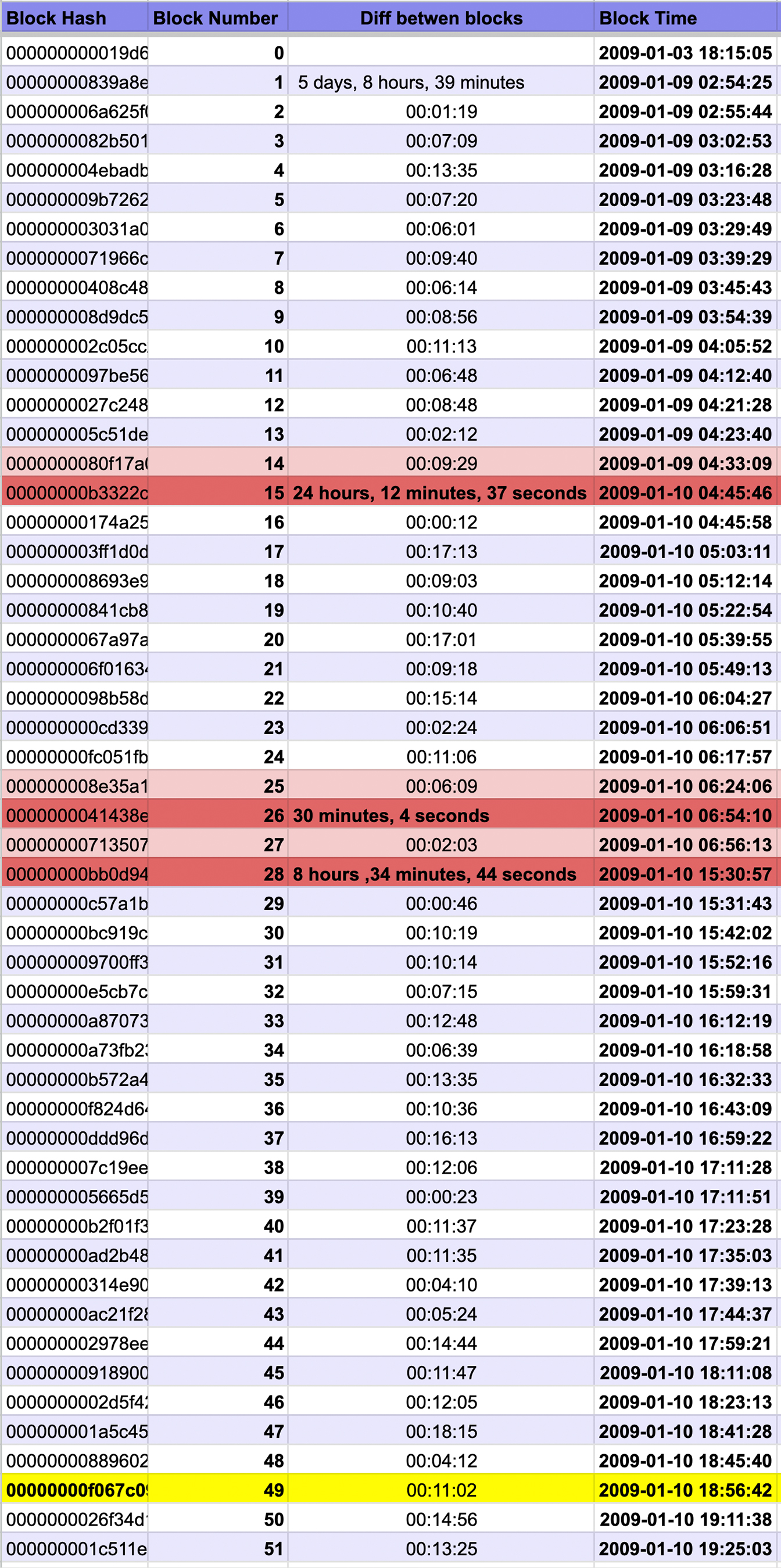
| Block Hash | Block Number | Diff betwen blocks | Block Time |
|---|---|---|---|
| 000000000019d6 | 0 | 0 | 2009-01-03 18:15:05 |
| 00000000839a8e | 1 | 5 days, 8 hours, 39 minutes | 2009-01-09 02:54:25 |
| 000000006a625f | 2 | 00:01:19 | 2009-01-09 02:55:44 |
| 0000000082b501 | 3 | 00:07:09 | 2009-01-09 03:02:53 |
| 000000004ebadb | 4 | 00:13:35 | 2009-01-09 03:16:28 |
| 000000009b7262 | 5 | 00:07:20 | 2009-01-09 03:23:48 |
| 000000003031a0 | 6 | 00:06:01 | 2009-01-09 03:29:49 |
| 0000000071966c | 7 | 00:09:40 | 2009-01-09 03:39:29 |
| 00000000408c48 | 8 | 00:06:14 | 2009-01-09 03:45:43 |
| 000000008d9dc5 | 9 | 00:08:56 | 2009-01-09 03:54:39 |
| 000000002c05cc | 10 | 00:11:13 | 2009-01-09 04:05:52 |
| 0000000097be56 | 11 | 00:06:48 | 2009-01-09 04:12:40 |
| 0000000027c248 | 12 | 00:08:48 | 2009-01-09 04:21:28 |
| 000000005c51de | 13 | 00:02:12 | 2009-01-09 04:23:40 |
| 0000000080f17a | 14 | 00:09:29 | 2009-01-09 04:33:09 |
| 00000000b3322c | 15 | 24 hours, 12 minutes, 37 seconds | 2009-01-10 04:45:46 |
| 00000000174a25 | 16 | 00:00:12 | 2009-01-10 04:45:58 |
| 000000003ff1d0 | 17 | 00:17:13 | 2009-01-10 05:03:11 |
| 000000008693e9 | 18 | 00:09:03 | 2009-01-10 05:12:14 |
| 00000000841cb8 | 19 | 00:10:40 | 2009-01-10 05:22:54 |
| 0000000067a97a | 20 | 00:17:01 | 2009-01-10 05:39:55 |
| 000000006f0163 | 21 | 00:09:18 | 2009-01-10 05:49:13 |
| 0000000098b58d | 22 | 00:15:14 | 2009-01-10 06:04:27 |
| 000000000cd339 | 23 | 00:02:24 | 2009-01-10 06:06:51 |
| 00000000fc051f | 24 | 00:11:06 | 2009-01-10 06:17:57 |
| 000000008e35a1 | 25 | 00:06:09 | 2009-01-10 06:24:06 |
| 0000000041438e | 26 | 30 minutes, 4 seconds | 2009-01-10 06:54:10 |
| 00000000713507 | 27 | 00:02:03 | 2009-01-10 06:56:13 |
| 00000000bb0d94 | 28 | 8 hours ,34 minutes, 44 seconds | 2009-01-10 15:30:57 |
| 00000000c57a1b | 29 | 00:00:46 | 2009-01-10 15:31:43 |
| 00000000bc919c | 30 | 00:10:19 | 2009-01-10 15:42:02 |
| 000000009700ff | 31 | 00:10:14 | 2009-01-10 15:52:16 |
| 00000000e5cb7c | 32 | 00:07:15 | 2009-01-10 15:59:31 |
| 00000000a87073 | 33 | 00:12:48 | 2009-01-10 16:12:19 |
| 00000000a73fb2 | 34 | 00:06:39 | 2009-01-10 16:18:58 |
| 00000000b572a4 | 35 | 00:13:35 | 2009-01-10 16:32:33 |
| 00000000f824d6 | 36 | 00:10:36 | 2009-01-10 16:43:09 |
| 00000000ddd96d | 37 | 00:16:13 | 2009-01-10 16:59:22 |
| 000000007c19ee | 38 | 00:12:06 | 2009-01-10 17:11:28 |
| 000000005665d5 | 39 | 00:00:23 | 2009-01-10 17:11:51 |
| 00000000b2f01f | 40 | 00:11:37 | 2009-01-10 17:23:28 |
| 00000000ad2b48 | 41 | 00:11:35 | 2009-01-10 17:35:03 |
| 00000000314e90 | 42 | 00:04:10 | 2009-01-10 17:39:13 |
| 00000000ac21f2 | 43 | 00:05:24 | 2009-01-10 17:44:37 |
| 000000002978ee | 44 | 00:14:44 | 2009-01-10 17:59:21 |
| 00000000918900 | 45 | 00:11:47 | 2009-01-10 18:11:08 |
| 0000000002d5f4 | 46 | 00:12:05 | 2009-01-10 18:23:13 |
| 000000001a5c45 | 47 | 00:18:15 | 2009-01-10 18:41:28 |
| 00000000889602 | 48 | 00:04:12 | 2009-01-10 18:45:40 |
| 00000000f067c0 | 49 | 00:11:02 | 2009-01-10 18:56:42 |
| 0000000026f34d | 50 | 00:14:56 | 2009-01-10 19:11:38 |
| 000000001c511e | 51 | 00:13:25 | 2009-01-10 19:25:03 |
- From Block 14 to 15 ~ 24 hours
- From Block 25 to 26 ~ 30 minutes
- From Block 27 to 28 ~ 8 hours, 34 minutes
Since the starting difficulty was very low at the time, there’s NO way those two long intervals — 8 hours and 24 hours — were statistically probable. Even a low-end computer from 2009 could have mined a Bitcoin block at difficulty 1 in less than 8 hours.
This strongly suggests that the network had halted between those blocks, for exactly that amount of time.
In fact, there are four other such examples of major time delays between blocks, six in total up until block 170.
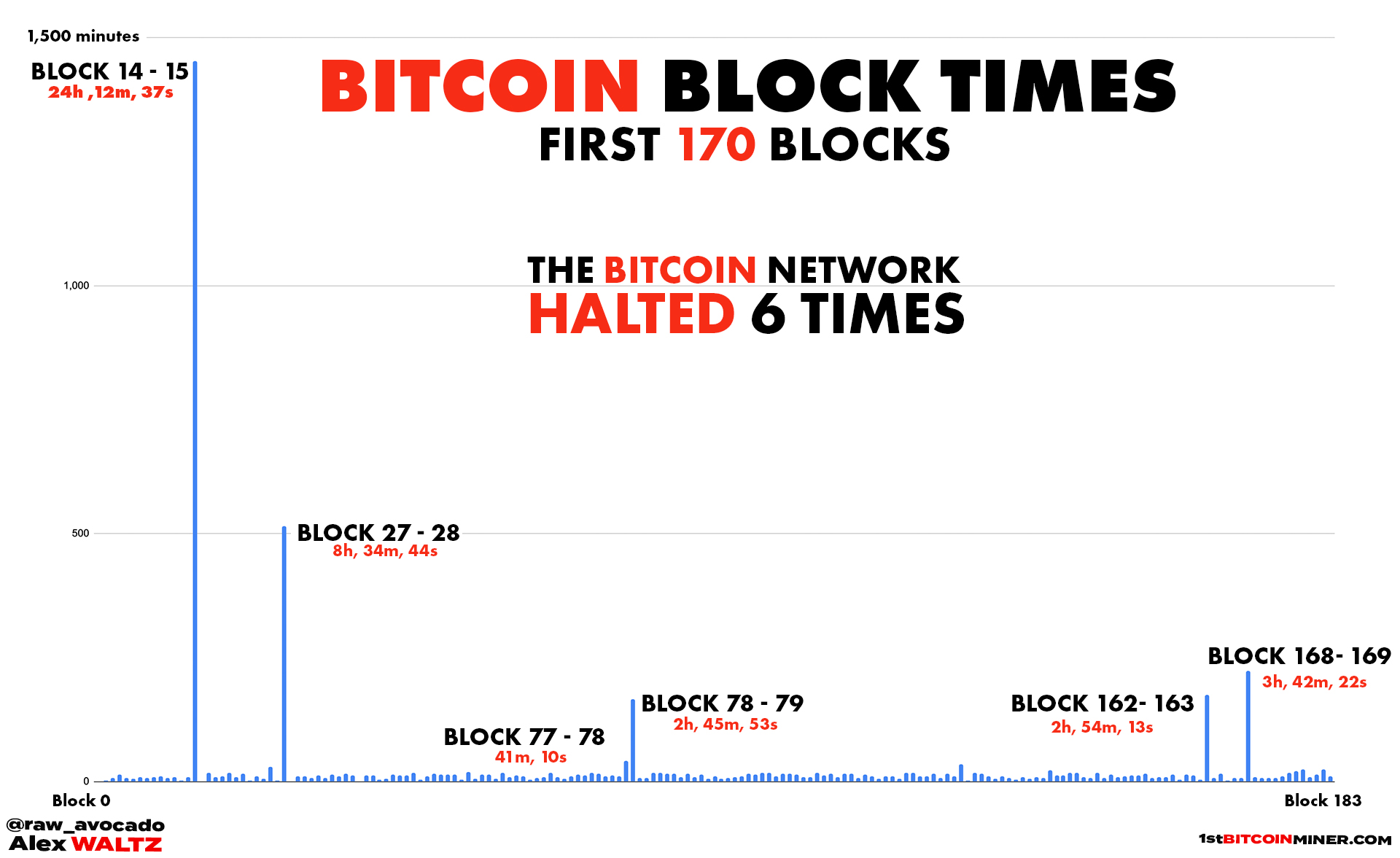
Table Block times from Block 0 to Block 183.
| Block Number | Minutes between blocks |
|---|---|
| 0 | |
| 1 | 0 |
| 2 | 1 |
| 3 | 7 |
| 4 | 14 |
| 5 | 7 |
| 6 | 6 |
| 7 | 10 |
| 8 | 6 |
| 9 | 9 |
| 10 | 11 |
| 11 | 7 |
| 12 | 9 |
| 13 | 2 |
| 14 | 9 |
| 15 | 1,453 |
| 16 | 0 |
| 17 | 17 |
| 18 | 9 |
| 19 | 11 |
| 20 | 17 |
| 21 | 9 |
| 22 | 15 |
| 23 | 2 |
| 24 | 11 |
| 25 | 6 |
| 26 | 30 |
| 27 | 2 |
| 28 | 515 |
| 29 | 1 |
| 30 | 10 |
| 31 | 10 |
| 32 | 7 |
| 33 | 13 |
| 34 | 7 |
| 35 | 14 |
| 36 | 11 |
| 37 | 16 |
| 38 | 12 |
| 39 | 0 |
| 40 | 12 |
| 41 | 12 |
| 42 | 4 |
| 43 | 5 |
| 44 | 15 |
| 45 | 12 |
| 46 | 12 |
| 47 | 18 |
| 48 | 4 |
| 49 | 11 |
| 50 | 15 |
| 51 | 13 |
| 52 | 14 |
| 53 | 14 |
| 54 | 3 |
| 55 | 19 |
| 56 | 6 |
| 57 | 14 |
| 58 | 15 |
| 59 | 6 |
| 60 | 17 |
| 61 | 8 |
| 62 | 13 |
| 63 | 11 |
| 64 | 4 |
| 65 | 7 |
| 66 | 9 |
| 67 | 18 |
| 68 | 9 |
| 69 | 6 |
| 70 | 11 |
| 71 | 14 |
| 72 | 12 |
| 73 | 18 |
| 74 | 15 |
| 75 | 11 |
| 76 | 12 |
| 77 | 11 |
| 78 | 41 |
| 79 | 166 |
| 80 | 8 |
| 81 | 6 |
| 82 | 17 |
| 83 | 18 |
| 84 | 15 |
| 85 | 16 |
| 86 | 8 |
| 87 | 15 |
| 88 | 9 |
| 89 | 13 |
| 90 | 6 |
| 91 | 11 |
| 92 | 6 |
| 93 | 8 |
| 94 | 9 |
| 95 | 10 |
| 96 | 16 |
| 97 | 15 |
| 98 | 18 |
| 99 | 17 |
| 100 | 11 |
| 101 | 15 |
| 102 | 15 |
| 103 | 13 |
| 104 | 9 |
| 105 | 9 |
| 106 | 17 |
| 107 | 12 |
| 108 | 16 |
| 109 | 9 |
| 110 | 16 |
| 111 | 16 |
| 112 | 8 |
| 113 | 14 |
| 114 | 11 |
| 115 | 6 |
| 116 | 10 |
| 117 | 10 |
| 118 | 6 |
| 119 | 18 |
| 120 | 18 |
| 121 | 11 |
| 122 | 10 |
| 123 | 16 |
| 124 | 8 |
| 125 | 16 |
| 126 | 11 |
| 127 | 34 |
| 128 | 2 |
| 129 | 18 |
| 130 | 16 |
| 131 | 10 |
| 132 | 5 |
| 133 | 11 |
| 134 | 8 |
| 135 | 4 |
| 136 | 8 |
| 137 | 5 |
| 138 | 9 |
| 139 | 8 |
| 140 | 23 |
| 141 | 12 |
| 142 | 13 |
| 143 | 18 |
| 144 | 17 |
| 145 | 9 |
| 146 | 6 |
| 147 | 17 |
| 148 | 7 |
| 149 | 14 |
| 150 | 10 |
| 151 | 11 |
| 152 | 11 |
| 153 | 13 |
| 154 | 15 |
| 155 | 7 |
| 156 | 9 |
| 157 | 9 |
| 158 | 14 |
| 159 | 4 |
| 160 | 14 |
| 161 | 12 |
| 162 | 4 |
| 163 | 174 |
| 164 | 7 |
| 165 | 15 |
| 166 | 1 |
| 167 | 6 |
| 168 | 8 |
| 169 | 222 |
| 170 | 8 |
| 171 | 6 |
| 172 | 8 |
| 173 | 7 |
| 174 | 10 |
| 175 | 17 |
| 176 | 21 |
| 177 | 24 |
| 178 | 10 |
| 179 | 15 |
| 180 | 24 |
| 181 | 11 |
| 182 | 10 |
| 183 | 22 |
The following stand out:
- Block 14 - 15: 24h, 12m, 37s
- Block 27 - 28: 8h, 34m, 44s
- Block 77 - 78: 41m, 10s
- Block 78 - 79: 2h, 45m, 14s
- Block 162 - 163: 2h, 54m, 13s
- Block 168 - 169: 3h, 42m, 22s
Note: Timestamps are set by miners and can be off by up to two hours. This flexibility was introduced by Satoshi to accommodate potential time misconfigurations on users’ machines. It is a consensus rule and remains part of Bitcoin today. However, given the unusually long time intervals, even with this margin of error, there is still strong evidence of multiple halts.
If we examine the code, we can see that a starting difficulty of 1 required, on average, 2³² hashing operations to find a valid block.
A decent computer from 2009 could handle this without any issue.
So we can confidently rule out the possibility that many people were mining, but simply didn’t have strong enough hardware. The delay was almost certainly due to network inactivity, not hardware limitations.
So, I would lean toward the Tor node also being Satoshi.
It would certainly be helpful to find another source of information to contrast with our findings, but unfortunately, no one else who participated that early in Bitcoin has shared any public information.
The only thing we have from that time is the blockchain itself.
What is the ExtraNonce in Bitcoin?
I’m sure most readers are at least somewhat familiar with how Bitcoin mining works, but let me give you a quick refresher.
A miner takes a set of transactions, places them into a block, hashes all the data, and then broadcasts the block and its hash to other nodes. If the hash of the block is below a certain target value (set by the network), the miner receives the block reward plus any transaction fees.
This target value is tied to the network difficulty; as difficulty increases, the target becomes smaller, making it harder to find a valid hash.
Lowering the target means there are fewer valid outputs, shrinking the search space and increasing the work required to find a solution.
Since SHA-256 outputs are evenly distributed, each hash has the EXACT same probability of being below the target. But that probability is quite small, so miners must calculate a large number of hashes. Essentially, Bitcoin mining is just trying many hashes until one of them hits.
Another important property of SHA-256 is that if you change even a single bit of the input, the output changes drastically, and Satoshi of course knew this.
Since you can’t modify the transaction data, Satoshi added a special field in the block header called the Nonce (short for Number used ONCE).
Mining is simply iterating through values of this Nonce field, from 0 up to its maximum value of 2³² = 4,294,967,296.
Quite often, miners go through the entire Nonce range without finding a valid hash, especially as difficulty increases.
So what happens then?
They use the ExtraNonce. What is an ExtraNonce, you ask? It’s another field in the block that the miner can iterate over.
By incrementing the ExtraNonce, a miner gets a fresh new set of 2³² possible Nonce values to try.
While the Nonce field is explicitly defined in the Bitcoin protocol and must exist in the block header, the ExtraNonce is more of a workaround: miners modify part of the coinbase transaction to generate variation, and that change is referred to as the ExtraNonce.
Now here’s where things get really interesting.
When Satoshi implemented Bitcoin mining, he made a small but important mistake in how the Bitcoin client handled the ExtraNonce.
You would think that once a miner finds a valid block, they would reset the ExtraNonce and start fresh with a new block. But in the first versions of Bitcoin, that’s not how it worked.
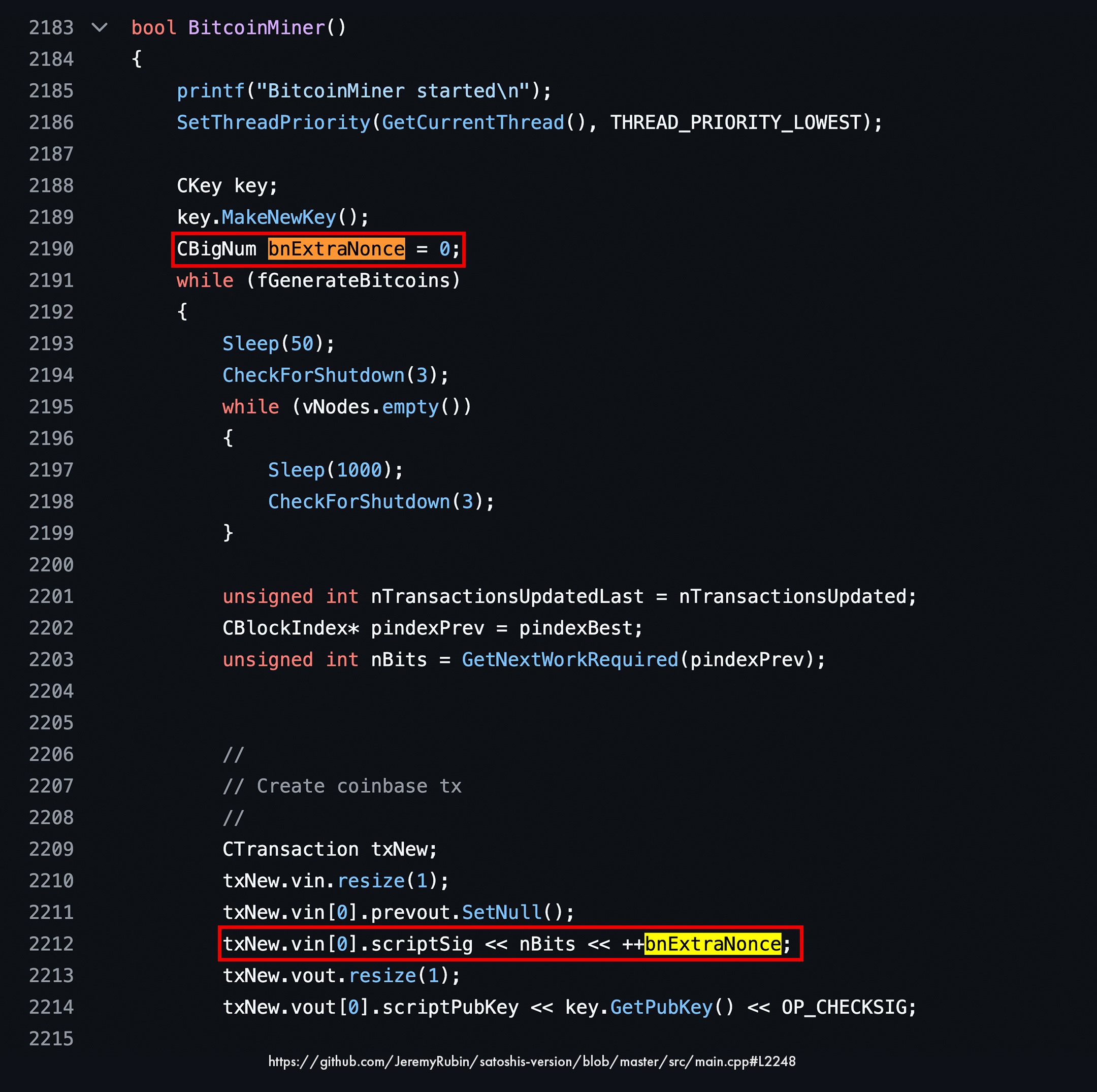
//# Code snipped of original Satoshi code from Jeremy Rubin's github repository that has aditional comments
bool BitcoinMiner()
{
printf("BitcoinMiner started\n");
//# Bitcoin was just an experiment, so of course mining was low priority :p
SetThreadPriority(GetCurrentThread(), THREAD_PRIORITY_LOWEST);
//# We generate a random new key (note this isn't yet saved)
CKey key;
key.MakeNewKey();
CBigNum bnExtraNonce = 0;
while (fGenerateBitcoins)
{
Sleep(50); //# millis
CheckForShutdown(3);
//# This code is really meant to only be hit on startup
//# before we connect to any peers
while (vNodes.empty())
{
Sleep(1000);
CheckForShutdown(3);
}
unsigned int nTransactionsUpdatedLast = nTransactionsUpdated;
//# We get the best block in our chain, and compute the work required
//# in the next block
CBlockIndex* pindexPrev = pindexBest;
unsigned int nBits = GetNextWorkRequired(pindexPrev);
//
// Create coinbase tx
//
CTransaction txNew;
txNew.vin.resize(1);
txNew.vin[0].prevout.SetNull();
txNew.vin[0].scriptSig << nBits << ++bnExtraNonce;
txNew.vout.resize(1);
txNew.vout[0].scriptPubKey << key.GetPubKey() << OP_CHECKSIG;
Source: https://github.com/JeremyRubin/satoshis-version/blob/master/src/main.cpp#L2248
Because of how Satoshi implemented the use of the ExtraNonce, it led to three unintended consequences:
The ExtraNonce only resets if you restart or shut down the Bitcoin client — not after a block is found
The ExtraNonce increments not just when the Nonce overflows, but also when the miner attempts to construct a new block candidate.
The ExtraNonce also increments when a valid block is received from another node, again unrelated to Nonce overflow. This is because when checking the validity of the received block, the node has to call the
fGenerateBitcoinsfunction, thus triggering the ExtraNonce increment.
This behavior is due to:
bnExtraNonceonly being initialized to 0 before thewhile (fGenerateBitcoins)loop.The position of
++bnExtraNoncerelative to coinbase creation.The overall structure of the
fGenerateBitcoinsloop in the early client.
So, under normal operation (only in this very early version of the client, this changed later), a node would increment the ExtraNonce not just when the Nonce range was exhausted, but whenever one of the above events occurred.
Because the ExtraNonce is embedded in the coinbase transaction of each block, it leaves a visible trace on the blockchain — essentially a counter showing how often it was incremented.
This is extremely useful for our investigation because:
The ExtraNonce acts like a rough uptime counter that can indicate how long a Bitcoin client has been running.
If we see a series of blocks with consecutive or gradually increasing ExtraNonce values, we can reasonably infer that they came from the same miner.
If we see a block with ExtraNonce = 0, it likely came from a freshly started client.
By the way, this behavior was discovered by Sergio Demian Lerner in 2013, who had the genius idea to look at the ExtraNonce data, which he used to develop the famous Patoshi Pattern Theory. His research led him to estimate that the so-called Patoshi miner (likely Satoshi) mined somewhere between 700,000 and 1 million bitcoins.
Regardless of whether you agree with his conclusion, two things are undeniable:
What is written in the code (how the ExtraNonce was incremented).
What is written on the blockchain (the ExtraNonce published in each coinbase transaction).
ExtraNonce + Long Block Delays
The good news is that even if you disagree with Sergio’s conclusions, perhaps due to concerns that the data is too noisy, this doesn’t pose a problem for our investigation, because:
We’re dealing with the very first days of Bitcoin’s existence, and there was very little interest shown on the Cryptography Mailing List at the time. That means we’re looking at a very small number of participants.
We have additional evidence from Hal’s
debug.logfile, which shows that around Block 49, there were only two other nodes present. It’s hard to imagine that hundreds of participants suddenly rushed in all of a sudden — especially given the extremely long time delays between blocks.
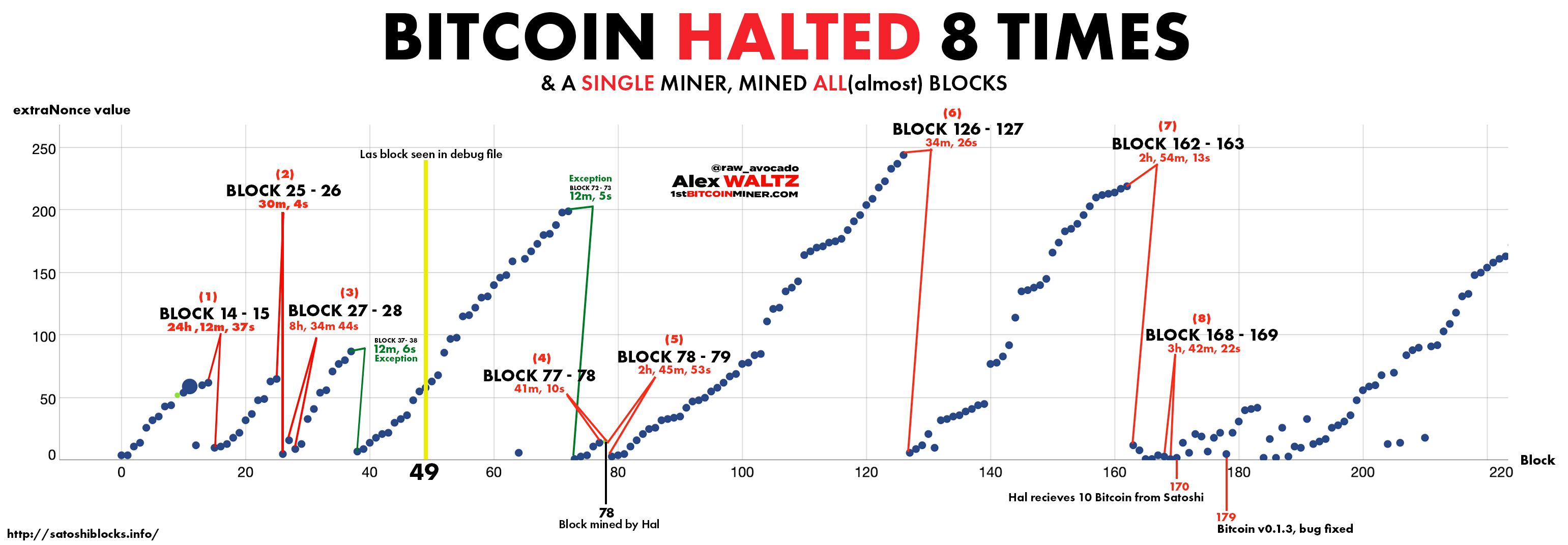
Note: Table that can be used to draw the chart. The nodes column contains the highligts.
| Block Number | Diff betwen blocks | extraNonce Decimal | Notes |
|---|---|---|---|
| 0 | 0 | n/a | |
| 1 | n/a | 4 | |
| 2 | 00:01:19 | 11 | |
| 3 | 00:07:09 | 14 | |
| 4 | 00:13:35 | 26 | |
| 5 | 00:07:20 | 32 | |
| 6 | 00:06:01 | 35 | |
| 7 | 00:09:40 | 43 | |
| 8 | 00:06:14 | 44 | |
| 9 | 00:08:56 | 52 | |
| 10 | 00:11:13 | 54 | |
| 11 | 00:06:48 | 59 | |
| 12 | 00:08:48 | 12 | |
| 13 | 00:02:12 | 60 | |
| 14 | 00:09:29 | 62 | |
| 15 | 24 hours, 12 minutes, 37 seconds | 10 | Halt + extraNonce Reset |
| 16 | 00:00:12 | 11 | |
| 17 | 00:17:13 | 13 | |
| 18 | 00:09:03 | 18 | |
| 19 | 00:10:40 | 22 | |
| 20 | 00:17:01 | 32 | |
| 21 | 00:09:18 | 37 | |
| 22 | 00:15:14 | 48 | |
| 23 | 00:02:24 | 49 | |
| 24 | 00:11:06 | 63 | |
| 25 | 00:06:09 | 65 | |
| 26 | 30 minutes, 4 seconds | 5 | Halt + extraNonce Reset |
| 27 | 00:02:03 | 16 | |
| 28 | 8 hours ,34 minutes, 44 seconds | 9 | Halt + extraNonce Reset |
| 29 | 00:00:46 | 13 | |
| 30 | 00:10:19 | 33 | |
| 31 | 00:10:14 | 41 | |
| 32 | 00:07:15 | 54 | |
| 33 | 00:12:48 | 56 | |
| 34 | 00:06:39 | 71 | |
| 35 | 00:13:35 | 77 | |
| 36 | 00:10:36 | 80 | |
| 37 | 00:16:13 | 87 | |
| 38 | 00:12:06 | 7 | Exception, extraNonce reset, normal time |
| 39 | 00:00:23 | 9 | |
| 40 | 00:11:37 | 14 | |
| 41 | 00:11:35 | 18 | |
| 42 | 00:04:10 | 21 | |
| 43 | 00:05:24 | 22 | |
| 44 | 00:14:44 | 30 | |
| 45 | 00:11:47 | 33 | |
| 46 | 00:12:05 | 36 | |
| 47 | 00:18:15 | 48 | |
| 48 | 00:04:12 | 55 | |
| 49 | 00:11:02 | 58 | |
| 50 | 00:14:56 | 63 | |
| 51 | 00:13:25 | 68 | |
| 52 | 00:14:20 | 86 | |
| 53 | 00:13:47 | 97 | |
| 54 | 00:03:16 | 98 | |
| 55 | 00:18:43 | 115 | |
| 56 | 00:05:39 | 116 | |
| 57 | 00:13:48 | 122 | |
| 58 | 00:14:48 | 130 | |
| 59 | 00:06:04 | 131 | |
| 60 | 00:17:11 | 140 | |
| 61 | 00:08:06 | 146 | |
| 62 | 00:12:59 | 148 | |
| 63 | 00:10:56 | 159 | |
| 64 | 00:03:47 | 6 | |
| 65 | 00:06:36 | 161 | |
| 66 | 00:08:37 | 167 | |
| 67 | 00:17:32 | 173 | |
| 68 | 00:09:06 | 180 | |
| 69 | 00:06:01 | 181 | |
| 70 | 00:11:07 | 188 | |
| 71 | 00:13:33 | 198 | |
| 72 | 00:12:15 | 199 | |
| 73 | 00:18:14 | 1 | Exception, extraNonce reset, normal time |
| 74 | 00:15:01 | 3 | |
| 75 | 00:10:33 | 4 | |
| 76 | 00:12:12 | 11 | |
| 77 | 00:10:30 | 14 | |
| 78 | 41 minutes, 10 seconds | 15 | Halt + extraNonce Reset |
| 79 | 2 hours, 45minutes 53 seconds | 3 | Halt + extraNonce Reset |
| 80 | 00:07:50 | 4 | |
| 81 | 00:06:19 | 5 | |
| 82 | 00:17:15 | 11 | |
| 83 | 00:18:12 | 16 | |
| 84 | 00:15:14 | 21 | |
| 85 | 00:16:26 | 25 | |
| 86 | 00:08:23 | 26 | |
| 87 | 00:15:02 | 32 | |
| 88 | 00:08:40 | 33 | |
| 89 | 00:13:21 | 34 | |
| 90 | 00:05:41 | 35 | |
| 91 | 00:11:19 | 42 | |
| 92 | 00:05:32 | 47 | |
| 93 | 00:07:56 | 48 | |
| 94 | 00:09:04 | 50 | |
| 95 | 00:10:23 | 55 | |
| 96 | 00:16:21 | 58 | |
| 97 | 00:14:43 | 62 | |
| 98 | 00:17:45 | 67 | |
| 99 | 00:16:53 | 69 | |
| 100 | 00:11:19 | 77 | |
| 101 | 00:15:16 | 78 | |
| 102 | 00:15:29 | 84 | |
| 103 | 00:13:17 | 85 | |
| 104 | 00:09:02 | 111 | |
| 105 | 00:09:18 | 121 | |
| 106 | 00:16:38 | 122 | |
| 107 | 00:12:00 | 135 | |
| 108 | 00:15:37 | 138 | |
| 109 | 00:09:12 | 143 | |
| 110 | 00:16:05 | 164 | |
| 111 | 00:15:34 | 167 | |
| 112 | 00:07:44 | 170 | |
| 113 | 00:13:58 | 171 | |
| 114 | 00:10:44 | 174 | |
| 115 | 00:05:44 | 175 | |
| 116 | 00:09:45 | 177 | |
| 117 | 00:09:59 | 184 | |
| 118 | 00:05:37 | 191 | |
| 119 | 00:17:53 | 196 | |
| 120 | 00:17:46 | 204 | |
| 121 | 00:10:58 | 209 | |
| 122 | 00:09:52 | 218 | |
| 123 | 00:15:50 | 223 | |
| 124 | 00:07:35 | 233 | |
| 125 | 00:16:17 | 237 | |
| 126 | 00:10:44 | 244 | |
| 127 | 34 minutes, 26seconds | 6 | Halt + extraNonce Reset |
| 128 | 00:02:06 | 9 | |
| 129 | 00:17:49 | 12 | |
| 130 | 00:16:05 | 21 | |
| 131 | 00:10:00 | 10 | |
| 132 | 00:04:43 | 32 | |
| 133 | 00:10:59 | 33 | |
| 134 | 00:07:34 | 35 | |
| 135 | 00:04:15 | 36 | |
| 136 | 00:08:12 | 39 | |
| 137 | 00:04:47 | 41 | |
| 138 | 00:08:58 | 44 | |
| 139 | 00:07:45 | 45 | |
| 140 | 00:23:25 | 77 | |
| 141 | 00:11:37 | 78 | |
| 142 | 00:12:58 | 83 | |
| 143 | 00:17:46 | 92 | |
| 144 | 00:17:20 | 114 | |
| 145 | 00:09:16 | 135 | |
| 146 | 00:06:15 | 136 | |
| 147 | 00:17:25 | 138 | |
| 148 | 00:06:48 | 140 | |
| 149 | 00:13:58 | 145 | |
| 150 | 00:09:38 | 166 | |
| 151 | 00:11:17 | 174 | |
| 152 | 00:11:28 | 183 | |
| 153 | 00:12:52 | 185 | |
| 154 | 00:15:27 | 189 | |
| 155 | 00:07:06 | 196 | |
| 156 | 00:09:06 | 203 | |
| 157 | 00:09:18 | 210 | |
| 158 | 00:13:39 | 212 | |
| 159 | 00:04:21 | 213 | |
| 160 | 00:14:08 | 214 | |
| 161 | 00:12:11 | 217 | |
| 162 | 00:04:27 | 219 | |
| 163 | 2 hours, 54minutes, 13seconds | 12 | Halt + extraNonce Reset |
| 164 | 00:07:10 | 8 | |
| 165 | 00:14:58 | 1 | |
| 166 | 00:01:24 | 1 | |
| 167 | 00:06:22 | 4 | |
| 168 | 00:07:50 | 3 | |
| 169 | 3 hours, 42 minutes, 22 seconds | 1 | Halt + extraNonce Reset |
| 170 | 00:08:22 | 2 | |
| 171 | 00:06:16 | 14 | |
| 172 | 00:07:32 | 6 | |
| 173 | 00:06:32 | 21 | |
| 174 | 00:10:16 | 19 | |
| 175 | 00:16:55 | 7 | |
| 176 | 00:21:06 | 18 | |
| 177 | 00:23:35 | 22 | |
| 178 | 00:09:34 | 5 | |
| 179 | 00:14:34 | 22 | |
| 180 | 00:24:07 | 31 |
When extraNonce reset coresponds with big time gap:
- Block 14 - 15: 24 hours, 12 minutes, 37 seconds
- Block 25 - 26: 30 minutes, 4 seconds
- Block 27 - 28: 8 hours ,34 minutes, 44 seconds
- Block 77 - 78: 41 minutes, 10 seconds
- Block 78 - 79: 2 hours, 45minutes 53 seconds
- Block 126 - 127: 34 minutes, 26seconds
- Block 162 - 163: 2 hours, 54minutes, 13seconds
- Block 168 - 169: 3 hours, 42 minutes, 22 seconds
There are 2 exceptions when the extraNonce resets but we have a “normal” time gap:
- Block 37 - 38: 12 minutes, 6 seconds
- Block 72 - 73: 18 minutes, 14 seoconds
Source: http://satoshiblocks.info/
In the chart above, we have blocks on the X-axis and ExtraNonce values on the Y-axis.
The chart goes up to around Block 170, because that’s roughly when the following key events occurred:
- Satoshi sent Hal the 10 Bitcoins
- Hal made the famous “Running Bitcoin” tweet
- Satoshi released Bitcoin v0.1.3 — the first version that ran without issues
We can see clusters of navy blue dots forming visible patterns, where the ExtraNonce of consecutive blocks increases steadily.
This allows us to reasonably infer that each distinct grouping of blue dots corresponds to a single miner. The longer the ExtraNonce pattern, the stronger the assumption.
While ExtraNonce incrementation is not entirely random, it’s still chaotic and unpredictable, so when we observe consecutive values, we can assign a high degree of confidence that those blocks came from the same mining entity.
Another thing we can observe is that each time the ExtraNonce resets, there’s a large time gap between blocks. Since we know the ExtraNonce counter resets when a node restarts (or shuts down), this is a very strong indicator that most of the blocks were mined by one entity, and when this entity was offline, no one else was mining blocks.
Remember, the difficulty at this time was very low. During this period, if a decent computer had been online, it would have been fairly easy to find a block in 10 minutes, let alone in a few hours.
In addition to this, we know from Hal’s debug.log file that around Block 49, there were only two other nodes present: one using a clearnet IP (most likely Satoshi), and the other behind Tor.
Block 49 is part of the run from Block 38 to Block 72, and one of the two exceptions where the extraNonce resets and we have a normal (something close to 10 minutes) time gap. The extraNonce reset happens from Block 72 to Block 73.
In fact, if we examine the time intervals between blocks from Block 29 to Block 77, the average interval is 10.7 minutes — what we would expect if someone were consistently present and mining.
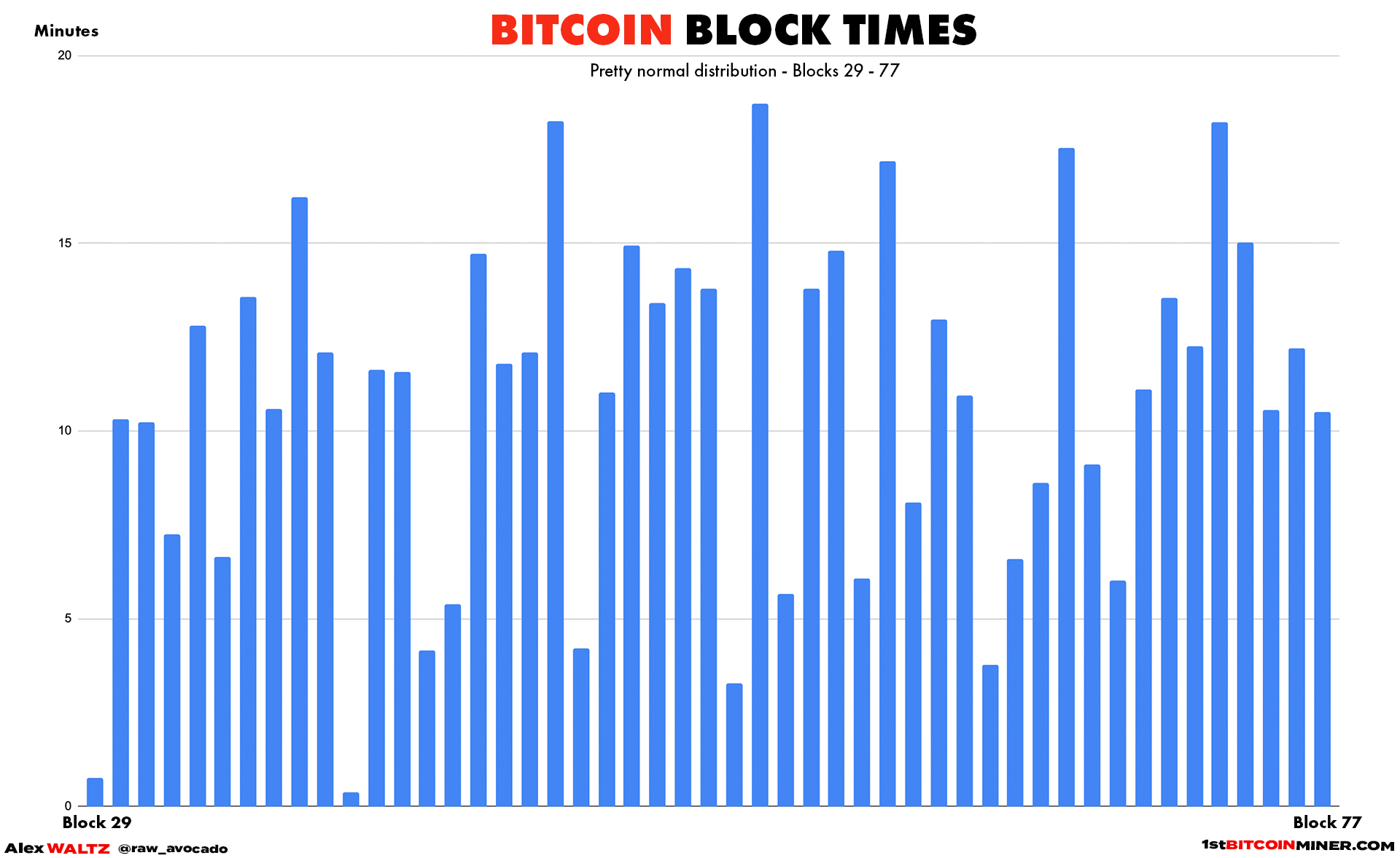
| Block Number | Minutes Between Blocks |
|---|---|
| 29 | 1 |
| 30 | 10 |
| 31 | 10 |
| 32 | 7 |
| 33 | 13 |
| 34 | 7 |
| 35 | 14 |
| 36 | 11 |
| 37 | 16 |
| 38 | 12 |
| 39 | 0 |
| 40 | 12 |
| 41 | 12 |
| 42 | 4 |
| 43 | 5 |
| 44 | 15 |
| 45 | 12 |
| 46 | 12 |
| 47 | 18 |
| 48 | 4 |
| 49 | 11 |
| 50 | 15 |
| 51 | 13 |
| 52 | 14 |
| 53 | 14 |
| 54 | 3 |
| 55 | 19 |
| 56 | 6 |
| 57 | 14 |
| 58 | 15 |
| 59 | 6 |
| 60 | 17 |
| 61 | 8 |
| 62 | 13 |
| 63 | 11 |
| 64 | 4 |
| 65 | 7 |
| 66 | 9 |
| 67 | 18 |
| 68 | 9 |
| 69 | 6 |
| 70 | 11 |
| 71 | 14 |
| 72 | 12 |
| 73 | 18 |
| 74 | 15 |
| 75 | 11 |
| 76 | 12 |
| 77 | 11 |
Within this range(29 to 77), we also find both exceptions(with green on the main chart) where an extraNonce reset occurs without any apparent network halt, one after the other.
In other words, the only time the network operates without any halts is during the period when we know for certain that both Satoshi and the Tor node were present.
All of these factors lead me to believe that the Tor node was also Satoshi.
What I suspect was happening here is that Satoshi was operating both nodes (the Tor node and the clearnet one) and that during this run, he was actively present at his machines, likely incorporating feedback from Hal while working on the code. However, whenever those longer gaps occurred, it appears he went offline for some reason.
This email from Mon, Jan 12, 2009 at 8:41 AM (PST) -> Monday, 12 January 2009 16:41:00 UTC (one day after Hal received Bitcoin v0.1.3, the first stable version), or otherwise lacked access to his main machine, and that he was using Tor during this time (from Wall Street Journal emails).
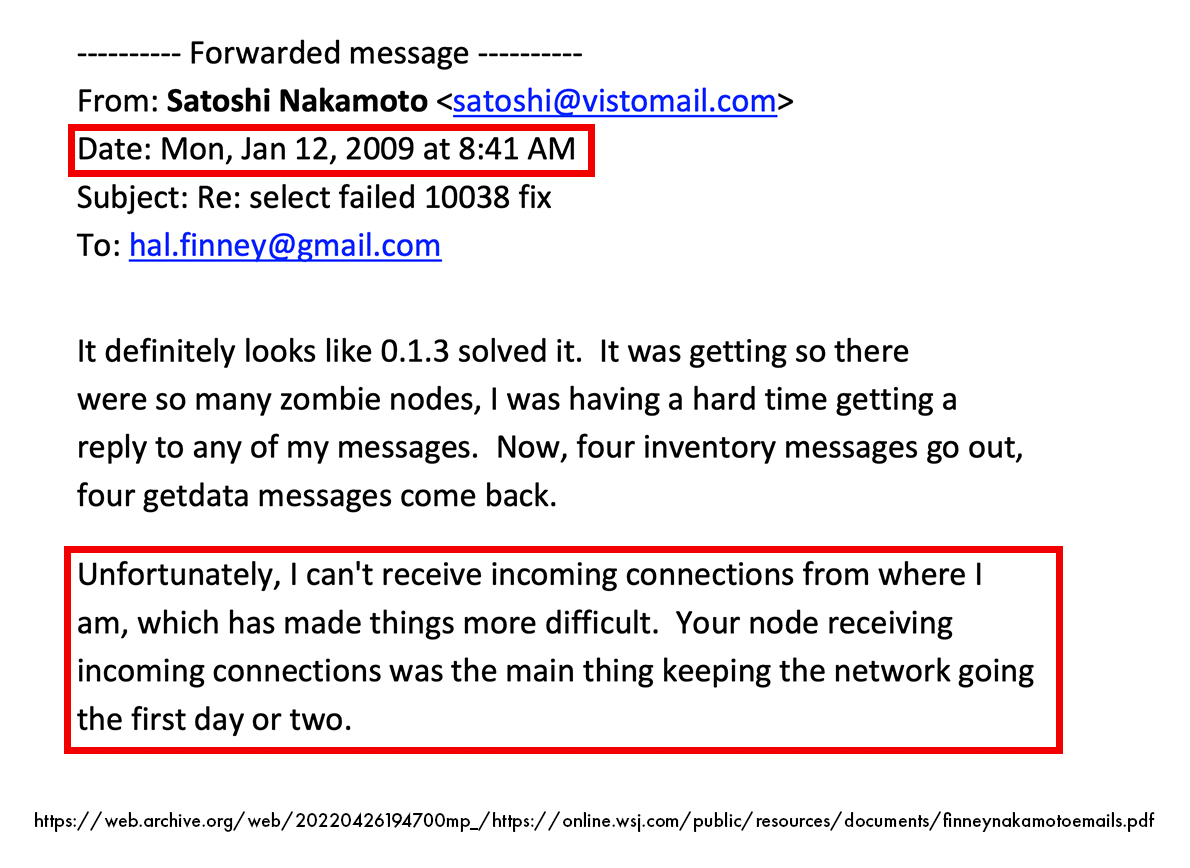
[Transcription of Satoshi - Hal Private email 6 from Wall Street Journal, only relevant text]
---------- Forwarded message ----------
From: Satoshi Nakamoto <satoshi@vistomail.com>
Date: Mon, Jan 12, 2009 at 8:41 AM
Subject: Re: select failed 10038 fix
To: hal.finney@gmail.com
It definitely looks like 0.1.3 solved it. It was getting so there
were so many zombie nodes, I was having a hard time getting a
reply to any of my messages. Now, four inventory messages go out,
four getdata messages come back.
Unfortunately, I can't receive incoming connections from where I
am, which has made things more difficult. Your node receiving
incoming connections was the main thing keeping the network going
the first day or two
...........................................
Remember, Tor nodes cannot accept incoming connections.
It’s also interesting to note that Satoshi credited Hal with essentially keeping the network alive, despite the issues it was experiencing at the time.
To be extra clear: Everything I’m presenting here is educated speculation and reasoned interpretation based on the available evidence — but it’s not 100% proof.
When I say there’s a high probability of certain events or conclusions, that does not mean they are guaranteed. Freak events can and do happen — they’re just statistically less likely.
I absolutely stand by everything I’ve said here; I just want to make it clear which parts of this investigation are speculative.
What If Dustin Trammell Was the Tor Node?
This speculation can be ruled out quite easily.
On Jan 13 18:40:28 2009, Dustin shared his IP address with Satoshi so that Satoshi could send him some coins, specifically to 24.28.79.95.
It’s highly unlikely that Dustin was using Tor at the time, and then suddenly switched to a clearnet IP.
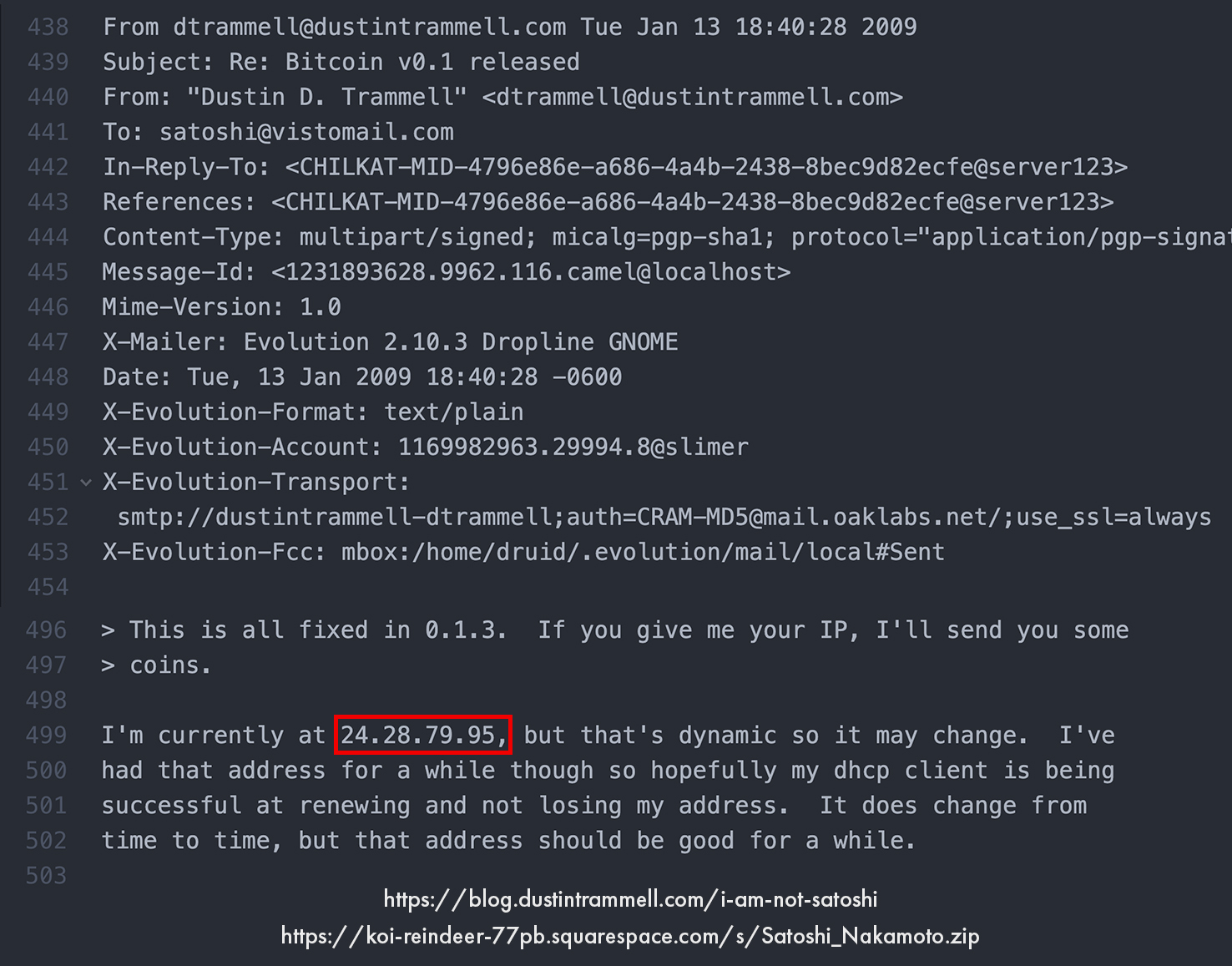
[Transcription of Dustin Tramell - Satoshi Nakamoto Private emails 3, only header and relevant text]
From dtrammell@dustintrammell.com Tue Jan 13 18:40:28 2009
Subject: Re: Bitcoin v0.1 released
From: "Dustin D. Trammell" <dtrammell@dustintrammell.com>
To: satoshi@vistomail.com
In-Reply-To: <CHILKAT-MID-4796e86e-a686-4a4b-2438-8bec9d82ecfe@server123>
References: <CHILKAT-MID-4796e86e-a686-4a4b-2438-8bec9d82ecfe@server123>
Content-Type: multipart/signed; micalg=pgp-sha1; protocol="application/pgp-signature"; boundary="=-6Uj1TgItQqnGup73toZt"
Message-Id: <1231893628.9962.116.camel@localhost>
Mime-Version: 1.0
X-Mailer: Evolution 2.10.3 Dropline GNOME
Date: Tue, 13 Jan 2009 18:40:28 -0600
X-Evolution-Format: text/plain
X-Evolution-Account: 1169982963.29994.8@slimer
X-Evolution-Transport:
smtp://dustintrammell-dtrammell;auth=CRAM-MD5@mail.oaklabs.net/;use_ssl=always
X-Evolution-Fcc: mbox:/home/druid/.evolution/mail/local#Sent
> This is all fixed in 0.1.3. If you give me your IP, I'll send you some
> coins.
I'm currently at 24.28.79.95, but that's dynamic so it may change. I've
had that address for a while though so hopefully my dhcp client is being
successful at renewing and not losing my address. It does change from
time to time, but that address should be good for a while.
As mentioned earlier, the early versions of Bitcoin allowed users to send Bitcoins directly to an IP address. A user would share their IP, your node would connect to theirs using that address, request a public key, and then send the coins to that key.
Even though Bitcoin addresses were supported, many early transactions used bare public keys. That’s why Dustin shared his IP address with Satoshi in that email.
At this point, we can move on to the last pieces of evidence, two tweets made by Dustin Trammell:
- In 2023
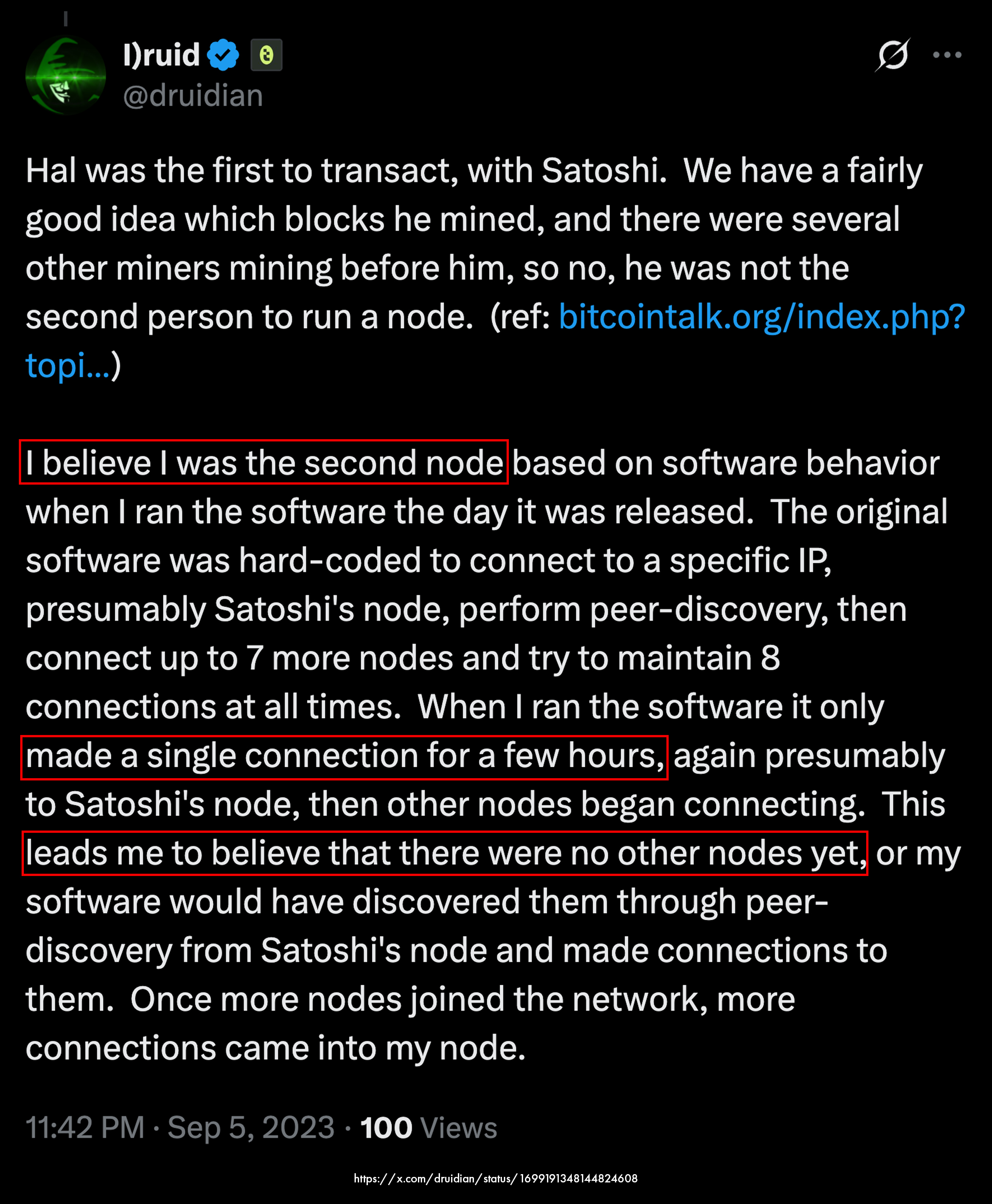
[Transcription of Dustin Tramell Tweet September 5 2021]
I)ruid @druidian
Hal was the first to transact, with Satoshi. We have a fairly good idea which blocks he mined, and there were several other miners mining before him, so no, he was not the second person to run a node. (ref: https://bitcointalk.org/index.php?topic=155054.0)
I believe I was the second node based on software behavior when I ran the software the day it was released. The original software was hard-coded to connect to a specific IP, presumably Satoshi's node, perform peer-discovery, then connect up to 7 more nodes and try to maintain 8 connections at all times. When I ran the software it only made a single connection for a few hours, again presumably to Satoshi's node, then other nodes began connecting. This leads me to believe that there were no other nodes yet, or my software would have discovered them through peer-discovery from Satoshi's node and made connections to them. Once more nodes joined the network, more connections came into my node.
11:42 PM · Sep 5, 2023
Source: https://x.com/druidian/status/1699191348144824608
- In 2021
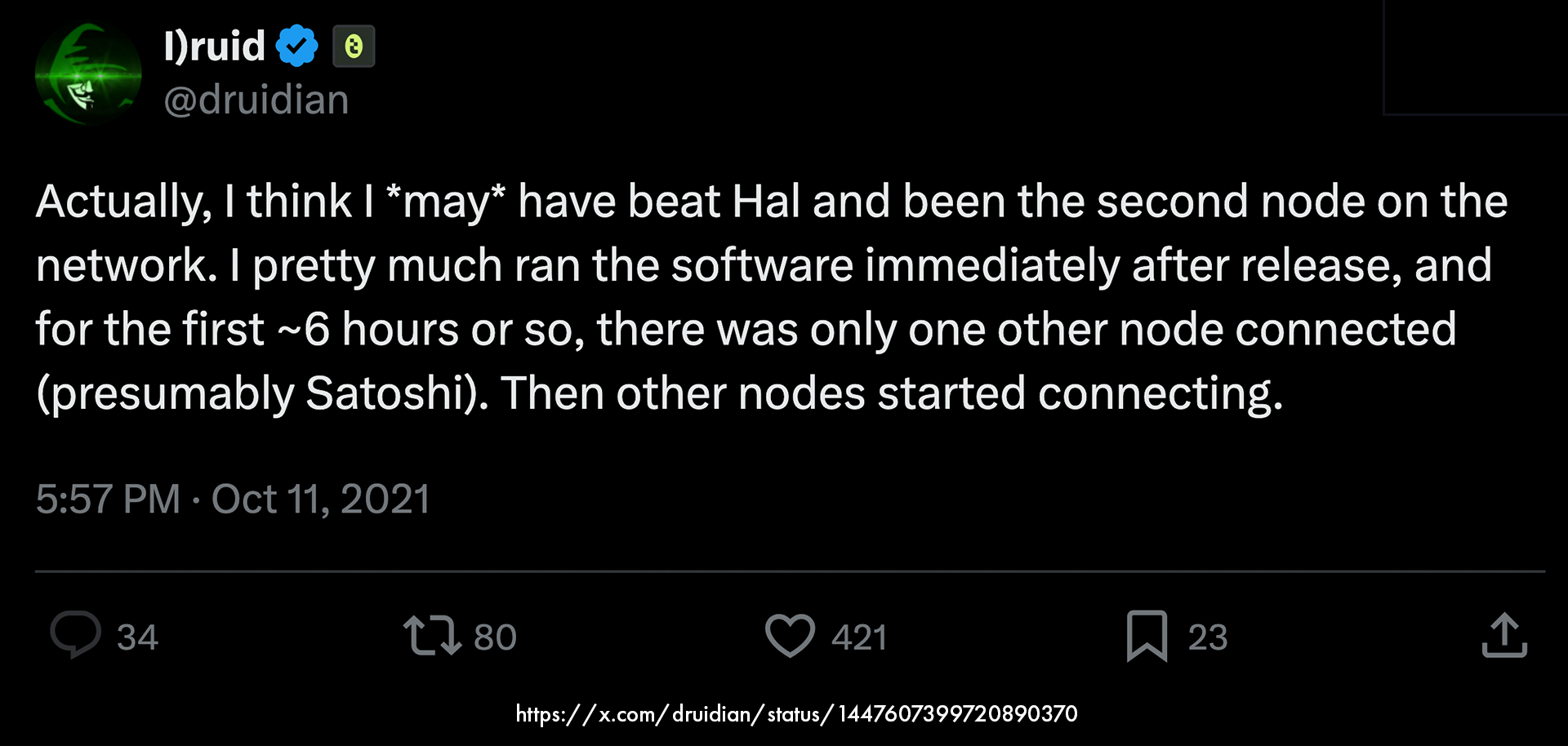
[Transcription of Dustin Tramell Tweet October 11 2021]
I)ruid @druidian
Actually, I think I *may* have beat Hal and been the second node on the network. I pretty much ran the software immediately after release, and for the first ~6 hours or so, there was only one other node connected (presumably Satoshi). Then other nodes started connecting.
5:57 PM · Oct 11, 2021
Source: https://x.com/druidian/status/1447607399720890370
It’s interesting to see that Dustin reached the same conclusion as we did: That Hal was NOT the second node to join the network (with Satoshi being the first), and that there were other miners before Hal — which aligns perfectly with our findings.
Dustin suspects that he was the second node to join the Bitcoin network, before Hal.
He clearly states that his node only made one connection. But was this because there were no other nodes online? Or due to connection issues?
What Dustin describes in the tweet makes a lot of sense.
Even though Hal first tried Bitcoin around Block 49, he only managed to get it working much later. So when Dustin ran his client, it’s possible that only Satoshi’s node was online and visible.
But what about the Tor node?
Well, a Tor node cannot accept incoming connections, so the only node Dustin could have connected to would have been Satoshi’s.
However, this still leaves one open question:
Why didn’t either Satoshi’s clearnet node or the Tor node connect to Dustin’s node?
With the evidence we currently have, we can say with 100% certainty that Dustin controls the private key to the address that mined Block 309.
But can we find evidence that places him before this block?
We may never know with absolute certainty if he did mine the two unconfirmed blocks he referenced, but since everything else he’s shared aligns well with our independent analysis, we’ll give Dustin the benefit of the doubt.
Dustin doesn’t mention a specific timestamp for those unconfirmed blocks, only the date: January 11th.
So, for reference, let’s add both the first and last blocks of that day into our table: Block 76 and Block 168.
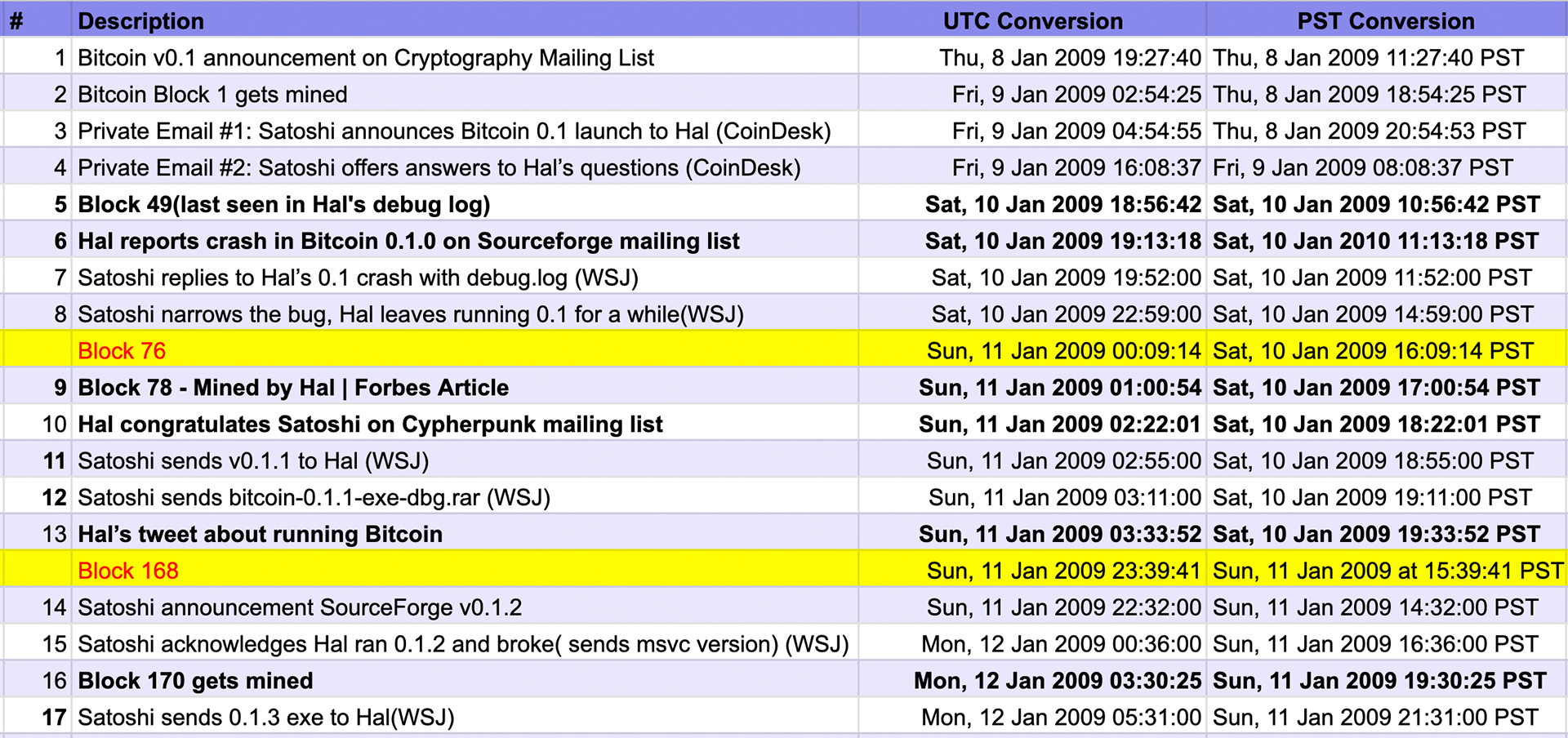
| # | Description | UTC Conversion | PST Conversion |
|---|---|---|---|
| 1 | Bitcoin v0.1 announcement on Cryptography Mailing List | Thu, 8 Jan 2009 19:27:40 | Thu, 8 Jan 2009 11:27:40 PST |
| 2 | Bitcoin Block 1 gets mined | Fri, 9 Jan 2009 02:54:25 | Thu, 8 Jan 2009 18:54:25 PST |
| 3 | Private Email #1: Satoshi announces Bitcoin 0.1 launch to Hal (CoinDesk) | Fri, 9 Jan 2009 04:54:55 | Thu, 8 Jan 2009 20:54:53 PST |
| 4 | Private Email #2: Satoshi offers answers to Hal’s questions (CoinDesk) | Fri, 9 Jan 2009 16:08:37 | Fri, 9 Jan 2009 08:08:37 PST |
| 5 | Block 49 (last seen in Hal’s debug log) | Sat, 10 Jan 2009 18:56:42 | Sat, 10 Jan 2009 10:56:42 PST |
| 6 | Hal reports crash in Bitcoin 0.1.0 on Sourceforge mailing list | Sat, 10 Jan 2009 19:13:18 | Sat, 10 Jan 2010 11:13:18 PST |
| 7 | Satoshi replies to Hal’s 0.1 crash with debug.log (WSJ) | Sat, 10 Jan 2009 19:52:00 | Sat, 10 Jan 2009 11:52:00 PST |
| 8 | Satoshi narrows the bug, Hal leaves running 0.1 for a while (WSJ) | Sat, 10 Jan 2009 22:59:00 | Sat, 10 Jan 2009 14:59:00 PST |
| Block 76 | Sun, 11 Jan 2009 00:09:14 | Sat, 10 Jan 2009 16:09:14 PST | |
| 9 | Block 78 - Mined by Hal | Forbes Article | Sun, 11 Jan 2009 01:00:54 | Sat, 10 Jan 2009 17:00:54 PST |
| 10 | Hal congratulates Satoshi on Cypherpunk mailing list | Sun, 11 Jan 2009 02:22:01 | Sat, 10 Jan 2009 18:22:01 PST |
| 11 | Satoshi sends v0.1.1 to Hal (WSJ) | Sun, 11 Jan 2009 02:55:00 | Sat, 10 Jan 2009 18:55:00 PST |
| 12 | Satoshi sends bitcoin-0.1.1-exe-dbg.rar (WSJ) | Sun, 11 Jan 2009 03:11:00 | Sat, 10 Jan 2009 19:11:00 PST |
| 13 | Hal’s tweet about running Bitcoin | Sun, 11 Jan 2009 03:33:52 | Sat, 10 Jan 2009 19:33:52 PST |
| Block 168 | Sun, 11 Jan 2009 23:39:41 | Sun, 11 Jan 2009 15:39:41 PST | |
| 14 | Satoshi announcement SourceForge v0.1.2 | Sun, 11 Jan 2009 22:32:00 | Sun, 11 Jan 2009 14:32:00 PST |
| 15 | Satoshi acknowledges Hal ran 0.1.2 and broke (sends msvc version) (WSJ) | Mon, 12 Jan 2009 00:36:00 | Sun, 11 Jan 2009 16:36:00 PST |
| 16 | Block 170 gets mined | Mon, 12 Jan 2009 03:30:25 | Sun, 11 Jan 2009 19:30:25 PST |
| 17 | Satoshi sends 0.1.3 exe to Hal (WSJ) | Mon, 12 Jan 2009 05:31:00 | Sun, 11 Jan 2009 21:31:00 PST |
Even if Dustin joined the network as early as Block 76, that would still place him after Hal, who, as we’ve seen from the private emails, the debug.log file, and the SourceForge mailing list post, was already active just before Block 49.
So based on all the evidence we’ve gathered, it seems that Hal did run Bitcoin before Dustin.
The title asks “Who Was the 1st Bitcoin Miner?”, and given the level of scrutiny we’ve applied so far in our analysis, it only makes sense to keep splitting hairs.
Yes. Provably, Hal still beats Dustin: Hal mined Block 78, while Dustin’s first confirmed block is Block 309.
What I find fascinating though is this:
If Dustin had mined his first block on January 11th, he would have been the first miner after Satoshi, beating Hal by two blocks… but we wouldn’t be able to prove it.
It’s also worth mentioning that in his appearance on the Stephan Livera Podcast (Episode 314), Dustin says that he downloaded the Bitcoin Whitepaper shortly after its release, was eagerly waiting for the software to be published, and ran the Bitcoin client very shortly after it was released.
However he did not realised that the mining function was turned off by default.
Satoshi probably made this decision intentionally: If people ran the software and saw it consuming a lot of CPU, they might have panicked and shut it down.
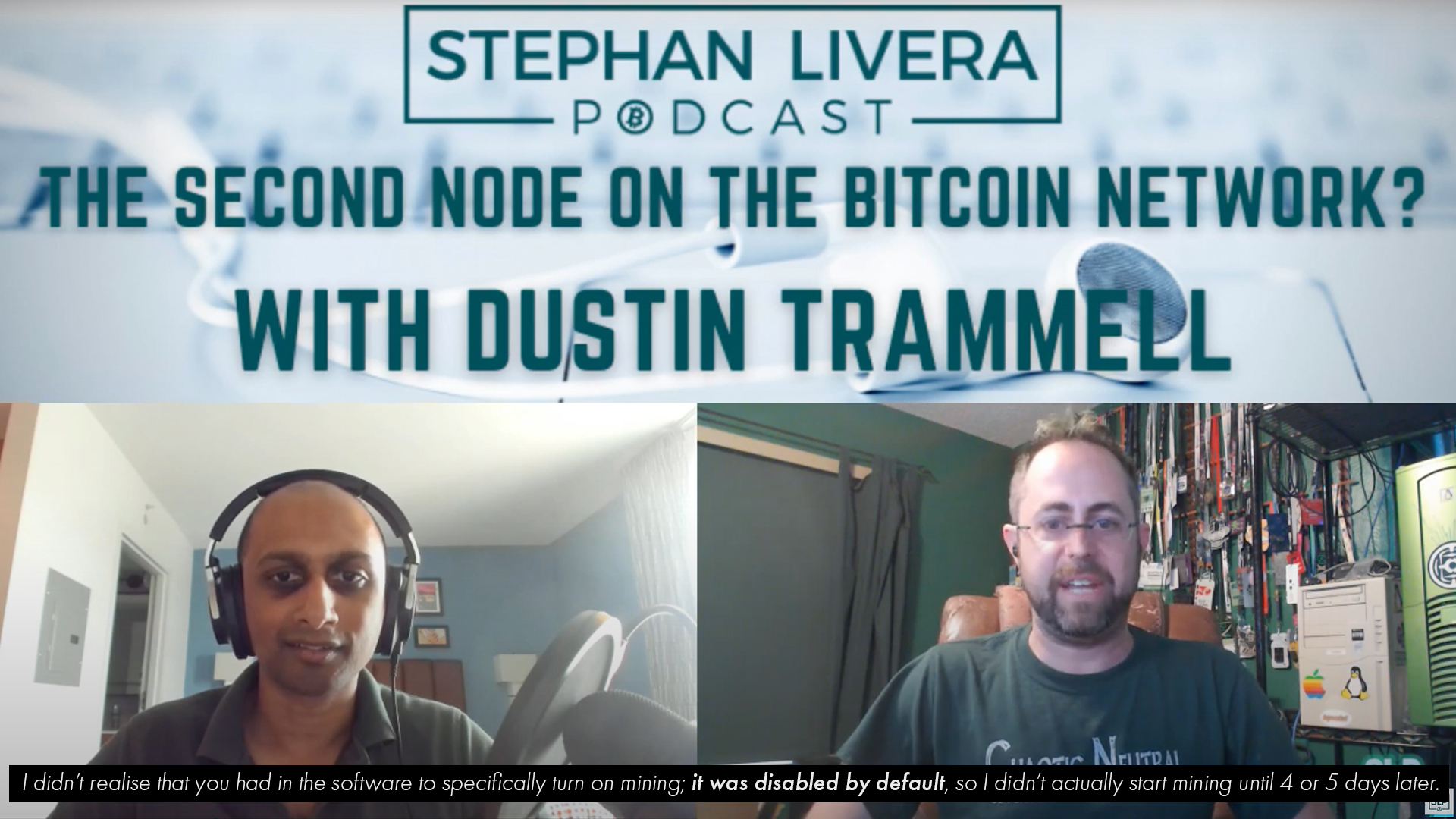
Dustin Trammell: “I didn’t realise that you had in the software to specifically turn on mining; it was disabled by default, so I didn’t start mining until 4 or 5 days later.”
Source: https://youtu.be/rWdUOB_NgOo?si=6cYooCF9m4QeOIQl&t=454
This small default setting explains a lot:
- Why Satoshi was the only miner in the very beginning
- Why others (like Hal and Dustin) ran the client but didn’t mine
- Why, if there were any other early participants, they wouldn’t have left any traces
This matches perfectly with our earlier ExtraNonce analysis — even if others were present, they weren’t mining.
Early Bitcoin Satoshi-Client Peer Discovery
For the sake of accuracy, I want to clarify that the hardcoded IP address Dustin mentioned in his tweet was not Satoshi’s IP, but rather the fallback IP for the Freenode IRC server, as we can see in the code hosted on SourceForge:
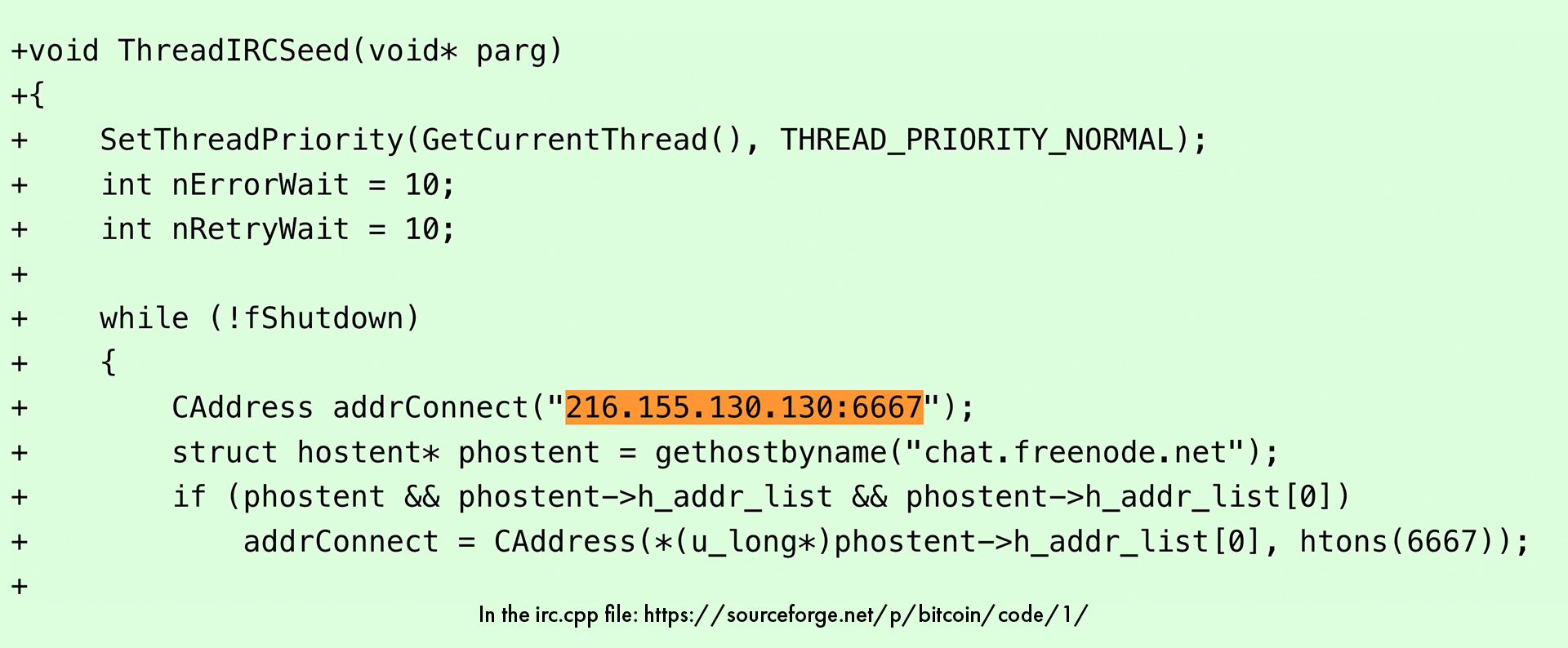
+void ThreadIRCSeed(void* parg)
+{
+ SetThreadPriority(GetCurrentThread(), THREAD_PRIORITY_NORMAL);
+ int nErrorWait = 10;
+ int nRetryWait = 10;
+
+ while (!fShutdown)
+ {
+ CAddress addrConnect("216.155.130.130:6667");
+ struct hostent* phostent = gethostbyname("chat.freenode.net");
+ if (phostent && phostent->h_addr_list && phostent->h_addr_list[0])
+ addrConnect = CAddress(*(u_long*)phostent->h_addr_list[0], htons(6667));
The earliest versions of Bitcoin source code I could find (https://satoshi.nakamotoinstitute.org/code/) are Bitcoin v0.1.1 and Bitcoin v0.1.3. The hash for v0.1.3 match those in the RSS feed from SourceForge (archived on web.archive.org), and neither v0.1.1 nor v0.1.3 contains the fallback IP
216.155.130.130inirc.cpp.
The screenshot with the green background is from SourceForge. The earliest accessible version available there is v0.1.5, which is also the earliest version I could find that contains the fallback IRC IP.
This detail doesn’t invalidate any of the other points Dustin made, and it’s an easy thing to mix up.
So what Is the Grand Conclusion?
So in this article, we dethroned Hal Finney from being the 2nd node to join the Bitcoin Network to the 3rd node, thus making him the 3rd person also, but then we re-instated him to the 2nd person, as we suspect the Tor node was also Satoshi Nakamoto.
We found out some never-known facts about Bitcoin’s inception, which after all these years is quite something:
- Hal Finney missed Bitcoin’s launch
- Hal Finney joined the Bitcoin network around Block 49
- There were 2 nodes online when he joined; both were Satoshi Nakamoto
- The Bitcoin network halted for 24h and 8h in the first 30 blocks
- In total, Bitcoin halted 8 times in the first 170 blocks
But more importantly, we got a very intimate view of how fragile these early days were, and how Bitcoin barely took off.
But anyway, in the grand scheme of things, it doesn’t matter who actually was 1st and who was 2nd node or miner.
What matters is that there were some people at this very early and fragile starting point of Bitcoin who decided to run the Bitcoin Client, and if not for them, Bitcoin may have never taken off.
Here there were all these cryptographers on the Cryptography Mailing List, most of them looking for the next breakthrough, and one day, out of nowhere, an anonymous guy drops one of the biggest inventions/discoveries of the century, and almost everyone ignores it!
But for some reason, Dustin and Hal looked at this strange project that promised so much, without any trace of cynicism, and judged it for what it is.
They saw Bitcoin as Bitcoin, not as “Bitcoin made by this strange Satoshi character.”
And because of this very simple and honest gesture, they changed the world and deserve a place in history. And for that, I want to say a very sincere thank you, gentlemen. 🫡
Another important thing to note is that Hal’s debug file was available for 16 years, and the emails for 10, and yet no one bothered to look at them. Even when Dustin himself mentioned he was the 1st, only 100 people took interest in the tweet.
So if you take anything from this very long article, I hope it is this: ALWAYS verify what other people are saying. And next time you encounter a strange new idea that makes big promises — be like Hal and Dustin. You may just change the world yourself.
P.S. I hope this also puts to rest all the theories that Bitcoin was started by three-letter agencies, aliens, AI, aliens with AI, a group of people, etc. It looks an awful lot like a guy who wrote some code, put it on the internet, and made all the chaotic mistakes that come with it.
If you found this article valuable, please consider making a donation.
It took about 3.5 months to research and write the article, plus another month to put together the website, clean up the formatting, and create a scrappable data section to make it easier for people to re-use my work.
All of my content is free, and I always go the extra mile to keep things thorough, sourced, and easy to navigate.
- LN:
sappybeggar14@walletofsatoshi.com - On-chain:
bc1q5kaj2fyps8sqhdmf99kzzzvz45qyu7zzhjzh2r - Dirty-fiat:
buymeacoffee.com/alexwaltz
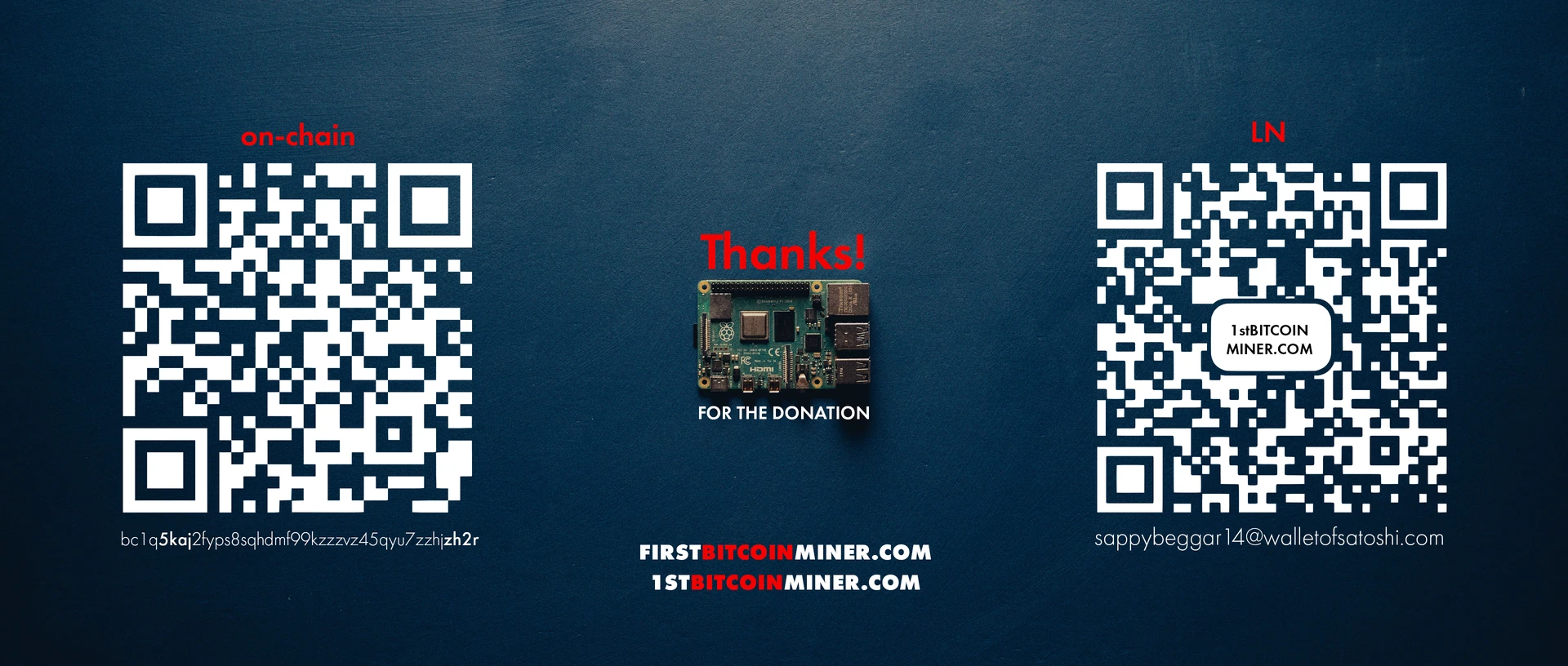
I would like to thank the following people, who have contributed directly or indirectly to this research. Without my interactions with them(or their work), this article would not exist in its current form.